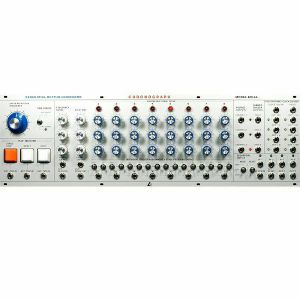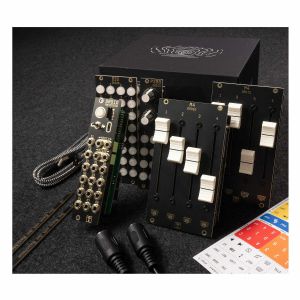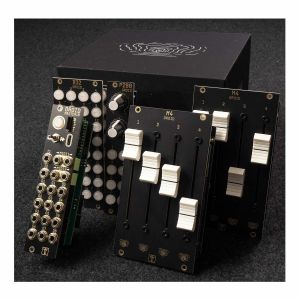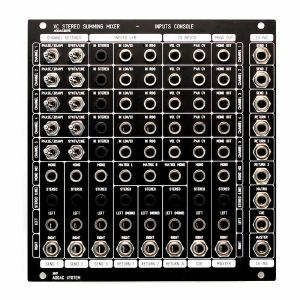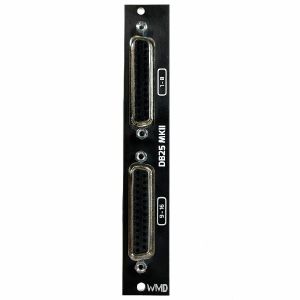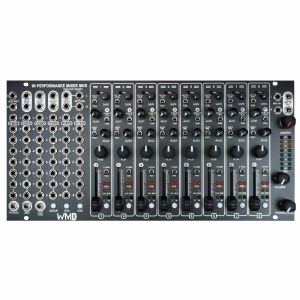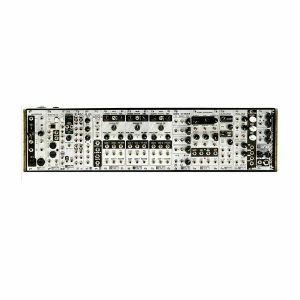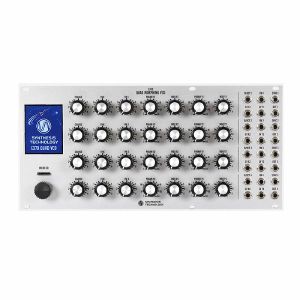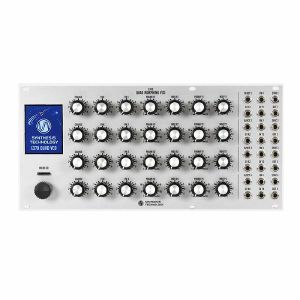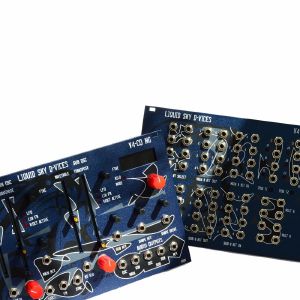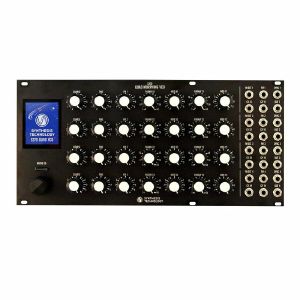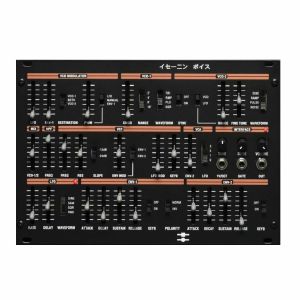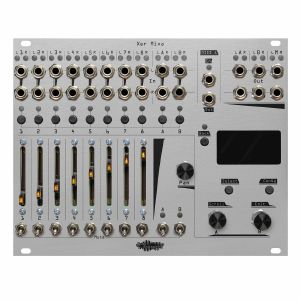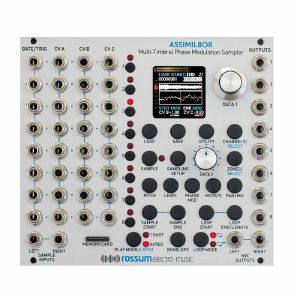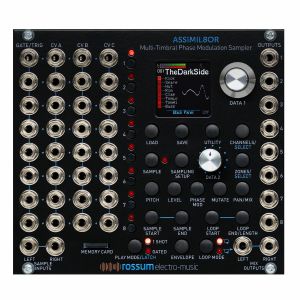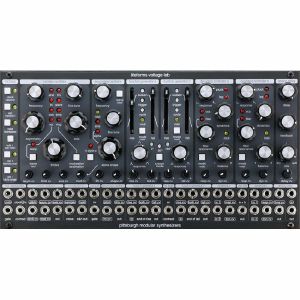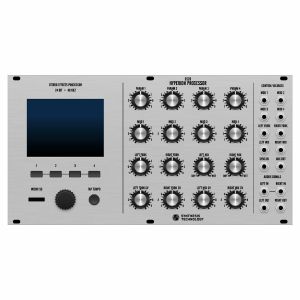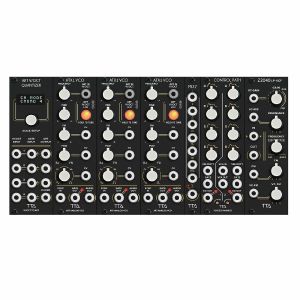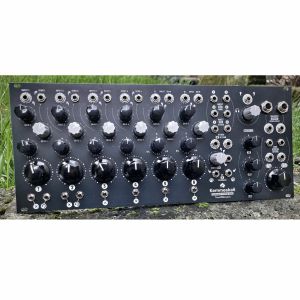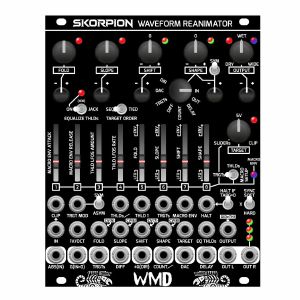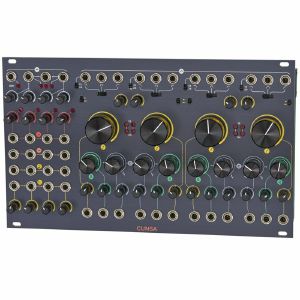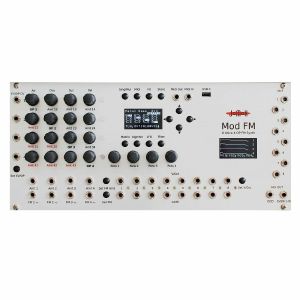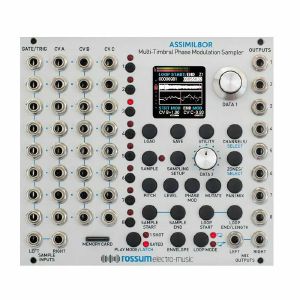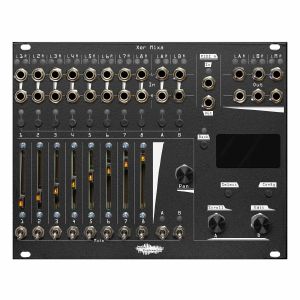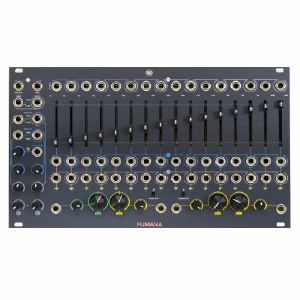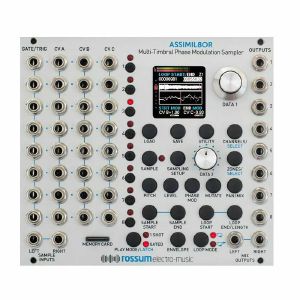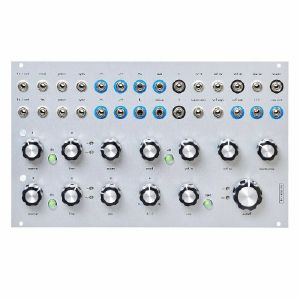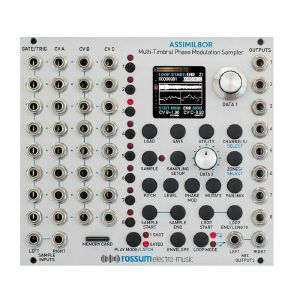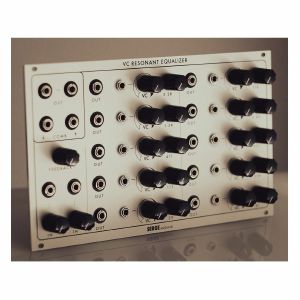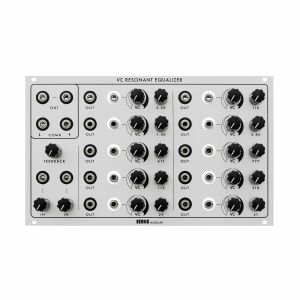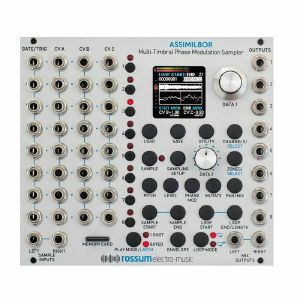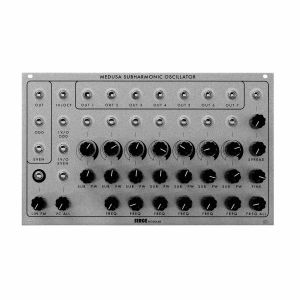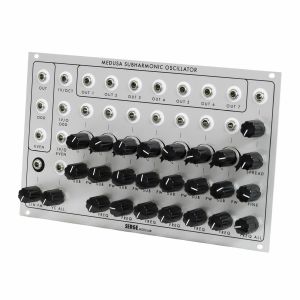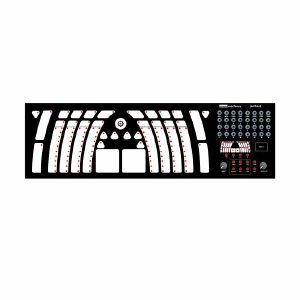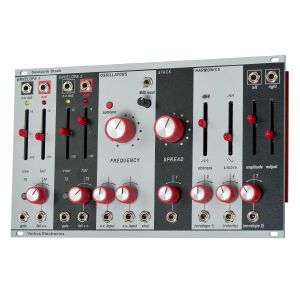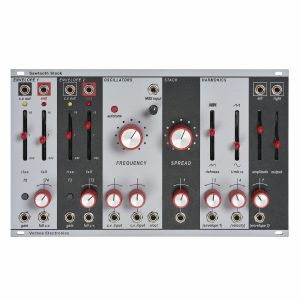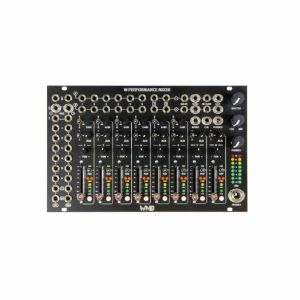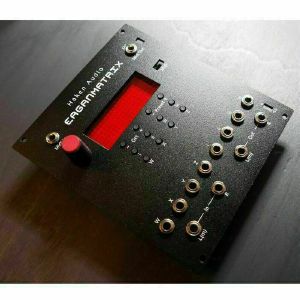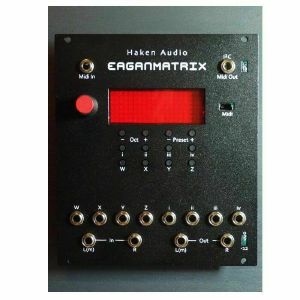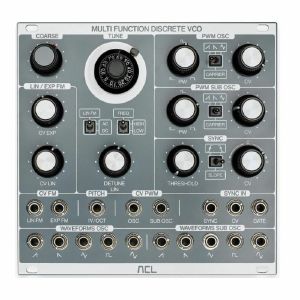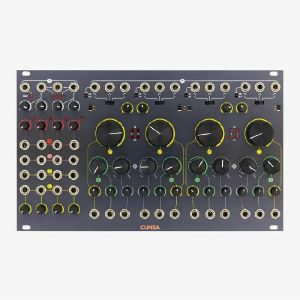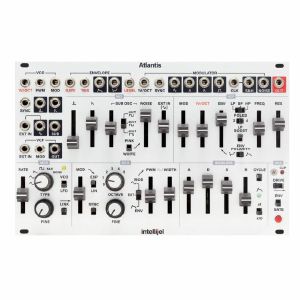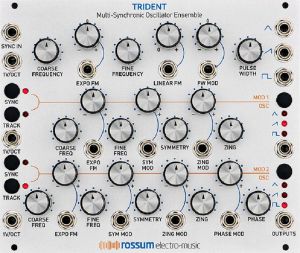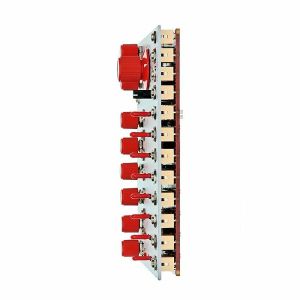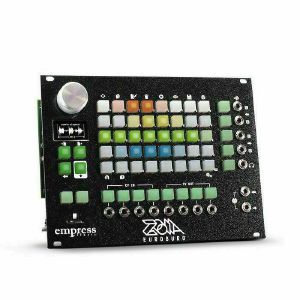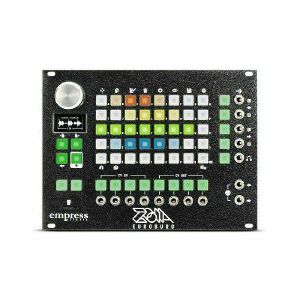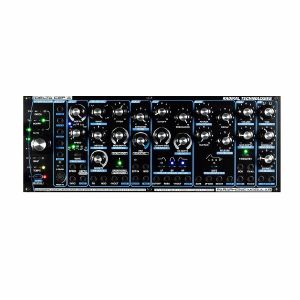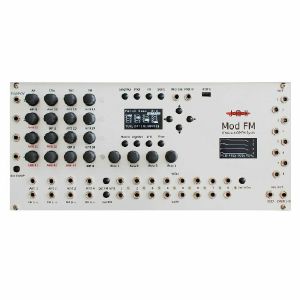Endorphin.es BLCK Shuttle Full System Modular Synthesiser With Decksaver Cover & Adhesive Strip (black faceplate) (modular synthesiser)
Cat: 714534 Rel: 22 Jan 19
Complete modular synthesiser system with protective cover & adhesive strip
Notes: The Shuttle System is a versatile modular setup, capable of generating classical as well as experimental sounds. It comes with a cover and adhesive strip for protecting the system from dust and to carry it around.
The synthesiser is composed of two Buchla style oscillators plus Waveshaper, two function generators, which can be used as envelopes, LFOs or additional VCOs, two filters respectively low pass gates with eight modes of operation and an effects processor.
Furthermore, a mono/stereo mixer with inserts and ducking compressor, utility circuits and a tune section are included. To control all those components, the instrument features an extensively equipped MIDI CV interface. Consequently, the Shuttle System is able to create an extremely wide range of high quality sounds.
The following modules are included in the Shuttle System:
Endorphin.es Cockpit:
The Cockpit is a performance mixer with 4 stereo channels, two channels of send and return to use iOS devices for signal processing (via a 4-pin TRRS cable) and also comes with an integrated compressor with sidechain input.
Endorphin.es Furthrrrr Generator:
The Furthrrrr Generator is a complex, completely analog oscillator inspired by the Buchla 259.
Endorphin.es Gateway:
Gateway is an expander for Endorhin.es Terminal which expands the envelope possibilities, with an integrated autotune-function for VCOs.
Endorphin.es Grand Terminal:
The Grand Terminal is a digital multipurpose module. Its two function generators can be used as envelopes, LFOs or VCOs. The 2 filter channels individually offer 8 modes of operation, and combined with its mixing and routing capabilities and a multi effects unit, it is not only a complete back end of a synth voice, but can also be used as a synthesiser voice, stereo filter bank or general purpose sound effects processor.
Endorphin.es Shuttle Control:
Shuttle Control is a freely configurable converter from USB-MIDI to CV/gate/clock with16 outputs. Use the USB sockets to connect a USB keyboard and the "to device" micro USB connector to hook up a tablet or PC/Mac with controller software which doesn't have to be capable of MIDI. Furthermore it can be used as power supply and distribution and internal MIDI/CV-bus for a small modular system.
Decksaver for Shuttle System:
- Closes patched
- Fits any screws
- Fits any Frap Tools 2x Plus (84 hp) cases with customs Shuttle sides (available as a kit as well)
- Secured with adhesive strip
… Read moreThe synthesiser is composed of two Buchla style oscillators plus Waveshaper, two function generators, which can be used as envelopes, LFOs or additional VCOs, two filters respectively low pass gates with eight modes of operation and an effects processor.
Furthermore, a mono/stereo mixer with inserts and ducking compressor, utility circuits and a tune section are included. To control all those components, the instrument features an extensively equipped MIDI CV interface. Consequently, the Shuttle System is able to create an extremely wide range of high quality sounds.
The following modules are included in the Shuttle System:
Endorphin.es Cockpit:
The Cockpit is a performance mixer with 4 stereo channels, two channels of send and return to use iOS devices for signal processing (via a 4-pin TRRS cable) and also comes with an integrated compressor with sidechain input.
Endorphin.es Furthrrrr Generator:
The Furthrrrr Generator is a complex, completely analog oscillator inspired by the Buchla 259.
Endorphin.es Gateway:
Gateway is an expander for Endorhin.es Terminal which expands the envelope possibilities, with an integrated autotune-function for VCOs.
Endorphin.es Grand Terminal:
The Grand Terminal is a digital multipurpose module. Its two function generators can be used as envelopes, LFOs or VCOs. The 2 filter channels individually offer 8 modes of operation, and combined with its mixing and routing capabilities and a multi effects unit, it is not only a complete back end of a synth voice, but can also be used as a synthesiser voice, stereo filter bank or general purpose sound effects processor.
Endorphin.es Shuttle Control:
Shuttle Control is a freely configurable converter from USB-MIDI to CV/gate/clock with16 outputs. Use the USB sockets to connect a USB keyboard and the "to device" micro USB connector to hook up a tablet or PC/Mac with controller software which doesn't have to be capable of MIDI. Furthermore it can be used as power supply and distribution and internal MIDI/CV-bus for a small modular system.
Decksaver for Shuttle System:
- Closes patched
- Fits any screws
- Fits any Frap Tools 2x Plus (84 hp) cases with customs Shuttle sides (available as a kit as well)
- Secured with adhesive strip
out of stock $2,280.21
SynthRotek MST SYSTEM 104 Analogue Modular Synthesiser System (modular synthesiser system)
Cat: 778516 Rel: 28 May 21
analog modular synthesiser
Notes: SynthRotek's biggest and most powerful MST system is a polyphonic powerhouse. Classic East Coast-style subtractive setup with three VCOs and extensive MIDI control options.
Supplier's Notes:
Housed in Synthrotek's 104HP Skiff Boat, the MST SYSTEM 104 is a very powerful analog polyphonic FULLY modular synthesizer.
Powered by Synthrotek's Case Power Red, the MST SYSTEM 104 has the following power specs: +12V @ 2A, -12V @ 500mA, +5V @ 1.5A
Modules:
MST Expressor
MST MIDI to CV Converter
MST MIDI to CV Expander
MST Ribbon Controller
MST '07 Buffered Multiple
MST VC LFO
MST Noise Sample and Hold / Track and Hold
MST VCO (x 3)
MST 4-Channel Audio/CV Mixer
MST Dual Envelope
MST Low Pass Filter
MST Dual VCA
VERB
MST Stereo Output Mixer
… Read moreSupplier's Notes:
Housed in Synthrotek's 104HP Skiff Boat, the MST SYSTEM 104 is a very powerful analog polyphonic FULLY modular synthesizer.
Powered by Synthrotek's Case Power Red, the MST SYSTEM 104 has the following power specs: +12V @ 2A, -12V @ 500mA, +5V @ 1.5A
Modules:
MST Expressor
MST MIDI to CV Converter
MST MIDI to CV Expander
MST Ribbon Controller
MST '07 Buffered Multiple
MST VC LFO
MST Noise Sample and Hold / Track and Hold
MST VCO (x 3)
MST 4-Channel Audio/CV Mixer
MST Dual Envelope
MST Low Pass Filter
MST Dual VCA
VERB
MST Stereo Output Mixer
out of stock $2,015.78
LA Circuits EM-6A Chronograph Sequential Rhythm Generator Module (eurorack sequencer module)
Cat: 816046
Sequencer eurorack module
Notes: The EM-6A Chronograph Sequential Rhythm Generator is the result of two years of in-depth research of analog vintage step sequencers. This device features:
Three rows of 8-step CV generators with individual CV ranges and CV outputs for each row.
Illuminated Start/Stop, Skip and Reset buttons with independent CV inputs.
Internal clock with external CV input and clock output. External clock input with manual step functionality.
Pulse output functionality.
LED lamp indicators for each step position.
LED lamp indicators to illuminate trigger status.
A versatile frequency detector and divider circuit, which generates square wave signals derived from the frequency transmitted to its signal input jack.
The divider section provides five outputs and five corresponding LED indicator for visual representation of the output rhythmic patterns.
A sequential switch section, allowing the user to select a specific input to be routed to a specific module chain. This process may be accomplished via clock or via manual switching.
Specifications:
Dimensions: 84 HP (3U)
Panel: 2.00 mm Anodized Aluminum
Power: +/- 12V | 94 mA
… Read moreThree rows of 8-step CV generators with individual CV ranges and CV outputs for each row.
Illuminated Start/Stop, Skip and Reset buttons with independent CV inputs.
Internal clock with external CV input and clock output. External clock input with manual step functionality.
Pulse output functionality.
LED lamp indicators for each step position.
LED lamp indicators to illuminate trigger status.
A versatile frequency detector and divider circuit, which generates square wave signals derived from the frequency transmitted to its signal input jack.
The divider section provides five outputs and five corresponding LED indicator for visual representation of the output rhythmic patterns.
A sequential switch section, allowing the user to select a specific input to be routed to a specific module chain. This process may be accomplished via clock or via manual switching.
Specifications:
Dimensions: 84 HP (3U)
Panel: 2.00 mm Anodized Aluminum
Power: +/- 12V | 94 mA
out of stock $1,737.90
Der Mann Mit Der Maschine Moto Kit Performance Sequencer Module Bundle (sequencer modules)
Cat: 1013069 Rel: 11 Jun 24
Performance sequencer module bundle: MASTER18, P2B8, B32 & 2x M4's
Notes: Selection of five Droid sequencer modules for Eurorack, including MASTER18 master module, two M4 motor fader controllers, a P2B8 controller and a B32 controller. Excellent value for a comprehensive package.
Supplier's Notes:
This kit is two things at once:
1. A full featured total innovative musical performance sequencer controlled by motor faders and haptic feedback.
2. A powerful self contained Droid setup with motor faders that can do and can be anything - at a very good set price.
The sequencer
Let's talk about the sequencer first! In the configuration that it is shipped, it has four independent tracks, each controlling one voice, either via CV/Gate plus extra modulation CV, or via MIDI. MIDI connectivity is provided with two DIN/TRS (mini jack) outputs and one USB port. In our free software "Droid Forge" for Windows and Mac there is a tool called "patch generator", which allows you to not only configure the MIDI routings but also decide about the feature set and even the button layout.
The modules come all prepared so that within a few minutes the sequencer is setup and ready to go. Once your are satisfied with your configuration, you can use the include stickers to label the buttons of your modules (as shown in the images).
This Droid motor fader sequencer is very unique and innovative in many ways. Most importantly the direct control with the motor faders makes it stand out. The big faders allow easy instant control and real "playing". In the normal mode, each fader represents one step in the sequence. With eight fingers you can change eight notes at once.
When you switch to another track or to another function within the track (e.g. to the velocity / modulation CV), all faders immediately move to the correct position of these settings, so you can immediately see what's going on and change the values without any "pickup", as is necessary for sequencers with normal sliders.
When you edit alues that are stepped in nature - first of all the selected notes of the scale - the faders use ther tiny motors to give you haptic feedback! For every note you feel a little notch. You can change by say exactly two notes by feeling the notches and don't need any display for hitting the correct note.
Musical functions
The Droid motor fader sequencer is built to improvise and play music, for being creative, finding new melodies, and everything right in the moment - a perfect tool for live performances, but also for jamming and recording in the studio and get inspired. It does this not only by its unique haptic interface but also by including lots of interesting musical features and algorithms - all of them accessible by a single button press.
Chord note selection: Use seven buttons (on the P2B8) to select those notes from the scale that are allowed. Play with these buttons to temporarily make a melody simpler and more complex, again. Or change its harmonic structure but removing the root and third and add the ninth or 13th. Since all seven notes are part of the scale, you can never go astray, however. You will always by "in tune", even without any knowledge of music theory.
Diatonic transposition: Shift up and down a melody by a number of notes - within the scale and within the selected notes. One simple movement of a fader brings a great and refreshing alteration to your melody. Touch one button and you are back to normal.
Built-in arpeggiator: Press one button to switch from the sequenced melody to an algorithmically created melody - based on the same scale and selected chord notes. More than different controls change the played pattern - all of them can be combined, which creates millions of melodies - without any randomness!
Pitch accumulator: The note of one step moves up or down within the scale by one or two notes every cycle of the sequence. So with just one little setting, you can create a 32 step melody from just 8 steps.
Conditional gates: For example play a step just every second time. This doubles the length of the sequence and creates musical variations - without need of randomness.
Mini arpeggiator for reapeats and ratches: Make every repeat of a step (you can repeat each step up to 16 times) use a different note. Similar for the ratchets (ratchets divide a step into multiple faster sub-steps).
Inversion: Press just one button and lower notes get higher and higher notes get lower - like a vertical mirror of your melody.
Forms like AAAB and AABB: Split up your melody into two halves - for example 16 steps are split into 8 and 8. The first half is called A, the second half is B. Now A is played three times, than once B. So the essential length of the melody is double, in a very musical way.
Activity: For each step select an activity level that is needed for the step to be played. Then with a global fader you select the activity. This allows you to make your melody more sparse or more complex - in a very controlled way and again without any randomness.
Autoreset: Restart the sequence after a fixed number of clock cycles. This is done with one fader with virtual notches.
Shift steps: Again with one fader, rotate all steps. The changes the musical timing of your melody in relation to the rest of the tracks. Again this can be undone with one flip of a fader.
Transpose by root: When this is turned on, your melody is transposed along with the root note whenever that changes.
Contents of the Moto Kit
The Moto Kit is a selection of five Droid modules. Even if you don't need a sequencer, you get these modules for a very good price as set. Or maybe your start with the sequencer but then use the free Droid Force software to change the configuration, change some of its features, add new features. Droid is a super flexible universal CV processor that is not limited to sequencing!
The Moto Kit contains the following ingredients:
MASTER18
P2B8 controller (special Moto Kit edition with red LED in button 8)
B32 controller (special Moto Kit edition with various coloured LEDs)
2x M4 motor fader controller
2x MIDI TRS-DIN adapters (type B, matching MASTER18)
USB-A to USB-C cable
All necessary ribbon cables for power and controller connection, of course.
One addition 80 cm controller cable in case you want to put the MASTER18 at a different place in your rack.
Micro SD card with standard start patch in MASTER18
Extra SD card with Motor Fader sequencer (put this into your MASTER18 to use the sequencer)
SD card reader
Folded cheat sheet for the Motor fader sequencer
3x Sticker sheet for the sequencer (three times, so you can rearrange things later if you like)
2x 1HP blind plates (if you can afford the extra space, it is recommended that you put one after MASTER18 and one between the B32 and the M4s)
… Read moreSupplier's Notes:
This kit is two things at once:
1. A full featured total innovative musical performance sequencer controlled by motor faders and haptic feedback.
2. A powerful self contained Droid setup with motor faders that can do and can be anything - at a very good set price.
The sequencer
Let's talk about the sequencer first! In the configuration that it is shipped, it has four independent tracks, each controlling one voice, either via CV/Gate plus extra modulation CV, or via MIDI. MIDI connectivity is provided with two DIN/TRS (mini jack) outputs and one USB port. In our free software "Droid Forge" for Windows and Mac there is a tool called "patch generator", which allows you to not only configure the MIDI routings but also decide about the feature set and even the button layout.
The modules come all prepared so that within a few minutes the sequencer is setup and ready to go. Once your are satisfied with your configuration, you can use the include stickers to label the buttons of your modules (as shown in the images).
This Droid motor fader sequencer is very unique and innovative in many ways. Most importantly the direct control with the motor faders makes it stand out. The big faders allow easy instant control and real "playing". In the normal mode, each fader represents one step in the sequence. With eight fingers you can change eight notes at once.
When you switch to another track or to another function within the track (e.g. to the velocity / modulation CV), all faders immediately move to the correct position of these settings, so you can immediately see what's going on and change the values without any "pickup", as is necessary for sequencers with normal sliders.
When you edit alues that are stepped in nature - first of all the selected notes of the scale - the faders use ther tiny motors to give you haptic feedback! For every note you feel a little notch. You can change by say exactly two notes by feeling the notches and don't need any display for hitting the correct note.
Musical functions
The Droid motor fader sequencer is built to improvise and play music, for being creative, finding new melodies, and everything right in the moment - a perfect tool for live performances, but also for jamming and recording in the studio and get inspired. It does this not only by its unique haptic interface but also by including lots of interesting musical features and algorithms - all of them accessible by a single button press.
Chord note selection: Use seven buttons (on the P2B8) to select those notes from the scale that are allowed. Play with these buttons to temporarily make a melody simpler and more complex, again. Or change its harmonic structure but removing the root and third and add the ninth or 13th. Since all seven notes are part of the scale, you can never go astray, however. You will always by "in tune", even without any knowledge of music theory.
Diatonic transposition: Shift up and down a melody by a number of notes - within the scale and within the selected notes. One simple movement of a fader brings a great and refreshing alteration to your melody. Touch one button and you are back to normal.
Built-in arpeggiator: Press one button to switch from the sequenced melody to an algorithmically created melody - based on the same scale and selected chord notes. More than different controls change the played pattern - all of them can be combined, which creates millions of melodies - without any randomness!
Pitch accumulator: The note of one step moves up or down within the scale by one or two notes every cycle of the sequence. So with just one little setting, you can create a 32 step melody from just 8 steps.
Conditional gates: For example play a step just every second time. This doubles the length of the sequence and creates musical variations - without need of randomness.
Mini arpeggiator for reapeats and ratches: Make every repeat of a step (you can repeat each step up to 16 times) use a different note. Similar for the ratchets (ratchets divide a step into multiple faster sub-steps).
Inversion: Press just one button and lower notes get higher and higher notes get lower - like a vertical mirror of your melody.
Forms like AAAB and AABB: Split up your melody into two halves - for example 16 steps are split into 8 and 8. The first half is called A, the second half is B. Now A is played three times, than once B. So the essential length of the melody is double, in a very musical way.
Activity: For each step select an activity level that is needed for the step to be played. Then with a global fader you select the activity. This allows you to make your melody more sparse or more complex - in a very controlled way and again without any randomness.
Autoreset: Restart the sequence after a fixed number of clock cycles. This is done with one fader with virtual notches.
Shift steps: Again with one fader, rotate all steps. The changes the musical timing of your melody in relation to the rest of the tracks. Again this can be undone with one flip of a fader.
Transpose by root: When this is turned on, your melody is transposed along with the root note whenever that changes.
Contents of the Moto Kit
The Moto Kit is a selection of five Droid modules. Even if you don't need a sequencer, you get these modules for a very good price as set. Or maybe your start with the sequencer but then use the free Droid Force software to change the configuration, change some of its features, add new features. Droid is a super flexible universal CV processor that is not limited to sequencing!
The Moto Kit contains the following ingredients:
MASTER18
P2B8 controller (special Moto Kit edition with red LED in button 8)
B32 controller (special Moto Kit edition with various coloured LEDs)
2x M4 motor fader controller
2x MIDI TRS-DIN adapters (type B, matching MASTER18)
USB-A to USB-C cable
All necessary ribbon cables for power and controller connection, of course.
One addition 80 cm controller cable in case you want to put the MASTER18 at a different place in your rack.
Micro SD card with standard start patch in MASTER18
Extra SD card with Motor Fader sequencer (put this into your MASTER18 to use the sequencer)
SD card reader
Folded cheat sheet for the Motor fader sequencer
3x Sticker sheet for the sequencer (three times, so you can rearrange things later if you like)
2x 1HP blind plates (if you can afford the extra space, it is recommended that you put one after MASTER18 and one between the B32 and the M4s)
out of stock $1,563.10
ADDAC System ADDAC807A&B VC Stereo Summing Mixer Console & Inputs Console Module (attenuator/dynamics/mixer/panning/VCA/expander synth module)
Cat: 776434 Rel: 08 Sep 20
VC stereo summing mixer module, main console and inputs console in 80HP.
Notes: All you could ever dream of from an Eurorack console, and then some!
The ADDAC807A VC Stereo Summing Mixer offers you the power, the flexibility and the gorgeous layout of a high-end audio console, in the popular Eurorack format. Starting off at 5 stereo channels, with the option to add 4 additional stereo channels via the ADDAC807C Expansion Console, its send/return options and clever matrix will ensure you have that perfect mix down in seconds. Customary to ADDAC System designs, there is enough CV control and hands-on switch options to make the ADDAC807A into an instrument in and of itself.
The ADDAC807A is accompanied by its sibling, the ADDAC807B Inputs Console. We decided to allow the user to freely define the placement of the jacks by separating the area where all your cables are located. Less clutter means more hands-on control and higher playability. The ADDAC807B Inputs Console holds all the jack inputs for the ADDAC807A Main Console, along with CV inputs and additional channel settings - 'cause you can never have enough switches!?
Module is sold together with the ADDAC807A, which also provides power. ADDAC807A price is for both the 807A and 807B.
… Read moreThe ADDAC807A VC Stereo Summing Mixer offers you the power, the flexibility and the gorgeous layout of a high-end audio console, in the popular Eurorack format. Starting off at 5 stereo channels, with the option to add 4 additional stereo channels via the ADDAC807C Expansion Console, its send/return options and clever matrix will ensure you have that perfect mix down in seconds. Customary to ADDAC System designs, there is enough CV control and hands-on switch options to make the ADDAC807A into an instrument in and of itself.
The ADDAC807A is accompanied by its sibling, the ADDAC807B Inputs Console. We decided to allow the user to freely define the placement of the jacks by separating the area where all your cables are located. Less clutter means more hands-on control and higher playability. The ADDAC807B Inputs Console holds all the jack inputs for the ADDAC807A Main Console, along with CV inputs and additional channel settings - 'cause you can never have enough switches!?
Module is sold together with the ADDAC807A, which also provides power. ADDAC807A price is for both the 807A and 807B.
out of stock $1,455.53
WMD Performance Mixer MKII 8-Channel Mixer Module (mixer synth module)
Cat: 1021187 Rel: 18 Mar 25
8-channel mixer module - 50HP
Notes: Updated version of WMD's exceptional performance mixer. Full stereo design with improved sound quality, revised layout and increased expandability. An even better version of what was already one of the best mixing solutions in Eurorack.
Supplier's Notes:
Enter the WMD Performance Mixer MKII - Eight years after the MKI was released, the MKII builds on all the valuable feedback received. This is a serious upgrade, with feature enhancements and engineering improvements affecting every bit of the design.
Decisions, decisions, decisions!
If you recall, WMD showed a previous version of the PM MKII a year ago. That version was very similar to the original, with a few enhancements. Primarily focused on manufacturability and overall noise floor with some great recording features. WMD moved to an 8-layer board, replaceable channel strips, developed the MIDI and bootloader, pre/post fader headers, and made it work on both AUXs simultaneously.
Noise Performance - The MKI was alright with noise, there was a little bleed too. Going to 8-layer boards meant I could put ground planes between trace layers, and spread the traces out triple the spacing of what they were on the MKI, this reduces bleed/crosstalk by a factor of about six.
Noise Performance 2 - On the Original, the Level VCA was before the Panning VCAs, which saved on parts/power, but it meant that the Panning VCAs were always connected to the mix bus, adding noise floor that couldn't be attenuated. Making all the channels stereo and putting the Pan circuit first eliminated this problem, now the noise add is controlled by the fader. This did force WMD to make every channel stereo, so the design got simpler through figuring this out.
Panning / Crossfader - The above panning/level improvement made it possible to convert the Pan control into a crossfader, buy simply routing the post pan signals through a switch to the opposing channel, summed at the Level control. This huge improvement allowed the A/&/B input switching scheme to still work on the PM MKII, a bit differently, but it's there in spirit.
Modular Design - The channel strips are all now stereo, and identical, which makes assembly much easier, and lowers the cost. It also makes replacing them easier should a mechanical part fail or get spilled into. Further, the Patchbay, Power board, and Master section are all separate parts, so if there's a failure, they can be quickly swapped without having to RMA the whole unit.
Patchbay - The MKI and rev E MKII still had jacks misaligned with channels. This was a source of frustration for d many users of the PM MKI. And I decided to just be done with it. It didn't make sense to try to put jacks over the channel, it wasted too much space on the panel... So all the jacks go left, keeping the mixer clear of cables, this let me space the knobs out a bit to take up all 3U. It's cleaner, simpler to make, and intuitive to use.
Expandability - It's super modular now, the DB25 can connect to any two headers that spits out audio, they're all the same format across PM MKII and Channels MKII. Pre, post, mixes, connect it however you want. And the connectors can't be hooked to power, meaning no more blown opamps and RMAs to the factory. They're all shrouded too so they won't get bent in shipping!
Features Overview:
Everything is stereo. Inputs, Busses, Auxes, and Cue Mix.
INPUTS: IN LEFT is normalled to IN RIGHT.
GAIN: Each channel has a Gain trim range of -12dB to +20dB, this will let you use line level devices easily.
GAIN CLIP LED: lights red 1dB before clipping the input stage.
LVL FADER: smooth intuitive curve for easily adjusting the mix level on the fly. A yellow indicator shows the level.
MUTE: Press the channel button and the channel will soft mute with a red LED indicator.
… Read moreSupplier's Notes:
Enter the WMD Performance Mixer MKII - Eight years after the MKI was released, the MKII builds on all the valuable feedback received. This is a serious upgrade, with feature enhancements and engineering improvements affecting every bit of the design.
Decisions, decisions, decisions!
If you recall, WMD showed a previous version of the PM MKII a year ago. That version was very similar to the original, with a few enhancements. Primarily focused on manufacturability and overall noise floor with some great recording features. WMD moved to an 8-layer board, replaceable channel strips, developed the MIDI and bootloader, pre/post fader headers, and made it work on both AUXs simultaneously.
Noise Performance - The MKI was alright with noise, there was a little bleed too. Going to 8-layer boards meant I could put ground planes between trace layers, and spread the traces out triple the spacing of what they were on the MKI, this reduces bleed/crosstalk by a factor of about six.
Noise Performance 2 - On the Original, the Level VCA was before the Panning VCAs, which saved on parts/power, but it meant that the Panning VCAs were always connected to the mix bus, adding noise floor that couldn't be attenuated. Making all the channels stereo and putting the Pan circuit first eliminated this problem, now the noise add is controlled by the fader. This did force WMD to make every channel stereo, so the design got simpler through figuring this out.
Panning / Crossfader - The above panning/level improvement made it possible to convert the Pan control into a crossfader, buy simply routing the post pan signals through a switch to the opposing channel, summed at the Level control. This huge improvement allowed the A/&/B input switching scheme to still work on the PM MKII, a bit differently, but it's there in spirit.
Modular Design - The channel strips are all now stereo, and identical, which makes assembly much easier, and lowers the cost. It also makes replacing them easier should a mechanical part fail or get spilled into. Further, the Patchbay, Power board, and Master section are all separate parts, so if there's a failure, they can be quickly swapped without having to RMA the whole unit.
Patchbay - The MKI and rev E MKII still had jacks misaligned with channels. This was a source of frustration for d many users of the PM MKI. And I decided to just be done with it. It didn't make sense to try to put jacks over the channel, it wasted too much space on the panel... So all the jacks go left, keeping the mixer clear of cables, this let me space the knobs out a bit to take up all 3U. It's cleaner, simpler to make, and intuitive to use.
Expandability - It's super modular now, the DB25 can connect to any two headers that spits out audio, they're all the same format across PM MKII and Channels MKII. Pre, post, mixes, connect it however you want. And the connectors can't be hooked to power, meaning no more blown opamps and RMAs to the factory. They're all shrouded too so they won't get bent in shipping!
Features Overview:
Everything is stereo. Inputs, Busses, Auxes, and Cue Mix.
INPUTS: IN LEFT is normalled to IN RIGHT.
GAIN: Each channel has a Gain trim range of -12dB to +20dB, this will let you use line level devices easily.
GAIN CLIP LED: lights red 1dB before clipping the input stage.
LVL FADER: smooth intuitive curve for easily adjusting the mix level on the fly. A yellow indicator shows the level.
MUTE: Press the channel button and the channel will soft mute with a red LED indicator.
3 in stock $1,454.41
Click for better price!
or call +44 20 7424 1960
quote 1021187
quote 1021187
SynthRotek MST SYSTEM 104 Analogue Modular Synthesiser System (B-STOCK) (modular synthesiser system)
Cat: 848312 Rel: 28 May 21
B-STOCK: Box opened, product unused & in perfect condition
Notes: ***B-STOCK: Box opened, product unused & in perfect condition***
SynthRotek's biggest and most powerful MST system is a polyphonic powerhouse. Classic East Coast-style subtractive setup with three VCOs and extensive MIDI control options.
Supplier's Notes:
Housed in Synthrotek's 104HP Skiff Boat, the MST SYSTEM 104 is a very powerful analog polyphonic FULLY modular synthesizer.
Powered by Synthrotek's Case Power Red, the MST SYSTEM 104 has the following power specs: +12V @ 2A, -12V @ 500mA, +5V @ 1.5A
Modules:
MST Expressor
MST MIDI to CV Converter
MST MIDI to CV Expander
MST Ribbon Controller
MST '07 Buffered Multiple
MST VC LFO
MST Noise Sample and Hold / Track and Hold
MST VCO (x 3)
MST 4-Channel Audio/CV Mixer
MST Dual Envelope
MST Low Pass Filter
MST Dual VCA
VERB
MST Stereo Output Mixer
… Read moreSynthRotek's biggest and most powerful MST system is a polyphonic powerhouse. Classic East Coast-style subtractive setup with three VCOs and extensive MIDI control options.
Supplier's Notes:
Housed in Synthrotek's 104HP Skiff Boat, the MST SYSTEM 104 is a very powerful analog polyphonic FULLY modular synthesizer.
Powered by Synthrotek's Case Power Red, the MST SYSTEM 104 has the following power specs: +12V @ 2A, -12V @ 500mA, +5V @ 1.5A
Modules:
MST Expressor
MST MIDI to CV Converter
MST MIDI to CV Expander
MST Ribbon Controller
MST '07 Buffered Multiple
MST VC LFO
MST Noise Sample and Hold / Track and Hold
MST VCO (x 3)
MST 4-Channel Audio/CV Mixer
MST Dual Envelope
MST Low Pass Filter
MST Dual VCA
VERB
MST Stereo Output Mixer
out of stock $1,424.15
Synthesis Technology E370 Quad Morphing VCO Module (silver) (quad/digital/oscillator synth module)
Cat: 757304 Rel: 20 Dec 19
Quad multimode oscillator with a vast array of sonic options
Notes: The Synthesis Technology E370 is a 4-channel DSP-based VCO, 54HP wide module that incorporates features from the E340 Cloud Generator and the E350 Morphing Terrarium (both are discontinued), while adding additional modes from the E352 Cloud Terrarium. It uses 105ma of +12V and 32ma of -12V.
VCO Architecture
Each VCO is independent in the E370, but the 'pooled CV buss' (see description below) allows sharing of CV and mixing of audio outputs if desired.
The VCO is based upon a unique implementation of wavetable synthesis using 256 fixed-sample-length tables of 16-bit values. Each bank in memory consists of 64 wavetables, in an 8x8 array (like a chessboard). Our proprietary DSP algorithms then allow either smooth or 'glitched' morphing between the wavetables in various ways. The E370 comes with 3 factory banks (192 total waves) and internal FLASH memory to hold 26 user-defined banks. This allows over 1,650 individual wavetables to be accessible. The free, cross-platform WaveEdit program is used to generate and import WAV files to user Banks.
Each VCO has 2 CV inputs with an initial value (called the 'Parameter' or PARM) and the external patched-in CV through an attenuator (the 'Mod'). The external Mod is added to the Parameter setting. Some VCO Modes have more than 2 things to 'wiggle', so you can either:
Use a fixed value from 0-100
Share another CV resource
Colour LCD/Navigation
Everyone hates 'menu-diving'. That's why Synthesis Technology focused on making the most 'shallow' menu system possible. Everything is just 1 or 2 clicks away. No endless screens and pages to remember. The encoder is a mil-spec Grayhill optical encoder with a 25yr typical life. And if it ever needs replacing, it's on a easy to access cable assembly.
The colour LCD lets you customize the color scheme with 64 diffrent colors to pick from.
There are several included 'visual aids' that can be displayed on the LCD:
Each of the 4 VCO's waves/noise modes, updated 20FPS
Lissajous figures, where the X/Y axis are user selectable
Real-time FFT spectra of the audio output when in the 2-op FM mode
Graphical maps of the X and Y PARM CVs
Sharing CV Resources
The factory default state of the E370 is each VCO has 2 PARMs called X and Y. VCO1 has X1 and Y1, VCO2 has X2 and Y2, and so on. However, these are not 'hard' assignments, just the default ones. You can share ANY of the 8 PARMs across 1-4 VCOs. For example, PARM Y3 can be assigned to all 4 VCOs at once, so turning the PARM Y3 knob and the external MOD Y3 CV is fed to every VCO. This voltage can then modulate each VCO in a different way, depending on where you assign it.
User Wavetables and Patch Storage
Loading and storing your own wavetables is via the uSD card interface. The uSD card is NOT REQUIRED to run the E370. It is also used for firmware updates. The free application WaveEdit is used to format the wave data and bank data into the proper format used inside the E370.
The E370 has internal non-volatile memory for storing both User wavetables/Banks and for Patches. A 'Patch' stores the menu settings for all 4 VCOs. There are 16 Patches available, and a Patch can be quickly recalled for live performances.
Audio Output Mixer
The default state of the Mixer is each VCO is full volume and only appears at its own output jack. Using the Mixer screen, each VCO output can be mixed with all the others. This is useful for the Morph + Phase mode, and also during live performance where only 2 audio outs are commonly used. The mixing levels are fixed in log steps: there is no 'CV-controlled mixing' function.
VCO Modes
Although the E370 excels at smooth morphing between wavetables (first introduced in the E350 Morphing Terrarium in 2010), traditional VCO waves such as saws, pure sines, and filtered noise (using a 4-pole resonant lowpass ladder filter) can be selected. Thru-zero, linear FM (in 3 ranges) can be used on not just triangle waves (as in an analog VCO) but with ANY waveshape or any wavetable. Here are all the different modes you can place each VCO in, and remember each VCO can be a different mode.
Morphing - Use 2 CVs to select where in the 8x8 bank of wavetables the output is generated. This is the E350's mode.
Morph + Phase Shifting - used when mixing with another VCO (or driving laser galvos). Wavetable morphing plus a voltage-controlled phase shifter.
Morph + Wavefolder - can you wavefold a wavetable? Sure you can...now.
Cloud Generator - this is an improved E340 mode. Not just saws or sines, but can 'cloud' any wavetable, while morphing. A 'cloud' is a set of detuned copies (the 'supersaw' effect)
2op FM - 2 operator Yamaha FM. Not limited to just sine waves, you can use wavetables as well.
Noise - 6 types of noise plus a resonant, Moog-style ladder filter
Sample Player - a 'lo-fi' sample player that treats the selected Bank as 1 giant WAV sample, with separate Start and Length points under voltage control.
… Read moreVCO Architecture
Each VCO is independent in the E370, but the 'pooled CV buss' (see description below) allows sharing of CV and mixing of audio outputs if desired.
The VCO is based upon a unique implementation of wavetable synthesis using 256 fixed-sample-length tables of 16-bit values. Each bank in memory consists of 64 wavetables, in an 8x8 array (like a chessboard). Our proprietary DSP algorithms then allow either smooth or 'glitched' morphing between the wavetables in various ways. The E370 comes with 3 factory banks (192 total waves) and internal FLASH memory to hold 26 user-defined banks. This allows over 1,650 individual wavetables to be accessible. The free, cross-platform WaveEdit program is used to generate and import WAV files to user Banks.
Each VCO has 2 CV inputs with an initial value (called the 'Parameter' or PARM) and the external patched-in CV through an attenuator (the 'Mod'). The external Mod is added to the Parameter setting. Some VCO Modes have more than 2 things to 'wiggle', so you can either:
Use a fixed value from 0-100
Share another CV resource
Colour LCD/Navigation
Everyone hates 'menu-diving'. That's why Synthesis Technology focused on making the most 'shallow' menu system possible. Everything is just 1 or 2 clicks away. No endless screens and pages to remember. The encoder is a mil-spec Grayhill optical encoder with a 25yr typical life. And if it ever needs replacing, it's on a easy to access cable assembly.
The colour LCD lets you customize the color scheme with 64 diffrent colors to pick from.
There are several included 'visual aids' that can be displayed on the LCD:
Each of the 4 VCO's waves/noise modes, updated 20FPS
Lissajous figures, where the X/Y axis are user selectable
Real-time FFT spectra of the audio output when in the 2-op FM mode
Graphical maps of the X and Y PARM CVs
Sharing CV Resources
The factory default state of the E370 is each VCO has 2 PARMs called X and Y. VCO1 has X1 and Y1, VCO2 has X2 and Y2, and so on. However, these are not 'hard' assignments, just the default ones. You can share ANY of the 8 PARMs across 1-4 VCOs. For example, PARM Y3 can be assigned to all 4 VCOs at once, so turning the PARM Y3 knob and the external MOD Y3 CV is fed to every VCO. This voltage can then modulate each VCO in a different way, depending on where you assign it.
User Wavetables and Patch Storage
Loading and storing your own wavetables is via the uSD card interface. The uSD card is NOT REQUIRED to run the E370. It is also used for firmware updates. The free application WaveEdit is used to format the wave data and bank data into the proper format used inside the E370.
The E370 has internal non-volatile memory for storing both User wavetables/Banks and for Patches. A 'Patch' stores the menu settings for all 4 VCOs. There are 16 Patches available, and a Patch can be quickly recalled for live performances.
Audio Output Mixer
The default state of the Mixer is each VCO is full volume and only appears at its own output jack. Using the Mixer screen, each VCO output can be mixed with all the others. This is useful for the Morph + Phase mode, and also during live performance where only 2 audio outs are commonly used. The mixing levels are fixed in log steps: there is no 'CV-controlled mixing' function.
VCO Modes
Although the E370 excels at smooth morphing between wavetables (first introduced in the E350 Morphing Terrarium in 2010), traditional VCO waves such as saws, pure sines, and filtered noise (using a 4-pole resonant lowpass ladder filter) can be selected. Thru-zero, linear FM (in 3 ranges) can be used on not just triangle waves (as in an analog VCO) but with ANY waveshape or any wavetable. Here are all the different modes you can place each VCO in, and remember each VCO can be a different mode.
Morphing - Use 2 CVs to select where in the 8x8 bank of wavetables the output is generated. This is the E350's mode.
Morph + Phase Shifting - used when mixing with another VCO (or driving laser galvos). Wavetable morphing plus a voltage-controlled phase shifter.
Morph + Wavefolder - can you wavefold a wavetable? Sure you can...now.
Cloud Generator - this is an improved E340 mode. Not just saws or sines, but can 'cloud' any wavetable, while morphing. A 'cloud' is a set of detuned copies (the 'supersaw' effect)
2op FM - 2 operator Yamaha FM. Not limited to just sine waves, you can use wavetables as well.
Noise - 6 types of noise plus a resonant, Moog-style ladder filter
Sample Player - a 'lo-fi' sample player that treats the selected Bank as 1 giant WAV sample, with separate Start and Length points under voltage control.
out of stock $1,281.85
ACL Sinfonion Complex Harmonic CV Processor Module (quantiser module)
Cat: 727745 Rel: 05 Aug 19
Complex harmonic control voltaged processor module - 42HP
Notes: Sinfonion is a revolutionary product - there is literally nothing else available that lets you do what it does. It turns you into the bandleader for your modular system. Jam on the fly - creating new patterns, sequences, sounds, beats, and more - certain that all parts will play together in harmony.
Modular is addictive. One minute you're nervously combining your first kick and mono bass modules... the next thing you know, your partner's left and you've downsized to a one room to pay for kit. But that's not the problem, of course. How can you get all these delicious oscillators and complex sequences playing together in perfect harmony?
Meet Sinfonion, a completely unique harmonizing module. It employs three quantizers (think of them as 'snap-to-grid' devices for pitch) for playing four note chords, arpeggios, and complex progression sequences (more on these later). All are controlled from one easily understandable interface, and all automatically in key, even when you modulate or sequence those key changes.
Now, before we explain more, we should come clean: Sinfonion is the only ACL module we didn't design ourselves. It was designed by Mathias Kettner, who spent years designing and refining it, and we're proud that he approached us to build it to the quality and specifications he wanted.
It's also probably worth highlighting the obvious: to make the absolute most of Sinfonion, there's no getting around the fact that you need a beast of a system, as at any one time it can drive eight oscillators (three melodies, four for chords, and one for arpeggio) - although things start getting interesting from three or four VCOs or more!
Meet the band
Now, with a total of eight pitch outputs, four gate outputs, 11 CV inputs, four trigger inputs, and gate inputs, and a large number of controls and buttons, Sinfonion can seem a little intimidating. But it's actually simple to use. Essentially you define a key for the whole instrument, and this then forms the basis for the different sections. The key can be changed on the fly, and can even be modulated and sequenced. Now, let's take a look at those sections...
Firstly, Sinfonion features three quantizer channels, giving direct access to harmonic scale notes via dedicated buttons (Root, 3rd, 5th, 7th, 9th, 11th, 13th) for each channel. Essentially, it pushes any incoming pitch data to the nearest note that fits the current scale - either delivered from a sequencer, from live play on a piano-style keyboard or strip, or even a more random modulator, such as an LFO.
In addition, each quantizer channel provides its own additional individual functions, such as A/B (for switching between two scale settings, using either an incoming gate signal or a combination of user-selectable criteria and incoming clock), and slew (which is like a glide/portamento for chords, complete with different curves) on channel 1, five different Fill toggles (shifting one or more notes out of the selected scale to build tension) on channel 2, and an EQ-Dist function on channel 3 (EQ-Dist means 'equal-distance' - this function used for smoothing out interval ranges between the resulting notes).
Next we have a chord section which supplies four pitched outputs, allowing up to four voice chords (or five, if you use it in conjunction with one of the quantizer channels). Quickly find the chord you're looking for, or perform exciting live progressions, using dedicated knobs for pitch and spread, and buttons for selecting the notes, chord inversions, and optional slew. And as with the rest of Sinfonion, it's fantastic for those without classical training, as it demystifies complex chord structures: you can simply push buttons, knowing that everything can remain in key.
Finally, the arpeggiator section features eight different patterns - Up, Down, Up/Down, Down/Up, Baroque, Octaves, Brownian, Random - with dedicated knobs for pitch and range (+/1 five octaves), and an array of buttons for selecting the scale notes and pattern selection.
At this point it's worth quickly highlighting the build quality. Clearly this is a performance instrument, so all the buttons feel great, are made to last, and deliver jam-ready precision. Not only that, but the core quantiser processor (based on the STM32F446 MCU running at 180 MHz), delivers bags of processing power while delivering sub 1ms quantization for the kind of smooth glitch and jitter free operation you need for live performance.
So those are the key sections, which brings us to the brain of Sinfonion: the Chord Progression Sequencer.
Meet the maestro
The Chord Progression Sequencer is operated easily via the display. It enables the creation of 16 songs with four parts each, and 32 steps per part, with each step comprising chord voicings, octave switches and scale note selections - the status of all 52 buttons, in fact.
From a performance point of view, you can change the root, degree and mode by simply turning the decicated knobs. Moreover, all of these Steps and Parts can be triggered directly using the front panel buttons, mid-sequence, or you can manually trigger the next. You can even edit the steps on the fly.
And again, this is as ideal for musical newcomers as for music theory experts. Whatever your knowledge level, Sinfonion puts unbelievable sequencing power at your fingertips!
So that's Sinfonion. Except not really...
And the band plays on...
When we first saw it we were blown away by all the amazing ideas it packs in, and techniques we missed at first. And since the original prototype it has evolved to include more, even some suggested by early guinea pigs (AKA 'testers').
For example, Sinfonion features two CV inputs and two gate inputs for controlling assignable functions and two freely assignable knobs. So you could, for example, use these to patch in an LFO to create front-panel vibrato control of all Sinfonion voices.
Then there's the tuning mode for tuning all of your oscillators accurately (obviously pretty important when combining up to eight of them in a harmonically-synced performance.
Or how about a 'Harmonic Shift mode'? This allows you to progressively remove notes from a chord until only the Root remains, at which point you can even play melodies... and you can modulate this to alternate between the two.
Patch bay to the left for easy access (unless you're left handed)
And try using an LFO as a trigger to reduce and expand the range of the octaves being played, or to modulate the Root and Transpose, all per channel.
Then there are little strokes of genius like the ability to detect an incoming glide and reproduce the glide at the output, rather than force quantizing this turning into an arpeggio (although that can be fun too!)
And there's no reason for things to stay boringly in scale. 'Chaotic detune', for example, can detune all eight pitch outputs (quantisers, chord, and arpeggiator). We started by assigning it to an assignable pot, and then somebody suggested applying an envelope to control it... and the results were incredible!
Finally, as your set-up expands, Sinfonion can expand with it - Harmonic Link allows multiple Sinfonions to be connected together, to create a single super Sinfonion. (or jam with somebody else). And who knows what the future will bring? We don't, and so each Sinfonion features an expansion port, for adding modules and expanding functionality in the future.
3U Eurorack module, 42 HP wide, compatible with Skiff cases
Current Draw:
160 mA +12V
4 mA -12V
0 mA 5V
Installation depth:
25 mm deep
… Read moreModular is addictive. One minute you're nervously combining your first kick and mono bass modules... the next thing you know, your partner's left and you've downsized to a one room to pay for kit. But that's not the problem, of course. How can you get all these delicious oscillators and complex sequences playing together in perfect harmony?
Meet Sinfonion, a completely unique harmonizing module. It employs three quantizers (think of them as 'snap-to-grid' devices for pitch) for playing four note chords, arpeggios, and complex progression sequences (more on these later). All are controlled from one easily understandable interface, and all automatically in key, even when you modulate or sequence those key changes.
Now, before we explain more, we should come clean: Sinfonion is the only ACL module we didn't design ourselves. It was designed by Mathias Kettner, who spent years designing and refining it, and we're proud that he approached us to build it to the quality and specifications he wanted.
It's also probably worth highlighting the obvious: to make the absolute most of Sinfonion, there's no getting around the fact that you need a beast of a system, as at any one time it can drive eight oscillators (three melodies, four for chords, and one for arpeggio) - although things start getting interesting from three or four VCOs or more!
Meet the band
Now, with a total of eight pitch outputs, four gate outputs, 11 CV inputs, four trigger inputs, and gate inputs, and a large number of controls and buttons, Sinfonion can seem a little intimidating. But it's actually simple to use. Essentially you define a key for the whole instrument, and this then forms the basis for the different sections. The key can be changed on the fly, and can even be modulated and sequenced. Now, let's take a look at those sections...
Firstly, Sinfonion features three quantizer channels, giving direct access to harmonic scale notes via dedicated buttons (Root, 3rd, 5th, 7th, 9th, 11th, 13th) for each channel. Essentially, it pushes any incoming pitch data to the nearest note that fits the current scale - either delivered from a sequencer, from live play on a piano-style keyboard or strip, or even a more random modulator, such as an LFO.
In addition, each quantizer channel provides its own additional individual functions, such as A/B (for switching between two scale settings, using either an incoming gate signal or a combination of user-selectable criteria and incoming clock), and slew (which is like a glide/portamento for chords, complete with different curves) on channel 1, five different Fill toggles (shifting one or more notes out of the selected scale to build tension) on channel 2, and an EQ-Dist function on channel 3 (EQ-Dist means 'equal-distance' - this function used for smoothing out interval ranges between the resulting notes).
Next we have a chord section which supplies four pitched outputs, allowing up to four voice chords (or five, if you use it in conjunction with one of the quantizer channels). Quickly find the chord you're looking for, or perform exciting live progressions, using dedicated knobs for pitch and spread, and buttons for selecting the notes, chord inversions, and optional slew. And as with the rest of Sinfonion, it's fantastic for those without classical training, as it demystifies complex chord structures: you can simply push buttons, knowing that everything can remain in key.
Finally, the arpeggiator section features eight different patterns - Up, Down, Up/Down, Down/Up, Baroque, Octaves, Brownian, Random - with dedicated knobs for pitch and range (+/1 five octaves), and an array of buttons for selecting the scale notes and pattern selection.
At this point it's worth quickly highlighting the build quality. Clearly this is a performance instrument, so all the buttons feel great, are made to last, and deliver jam-ready precision. Not only that, but the core quantiser processor (based on the STM32F446 MCU running at 180 MHz), delivers bags of processing power while delivering sub 1ms quantization for the kind of smooth glitch and jitter free operation you need for live performance.
So those are the key sections, which brings us to the brain of Sinfonion: the Chord Progression Sequencer.
Meet the maestro
The Chord Progression Sequencer is operated easily via the display. It enables the creation of 16 songs with four parts each, and 32 steps per part, with each step comprising chord voicings, octave switches and scale note selections - the status of all 52 buttons, in fact.
From a performance point of view, you can change the root, degree and mode by simply turning the decicated knobs. Moreover, all of these Steps and Parts can be triggered directly using the front panel buttons, mid-sequence, or you can manually trigger the next. You can even edit the steps on the fly.
And again, this is as ideal for musical newcomers as for music theory experts. Whatever your knowledge level, Sinfonion puts unbelievable sequencing power at your fingertips!
So that's Sinfonion. Except not really...
And the band plays on...
When we first saw it we were blown away by all the amazing ideas it packs in, and techniques we missed at first. And since the original prototype it has evolved to include more, even some suggested by early guinea pigs (AKA 'testers').
For example, Sinfonion features two CV inputs and two gate inputs for controlling assignable functions and two freely assignable knobs. So you could, for example, use these to patch in an LFO to create front-panel vibrato control of all Sinfonion voices.
Then there's the tuning mode for tuning all of your oscillators accurately (obviously pretty important when combining up to eight of them in a harmonically-synced performance.
Or how about a 'Harmonic Shift mode'? This allows you to progressively remove notes from a chord until only the Root remains, at which point you can even play melodies... and you can modulate this to alternate between the two.
Patch bay to the left for easy access (unless you're left handed)
And try using an LFO as a trigger to reduce and expand the range of the octaves being played, or to modulate the Root and Transpose, all per channel.
Then there are little strokes of genius like the ability to detect an incoming glide and reproduce the glide at the output, rather than force quantizing this turning into an arpeggio (although that can be fun too!)
And there's no reason for things to stay boringly in scale. 'Chaotic detune', for example, can detune all eight pitch outputs (quantisers, chord, and arpeggiator). We started by assigning it to an assignable pot, and then somebody suggested applying an envelope to control it... and the results were incredible!
Finally, as your set-up expands, Sinfonion can expand with it - Harmonic Link allows multiple Sinfonions to be connected together, to create a single super Sinfonion. (or jam with somebody else). And who knows what the future will bring? We don't, and so each Sinfonion features an expansion port, for adding modules and expanding functionality in the future.
3U Eurorack module, 42 HP wide, compatible with Skiff cases
Current Draw:
160 mA +12V
4 mA -12V
0 mA 5V
Installation depth:
25 mm deep
out of stock $1,209.02
Synthesis Technology E370 Quad Morphing VCO Module (silver) (B-STOCK) (quad/digital/oscillator synth module)
Cat: 1034327 Rel: 01 Jan 90
B-STOCK: Dent on the side, product in perfect working order
Notes: ***B-STOCK: Dent on the side, product in perfect working order***
The Synthesis Technology E370 is a 4-channel DSP-based VCO, 54HP wide module that incorporates features from the E340 Cloud Generator and the E350 Morphing Terrarium (both are discontinued), while adding additional modes from the E352 Cloud Terrarium. It uses 105ma of +12V and 32ma of -12V.
VCO Architecture
Each VCO is independent in the E370, but the 'pooled CV buss' (see description below) allows sharing of CV and mixing of audio outputs if desired.
The VCO is based upon a unique implementation of wavetable synthesis using 256 fixed-sample-length tables of 16-bit values. Each bank in memory consists of 64 wavetables, in an 8x8 array (like a chessboard). Our proprietary DSP algorithms then allow either smooth or 'glitched' morphing between the wavetables in various ways. The E370 comes with 3 factory banks (192 total waves) and internal FLASH memory to hold 26 user-defined banks. This allows over 1,650 individual wavetables to be accessible. The free, cross-platform WaveEdit program is used to generate and import WAV files to user Banks.
Each VCO has 2 CV inputs with an initial value (called the 'Parameter' or PARM) and the external patched-in CV through an attenuator (the 'Mod'). The external Mod is added to the Parameter setting. Some VCO Modes have more than 2 things to 'wiggle', so you can either:
Use a fixed value from 0-100
Share another CV resource
Colour LCD/Navigation
Everyone hates 'menu-diving'. That's why Synthesis Technology focused on making the most 'shallow' menu system possible. Everything is just 1 or 2 clicks away. No endless screens and pages to remember. The encoder is a mil-spec Grayhill optical encoder with a 25yr typical life. And if it ever needs replacing, it's on a easy to access cable assembly.
The colour LCD lets you customize the color scheme with 64 diffrent colors to pick from.
There are several included 'visual aids' that can be displayed on the LCD:
Each of the 4 VCO's waves/noise modes, updated 20FPS
Lissajous figures, where the X/Y axis are user selectable
Real-time FFT spectra of the audio output when in the 2-op FM mode
Graphical maps of the X and Y PARM CVs
Sharing CV Resources
The factory default state of the E370 is each VCO has 2 PARMs called X and Y. VCO1 has X1 and Y1, VCO2 has X2 and Y2, and so on. However, these are not 'hard' assignments, just the default ones. You can share ANY of the 8 PARMs across 1-4 VCOs. For example, PARM Y3 can be assigned to all 4 VCOs at once, so turning the PARM Y3 knob and the external MOD Y3 CV is fed to every VCO. This voltage can then modulate each VCO in a different way, depending on where you assign it.
User Wavetables and Patch Storage
Loading and storing your own wavetables is via the uSD card interface. The uSD card is NOT REQUIRED to run the E370. It is also used for firmware updates. The free application WaveEdit is used to format the wave data and bank data into the proper format used inside the E370.
The E370 has internal non-volatile memory for storing both User wavetables/Banks and for Patches. A 'Patch' stores the menu settings for all 4 VCOs. There are 16 Patches available, and a Patch can be quickly recalled for live performances.
Audio Output Mixer
The default state of the Mixer is each VCO is full volume and only appears at its own output jack. Using the Mixer screen, each VCO output can be mixed with all the others. This is useful for the Morph + Phase mode, and also during live performance where only 2 audio outs are commonly used. The mixing levels are fixed in log steps: there is no 'CV-controlled mixing' function.
VCO Modes
Although the E370 excels at smooth morphing between wavetables (first introduced in the E350 Morphing Terrarium in 2010), traditional VCO waves such as saws, pure sines, and filtered noise (using a 4-pole resonant lowpass ladder filter) can be selected. Thru-zero, linear FM (in 3 ranges) can be used on not just triangle waves (as in an analog VCO) but with ANY waveshape or any wavetable. Here are all the different modes you can place each VCO in, and remember each VCO can be a different mode.
Morphing - Use 2 CVs to select where in the 8x8 bank of wavetables the output is generated. This is the E350's mode.
Morph + Phase Shifting - used when mixing with another VCO (or driving laser galvos). Wavetable morphing plus a voltage-controlled phase shifter.
Morph + Wavefolder - can you wavefold a wavetable? Sure you can...now.
Cloud Generator - this is an improved E340 mode. Not just saws or sines, but can 'cloud' any wavetable, while morphing. A 'cloud' is a set of detuned copies (the 'supersaw' effect)
2op FM - 2 operator Yamaha FM. Not limited to just sine waves, you can use wavetables as well.
Noise - 6 types of noise plus a resonant, Moog-style ladder filter
Sample Player - a 'lo-fi' sample player that treats the selected Bank as 1 giant WAV sample, with separate Start and Length points under voltage control.
… Read moreThe Synthesis Technology E370 is a 4-channel DSP-based VCO, 54HP wide module that incorporates features from the E340 Cloud Generator and the E350 Morphing Terrarium (both are discontinued), while adding additional modes from the E352 Cloud Terrarium. It uses 105ma of +12V and 32ma of -12V.
VCO Architecture
Each VCO is independent in the E370, but the 'pooled CV buss' (see description below) allows sharing of CV and mixing of audio outputs if desired.
The VCO is based upon a unique implementation of wavetable synthesis using 256 fixed-sample-length tables of 16-bit values. Each bank in memory consists of 64 wavetables, in an 8x8 array (like a chessboard). Our proprietary DSP algorithms then allow either smooth or 'glitched' morphing between the wavetables in various ways. The E370 comes with 3 factory banks (192 total waves) and internal FLASH memory to hold 26 user-defined banks. This allows over 1,650 individual wavetables to be accessible. The free, cross-platform WaveEdit program is used to generate and import WAV files to user Banks.
Each VCO has 2 CV inputs with an initial value (called the 'Parameter' or PARM) and the external patched-in CV through an attenuator (the 'Mod'). The external Mod is added to the Parameter setting. Some VCO Modes have more than 2 things to 'wiggle', so you can either:
Use a fixed value from 0-100
Share another CV resource
Colour LCD/Navigation
Everyone hates 'menu-diving'. That's why Synthesis Technology focused on making the most 'shallow' menu system possible. Everything is just 1 or 2 clicks away. No endless screens and pages to remember. The encoder is a mil-spec Grayhill optical encoder with a 25yr typical life. And if it ever needs replacing, it's on a easy to access cable assembly.
The colour LCD lets you customize the color scheme with 64 diffrent colors to pick from.
There are several included 'visual aids' that can be displayed on the LCD:
Each of the 4 VCO's waves/noise modes, updated 20FPS
Lissajous figures, where the X/Y axis are user selectable
Real-time FFT spectra of the audio output when in the 2-op FM mode
Graphical maps of the X and Y PARM CVs
Sharing CV Resources
The factory default state of the E370 is each VCO has 2 PARMs called X and Y. VCO1 has X1 and Y1, VCO2 has X2 and Y2, and so on. However, these are not 'hard' assignments, just the default ones. You can share ANY of the 8 PARMs across 1-4 VCOs. For example, PARM Y3 can be assigned to all 4 VCOs at once, so turning the PARM Y3 knob and the external MOD Y3 CV is fed to every VCO. This voltage can then modulate each VCO in a different way, depending on where you assign it.
User Wavetables and Patch Storage
Loading and storing your own wavetables is via the uSD card interface. The uSD card is NOT REQUIRED to run the E370. It is also used for firmware updates. The free application WaveEdit is used to format the wave data and bank data into the proper format used inside the E370.
The E370 has internal non-volatile memory for storing both User wavetables/Banks and for Patches. A 'Patch' stores the menu settings for all 4 VCOs. There are 16 Patches available, and a Patch can be quickly recalled for live performances.
Audio Output Mixer
The default state of the Mixer is each VCO is full volume and only appears at its own output jack. Using the Mixer screen, each VCO output can be mixed with all the others. This is useful for the Morph + Phase mode, and also during live performance where only 2 audio outs are commonly used. The mixing levels are fixed in log steps: there is no 'CV-controlled mixing' function.
VCO Modes
Although the E370 excels at smooth morphing between wavetables (first introduced in the E350 Morphing Terrarium in 2010), traditional VCO waves such as saws, pure sines, and filtered noise (using a 4-pole resonant lowpass ladder filter) can be selected. Thru-zero, linear FM (in 3 ranges) can be used on not just triangle waves (as in an analog VCO) but with ANY waveshape or any wavetable. Here are all the different modes you can place each VCO in, and remember each VCO can be a different mode.
Morphing - Use 2 CVs to select where in the 8x8 bank of wavetables the output is generated. This is the E350's mode.
Morph + Phase Shifting - used when mixing with another VCO (or driving laser galvos). Wavetable morphing plus a voltage-controlled phase shifter.
Morph + Wavefolder - can you wavefold a wavetable? Sure you can...now.
Cloud Generator - this is an improved E340 mode. Not just saws or sines, but can 'cloud' any wavetable, while morphing. A 'cloud' is a set of detuned copies (the 'supersaw' effect)
2op FM - 2 operator Yamaha FM. Not limited to just sine waves, you can use wavetables as well.
Noise - 6 types of noise plus a resonant, Moog-style ladder filter
Sample Player - a 'lo-fi' sample player that treats the selected Bank as 1 giant WAV sample, with separate Start and Length points under voltage control.
out of stock $1,203.40
Liquid Sky D-Vices V4-CO & GLITHc Dual 8-Bit Wavetable Oscillator & Expander Modules (oscillator/expander synth modules)
Cat: 948610
Dual 8-bit wavetable oscillator and expander modules.
Notes: Liquid Sky D-Vices' V4-CO and GLITHc module, sold together.
Stepping into the spotlight first, we have the 8-bit wavetable oscillator "V4CO"
Dual 8 bit wavetable oscillator, each with separate sub bass:
Hard sync;
16 x 16 Waveforms - different for each OSC;
Each module has a base (16 x 6) set and an unique set (16 x 10) of waveforms;
Single outputs for each OSC / SUBOSC and mix output (w/o SUBOSC);
Analogue VCA for each oscillator;
Analogue overdrive controllable via VCA;
Audio / LFO Mode for each OSC;
Waveform shuffle;
REAL 8 BIT Sound;
Detuning Function;
8 Oktaven;
Incl. Quantizer (Chromatic);C
Complex Waveform-LFO;
And its companion, "GLITHc."
A complex glitch lab featuring:
REAL circuit bending (you actually manipulate the internal routing);
Bit-manipulation of:
Individual bits for Wave and Bank select;
Individual bits of actual wavetable;
4 Logic functions: AND/OR/NAND/NOR;
3 mini non consecutive sequencer for:
BANK/WAVE Sequencing;
Manipulating Wavetables;
Multiples;
MIDI + 3 Thru;
Together, they morph the V4CO into a wildly unpredictable glitch lab while also providing MIDI support, various multiples, and an array of other indispensable functions. At the moment GLITHc exclusively functions with the V4CO.
… Read moreStepping into the spotlight first, we have the 8-bit wavetable oscillator "V4CO"
Dual 8 bit wavetable oscillator, each with separate sub bass:
Hard sync;
16 x 16 Waveforms - different for each OSC;
Each module has a base (16 x 6) set and an unique set (16 x 10) of waveforms;
Single outputs for each OSC / SUBOSC and mix output (w/o SUBOSC);
Analogue VCA for each oscillator;
Analogue overdrive controllable via VCA;
Audio / LFO Mode for each OSC;
Waveform shuffle;
REAL 8 BIT Sound;
Detuning Function;
8 Oktaven;
Incl. Quantizer (Chromatic);C
Complex Waveform-LFO;
And its companion, "GLITHc."
A complex glitch lab featuring:
REAL circuit bending (you actually manipulate the internal routing);
Bit-manipulation of:
Individual bits for Wave and Bank select;
Individual bits of actual wavetable;
4 Logic functions: AND/OR/NAND/NOR;
3 mini non consecutive sequencer for:
BANK/WAVE Sequencing;
Manipulating Wavetables;
Multiples;
MIDI + 3 Thru;
Together, they morph the V4CO into a wildly unpredictable glitch lab while also providing MIDI support, various multiples, and an array of other indispensable functions. At the moment GLITHc exclusively functions with the V4CO.
out of stock $1,170.92
Synthesis Technology E370 Quad Morphing VCO Module (black) (quad/digital/oscillator synth module)
Cat: 738495 Rel: 08 Jul 19
Quad multimode oscillator with a vast array of sonic options
Notes: The Synthesis Technology E370 is a 4-channel DSP-based VCO, 54HP wide module that incorporates features from the E340 Cloud Generator and the E350 Morphing Terrarium (both are discontinued), while adding additional modes from the E352 Cloud Terrarium. It uses 105ma of +12V and 32ma of -12V.
VCO Architecture
Each VCO is independent in the E370, but the 'pooled CV buss' (see description below) allows sharing of CV and mixing of audio outputs if desired.
The VCO is based upon a unique implementation of wavetable synthesis using 256 fixed-sample-length tables of 16-bit values. Each bank in memory consists of 64 wavetables, in an 8x8 array (like a chessboard). Our proprietary DSP algorithms then allow either smooth or 'glitched' morphing between the wavetables in various ways. The E370 comes with 3 factory banks (192 total waves) and internal FLASH memory to hold 26 user-defined banks. This allows over 1,650 individual wavetables to be accessible. The free, cross-platform WaveEdit program is used to generate and import WAV files to user Banks.
Each VCO has 2 CV inputs with an initial value (called the 'Parameter' or PARM) and the external patched-in CV through an attenuator (the 'Mod'). The external Mod is added to the Parameter setting. Some VCO Modes have more than 2 things to 'wiggle', so you can either:
Use a fixed value from 0-100
Share another CV resource
Colour LCD/Navigation
Everyone hates 'menu-diving', us included. That's why we focused on making the most 'shallow' menu system possible. Everything is just 1 or 2 clicks away. No endless screens and pages to remember. The encoder is a mil-spec Grayhill optical encoder with a 25yr typical life. And if it ever needs replacing, it's on a easy to access cable assembly.
The colour LCD lets you customize the color scheme with 64 diffrent colors to pick from.
There are several included 'visual aids' that can be displayed on the LCD:
Each of the 4 VCO's waves/noise modes, updated 20FPS
Lissajous figures, where the X/Y axis are user selectable
Real-time FFT spectra of the audio output when in the 2-op FM mode
Graphical maps of the X and Y PARM CVs
Sharing CV Resources
The factory default state of the E370 is each VCO has 2 PARMs called X and Y. VCO1 has X1 and Y1, VCO2 has X2 and Y2, and so on. However, these are not 'hard' assignments, just the default ones. You can share ANY of the 8 PARMs across 1-4 VCOs. For example, PARM Y3 can be assigned to all 4 VCOs at once, so turning the PARM Y3 knob and the external MOD Y3 CV is fed to every VCO. This voltage can then modulate each VCO in a different way, depending on where you assign it.
User Wavetables and Patch Storage
Loading and storing your own wavetables is via the uSD card interface. The uSD card is NOT REQUIRED to run the E370. It is also used for firmware updates. The free application WaveEdit is used to format the wave data and bank data into the proper format used inside the E370.
The E370 has internal non-volatile memory for storing both User wavetables/Banks and for Patches. A 'Patch' stores the menu settings for all 4 VCOs. There are 16 Patches available, and a Patch can be quickly recalled for live performances.
Audio Output Mixer
The default state of the Mixer is each VCO is full volume and only appears at its own output jack. Using the Mixer screen, each VCO output can be mixed with all the others. This is useful for the Morph + Phase mode, and also during live performance where only 2 audio outs are commonly used. The mixing levels are fixed in log steps: there is no 'CV-controlled mixing' function.
VCO Modes
Although the E370 excels at smooth morphing between wavetables (first introduced in the E350 Morphing Terrarium in 2010), traditional VCO waves such as saws, pure sines, and filtered noise (using a 4-pole resonant lowpass ladder filter) can be selected. Thru-zero, linear FM (in 3 ranges) can be used on not just triangle waves (as in an analog VCO) but with ANY waveshape or any wavetable. Here are all the different modes you can place each VCO in, and remember each VCO can be a different mode.
Morphing - Use 2 CVs to select where in the 8x8 bank of wavetables the output is generated. This is the E350's mode.
Morph + Phase Shifting - used when mixing with another VCO (or driving laser galvos). Wavetable morphing plus a voltage-controlled phase shifter.
Morph + Wavefolder - can you wavefold a wavetable? Sure you can...now.
Cloud Generator - this is an improved E340 mode. Not just saws or sines, but can 'cloud' any wavetable, while morphing. A 'cloud' is a set of detuned copies (the 'supersaw' effect)
2op FM - 2 operator Yamaha FM. Not limited to just sine waves, you can use wavetables as well.
Noise - 6 types of noise plus a resonant, Moog-style ladder filter
Sample Player - a 'lo-fi' sample player that treats the selected Bank as 1 giant WAV sample, with separate Start and Length points under voltage control.
… Read moreVCO Architecture
Each VCO is independent in the E370, but the 'pooled CV buss' (see description below) allows sharing of CV and mixing of audio outputs if desired.
The VCO is based upon a unique implementation of wavetable synthesis using 256 fixed-sample-length tables of 16-bit values. Each bank in memory consists of 64 wavetables, in an 8x8 array (like a chessboard). Our proprietary DSP algorithms then allow either smooth or 'glitched' morphing between the wavetables in various ways. The E370 comes with 3 factory banks (192 total waves) and internal FLASH memory to hold 26 user-defined banks. This allows over 1,650 individual wavetables to be accessible. The free, cross-platform WaveEdit program is used to generate and import WAV files to user Banks.
Each VCO has 2 CV inputs with an initial value (called the 'Parameter' or PARM) and the external patched-in CV through an attenuator (the 'Mod'). The external Mod is added to the Parameter setting. Some VCO Modes have more than 2 things to 'wiggle', so you can either:
Use a fixed value from 0-100
Share another CV resource
Colour LCD/Navigation
Everyone hates 'menu-diving', us included. That's why we focused on making the most 'shallow' menu system possible. Everything is just 1 or 2 clicks away. No endless screens and pages to remember. The encoder is a mil-spec Grayhill optical encoder with a 25yr typical life. And if it ever needs replacing, it's on a easy to access cable assembly.
The colour LCD lets you customize the color scheme with 64 diffrent colors to pick from.
There are several included 'visual aids' that can be displayed on the LCD:
Each of the 4 VCO's waves/noise modes, updated 20FPS
Lissajous figures, where the X/Y axis are user selectable
Real-time FFT spectra of the audio output when in the 2-op FM mode
Graphical maps of the X and Y PARM CVs
Sharing CV Resources
The factory default state of the E370 is each VCO has 2 PARMs called X and Y. VCO1 has X1 and Y1, VCO2 has X2 and Y2, and so on. However, these are not 'hard' assignments, just the default ones. You can share ANY of the 8 PARMs across 1-4 VCOs. For example, PARM Y3 can be assigned to all 4 VCOs at once, so turning the PARM Y3 knob and the external MOD Y3 CV is fed to every VCO. This voltage can then modulate each VCO in a different way, depending on where you assign it.
User Wavetables and Patch Storage
Loading and storing your own wavetables is via the uSD card interface. The uSD card is NOT REQUIRED to run the E370. It is also used for firmware updates. The free application WaveEdit is used to format the wave data and bank data into the proper format used inside the E370.
The E370 has internal non-volatile memory for storing both User wavetables/Banks and for Patches. A 'Patch' stores the menu settings for all 4 VCOs. There are 16 Patches available, and a Patch can be quickly recalled for live performances.
Audio Output Mixer
The default state of the Mixer is each VCO is full volume and only appears at its own output jack. Using the Mixer screen, each VCO output can be mixed with all the others. This is useful for the Morph + Phase mode, and also during live performance where only 2 audio outs are commonly used. The mixing levels are fixed in log steps: there is no 'CV-controlled mixing' function.
VCO Modes
Although the E370 excels at smooth morphing between wavetables (first introduced in the E350 Morphing Terrarium in 2010), traditional VCO waves such as saws, pure sines, and filtered noise (using a 4-pole resonant lowpass ladder filter) can be selected. Thru-zero, linear FM (in 3 ranges) can be used on not just triangle waves (as in an analog VCO) but with ANY waveshape or any wavetable. Here are all the different modes you can place each VCO in, and remember each VCO can be a different mode.
Morphing - Use 2 CVs to select where in the 8x8 bank of wavetables the output is generated. This is the E350's mode.
Morph + Phase Shifting - used when mixing with another VCO (or driving laser galvos). Wavetable morphing plus a voltage-controlled phase shifter.
Morph + Wavefolder - can you wavefold a wavetable? Sure you can...now.
Cloud Generator - this is an improved E340 mode. Not just saws or sines, but can 'cloud' any wavetable, while morphing. A 'cloud' is a set of detuned copies (the 'supersaw' effect)
2op FM - 2 operator Yamaha FM. Not limited to just sine waves, you can use wavetables as well.
Noise - 6 types of noise plus a resonant, Moog-style ladder filter
Sample Player - a 'lo-fi' sample player that treats the selected Bank as 1 giant WAV sample, with separate Start and Length points under voltage control.
out of stock $1,141.79
Black Corporation ISE-NIN Voice Module (synth voice synth module)
Cat: 1073596 Rel: 18 Jun 25
(ISE-NIN) VOICE brings the legendary Japanese discrete analogue sound into a compact 100% analogue Eurorack creation
Notes: (ISE-NIN) VOICE brings the legendary Japanese discrete analogue sound into a compact 100% analogue Eurorack creation. Ideal for combination with an x0x techno rig, the full depth of rich sonic potential and programmability of ISE-NIN can now be patched into new modular concoctions. A full complement of iconic analog oscillators, filters, envelopes, and modulation make this at once a full-featured semi-modular synth on its own, and a powerful addition to any rig with the addition of ISE-NIN BREAKOUT.
Two Oscillators with Deep Modulation
This is a no-compromise compact recreation of a complete voice - lacking only the desktop synth's polyphony. Two oscillators each include multiple waveforms (triangle, ramp, pulse, and square on the VCO-1, with sine and noise replacing triangle and square on VCO-2). Hard sync is available, as is configurable modulation, with dedicated PWM (controlled manually, via LFO, or via envelope 1), and tweakable modulation amounts from both LFO and envelope 1 to VCO-1, VCO-2, or both. The LFO section provides access to waveform (sine, saw, square, random), rate, and delay.
Unmistakable Filter, Dual Envelopes, Musical Control
The unique classic 80s Japanese filter sound is fully embodied here, with highpass filter, lowpass with two slope options (-12 dB, -24 dB), and resonance, all with their own controls. Dual envelopes, each with four stages, are assignable to the filter, VCO modulation (ENV-1), and VCA (ENV-2), with an envelope mod fader. Envelope 1 also sports a polarity switch. As with our desktop synths, musical control is front and center, literally: you'll find dedicated controls for toggling keyboard input to each envelope, a keyboard amount to VCF fader. If you're using ISE-NIN alone as a voice, you'll have access to 1v/octave and gate inputs with glide control.
Unprecedented Patchability
Start with ISE-NIN VOICE (36HP), and you'll already have a deep semi-modular instrument on its own. But add ISE-NIN BREAKOUT (22HP), and you can place every single control under one-to-one voltage control for unmatched patchability and programmability. This is a level of sound possibility that could would normally require investing in several rows of modules; here, they're all readily accessible on one convenient, compact front plate. Not only do you get dedicated inputs for the oscillators, filters, and each separate envelope stage for both of the two envelopes, but there are separate FM inputs to each oscillator and every possible routing of the LFO, envelope, and keyboard. XMOD amount and VCO-2 quantized range each get their own input.
Power consumption: 110mA at +12V and 30mA at -12V
Depth: 38mm
36 HP
… Read moreTwo Oscillators with Deep Modulation
This is a no-compromise compact recreation of a complete voice - lacking only the desktop synth's polyphony. Two oscillators each include multiple waveforms (triangle, ramp, pulse, and square on the VCO-1, with sine and noise replacing triangle and square on VCO-2). Hard sync is available, as is configurable modulation, with dedicated PWM (controlled manually, via LFO, or via envelope 1), and tweakable modulation amounts from both LFO and envelope 1 to VCO-1, VCO-2, or both. The LFO section provides access to waveform (sine, saw, square, random), rate, and delay.
Unmistakable Filter, Dual Envelopes, Musical Control
The unique classic 80s Japanese filter sound is fully embodied here, with highpass filter, lowpass with two slope options (-12 dB, -24 dB), and resonance, all with their own controls. Dual envelopes, each with four stages, are assignable to the filter, VCO modulation (ENV-1), and VCA (ENV-2), with an envelope mod fader. Envelope 1 also sports a polarity switch. As with our desktop synths, musical control is front and center, literally: you'll find dedicated controls for toggling keyboard input to each envelope, a keyboard amount to VCF fader. If you're using ISE-NIN alone as a voice, you'll have access to 1v/octave and gate inputs with glide control.
Unprecedented Patchability
Start with ISE-NIN VOICE (36HP), and you'll already have a deep semi-modular instrument on its own. But add ISE-NIN BREAKOUT (22HP), and you can place every single control under one-to-one voltage control for unmatched patchability and programmability. This is a level of sound possibility that could would normally require investing in several rows of modules; here, they're all readily accessible on one convenient, compact front plate. Not only do you get dedicated inputs for the oscillators, filters, and each separate envelope stage for both of the two envelopes, but there are separate FM inputs to each oscillator and every possible routing of the LFO, envelope, and keyboard. XMOD amount and VCO-2 quantized range each get their own input.
Power consumption: 110mA at +12V and 30mA at -12V
Depth: 38mm
36 HP
2 in stock $1,129.46
Click for better price!
or call +44 20 7424 1960
quote 1073596
quote 1073596
Noise Engineering Xer Mixa Summing Mixer Module (silver) (panning/mixer synth module)
Cat: 968008 Rel: 02 Oct 23
All-analogue, digitally-controlled mixer module - 32HP.
Notes: All-analogue, digitally-controlled mixer with 10 stereo inputs, three stereo outputs, clickless mutes, save and recall, MIDI, and CV via expanders.
Xer Mixa is a mixer with 10 stereo-paired inputs, three stereo-paired output busses, tactile controls, and a 100% analogue signal path with low noise and crosstalk, pristine sound quality, and ultra-high headroom. A digital control interface harnesses the true power of hybrid design, allowing for state save and recall, per-channel pan law and pre/post send settings, multichannel editing, and MIDI I/O.
Xer Mixa features 8 interactive fader-controlled channels and two aux inputs, all with clickless mutes. Configuration options abound for per-channel pan-law settings, pre- or post-fader sends, and channel settings are made simple with the screen. Settings can be saved into preset slots for easy recall for performances or sessions.
Xer Mixa is a compact 32HP, with a streamlined and easy-to-use interface. CV control over almost any parameter is available through the rear-panel connecting Expando Expandi, which adds CV 8 inputs to Xer Mixa. Connect up to two Expando Expandis for easy CV control over channel levels, pan, aux sends, and more. Xer Mixa and Expando Expandi are available together as a discounted bundle, or individually.
Whether you have a massive studio rig or a compact performance system, Xer Mixa is the perfect choice for an expressive mixer.
… Read moreXer Mixa is a mixer with 10 stereo-paired inputs, three stereo-paired output busses, tactile controls, and a 100% analogue signal path with low noise and crosstalk, pristine sound quality, and ultra-high headroom. A digital control interface harnesses the true power of hybrid design, allowing for state save and recall, per-channel pan law and pre/post send settings, multichannel editing, and MIDI I/O.
Xer Mixa features 8 interactive fader-controlled channels and two aux inputs, all with clickless mutes. Configuration options abound for per-channel pan-law settings, pre- or post-fader sends, and channel settings are made simple with the screen. Settings can be saved into preset slots for easy recall for performances or sessions.
Xer Mixa is a compact 32HP, with a streamlined and easy-to-use interface. CV control over almost any parameter is available through the rear-panel connecting Expando Expandi, which adds CV 8 inputs to Xer Mixa. Connect up to two Expando Expandis for easy CV control over channel levels, pan, aux sends, and more. Xer Mixa and Expando Expandi are available together as a discounted bundle, or individually.
Whether you have a massive studio rig or a compact performance system, Xer Mixa is the perfect choice for an expressive mixer.
out of stock $1,095.85
Rossum Electro-Music Assimil8or Multi-Timbral Phase Modulation Sampler Module(silver) (sampling/CV modulation/digital/drum/dual/stereo/multiple/LFO synth module)
Cat: 676299 Rel: 12 Apr 18
CV/Gate-controllable sampler - 28HP
Notes: ***Now featuring Assimil8or Software Version 2.0! Available to download here: http://www.rossum-electro.com/products/assimil8or/
The ASSIMIL8OR is a CV/Gate-controllable sampler with eight independent channels. Each channel is not only its own voice, but also has a separate audio output and a gate/trigger and three CV inputs. Given ever get two sample inputs and main outputs. Thus, Stereo Sampling and playback is possible. Mixed operation of stereo or mono is possible and is limited only by the maximum number of eight channels or parts.
The ASSIMIL8OR works with high-quality 24-bit AD and DA converters. Internally, however, sample and bit rate for lo-fi sound can be lowered, the latter is even CV-controllable. The samples can also be otherwise manipulated in many ways. Thus, the phase of a sample via CV or a different sample can be modulated. Likewise, the loop points can be controlled and the sample can be traversed with CV control (scrubbing), whereby wavetable similar effects could be achieved. The following parameters can be addressed via the gate / trigger and CV inputs:
- Pitch
- Level
- Bit Depth
- Phase Modulation
- Pan
- Scrub
- Sample Start
- Sample Length
- Loop Start
- Loop Length
- Release Decay
Samples and presets are stored on an SD card, which is easily accessible plugged into the module front.
… Read moreThe ASSIMIL8OR is a CV/Gate-controllable sampler with eight independent channels. Each channel is not only its own voice, but also has a separate audio output and a gate/trigger and three CV inputs. Given ever get two sample inputs and main outputs. Thus, Stereo Sampling and playback is possible. Mixed operation of stereo or mono is possible and is limited only by the maximum number of eight channels or parts.
The ASSIMIL8OR works with high-quality 24-bit AD and DA converters. Internally, however, sample and bit rate for lo-fi sound can be lowered, the latter is even CV-controllable. The samples can also be otherwise manipulated in many ways. Thus, the phase of a sample via CV or a different sample can be modulated. Likewise, the loop points can be controlled and the sample can be traversed with CV control (scrubbing), whereby wavetable similar effects could be achieved. The following parameters can be addressed via the gate / trigger and CV inputs:
- Pitch
- Level
- Bit Depth
- Phase Modulation
- Pan
- Scrub
- Sample Start
- Sample Length
- Loop Start
- Loop Length
- Release Decay
Samples and presets are stored on an SD card, which is easily accessible plugged into the module front.
1 in stock $1,094.91
Click for better price!
or call +44 20 7424 1960
quote 676299
quote 676299
Rossum Electro-Music Assimil8or Multi-Timbral Phase Modulation Sampler Module (black) (sampling/CV modulation/digital/drum/dual/stereo/multiple/LFO module)
Cat: 996331 Rel: 15 Apr 24
multi-timbral phase modulation sampler module - 28HP
Notes: Sampler legend Dave Rossum's ultra-powerful Assimil8or module gets a black makeover. Eight-channel multi-timbral design with extensive CV control and clever sound manipulation options.
Supplier's Notes:
Designed to provide a powerful, flexible sampling engine for modular synthesis, the ASSIMIL8OR Multi-Timbral Phase Modulation Sampler module is the latest incarnation of Dave Rossum's decades-long pioneering of affordable professional sampling technology.
ASSIMIL8OR provides eight independent channels of sampling with sound quality that can range from extremely hi-fi to low fi, all with extensive real-time CV control.
Assimil8or Specifications
Sample memory
2,300 seconds at 48kHz mono, freely allocatable between the 8 channels
Sample rates
48kHZ, 96kHZ, 192kHZ
A/D & D/A
24 Bits
Internal processing
32 Bits
Latency
100 microseconds at the Mix Outputs
180 microseconds at the Individual Outputs
Inputs
Sample L/R
2x 3.5mm mono socket
100kO Input Impedance
Gate/Trigger 1-8
8x 3.5mm mono socket
100kO Input Impedance
1.6V threshold
Control Voltage A 1-8
8x 3.5mm mono socket
100kO Input Impedance
96 kHz sample rate
Anti-alias filtered to 20kHz bandwidth
Control Voltage B&C 1-8
16x 3.5mm mono socket
100kO Input Impedance
48 kHz sample rate
No anti-alias filtering
Outputs
Mix Outputs L/R
2x 3.5mm mono socket
1kO Impedance
Individual Outputs
8x 3.5mm mono socket
1kO Impedance
Power requirements: +/-12V via 16-pin, Doepfer-style connector
Current draw: 220mA +12V, 30mA -12V
Dimensions: 28HP (W); Panel to power connector (with connector plugged in) 25mm (D)
Supplied accessories:
1x Micro SD card
1x 16-pin, Doepfer-style cable
4x M3 screws
4x M2.5 screws
4x Nylon washers
1x Quickstart Guide
… Read moreSupplier's Notes:
Designed to provide a powerful, flexible sampling engine for modular synthesis, the ASSIMIL8OR Multi-Timbral Phase Modulation Sampler module is the latest incarnation of Dave Rossum's decades-long pioneering of affordable professional sampling technology.
ASSIMIL8OR provides eight independent channels of sampling with sound quality that can range from extremely hi-fi to low fi, all with extensive real-time CV control.
Assimil8or Specifications
Sample memory
2,300 seconds at 48kHz mono, freely allocatable between the 8 channels
Sample rates
48kHZ, 96kHZ, 192kHZ
A/D & D/A
24 Bits
Internal processing
32 Bits
Latency
100 microseconds at the Mix Outputs
180 microseconds at the Individual Outputs
Inputs
Sample L/R
2x 3.5mm mono socket
100kO Input Impedance
Gate/Trigger 1-8
8x 3.5mm mono socket
100kO Input Impedance
1.6V threshold
Control Voltage A 1-8
8x 3.5mm mono socket
100kO Input Impedance
96 kHz sample rate
Anti-alias filtered to 20kHz bandwidth
Control Voltage B&C 1-8
16x 3.5mm mono socket
100kO Input Impedance
48 kHz sample rate
No anti-alias filtering
Outputs
Mix Outputs L/R
2x 3.5mm mono socket
1kO Impedance
Individual Outputs
8x 3.5mm mono socket
1kO Impedance
Power requirements: +/-12V via 16-pin, Doepfer-style connector
Current draw: 220mA +12V, 30mA -12V
Dimensions: 28HP (W); Panel to power connector (with connector plugged in) 25mm (D)
Supplied accessories:
1x Micro SD card
1x 16-pin, Doepfer-style cable
4x M3 screws
4x M2.5 screws
4x Nylon washers
1x Quickstart Guide
1 in stock $1,079.04
Click for better price!
or call +44 20 7424 1960
quote 996331
quote 996331
TipTop Audio The Analog Bundle S2: Octopus/3x ATX1/MIXZ/Z2040/Control Path (ART module bundle)
Cat: 1004146 Rel: 04 Mar 24
Bunble include Octopus, 3x ATX1, MIX7, Z2040 & Control Path modules
Notes: A serious bargain for anyone putting together a modular system, TipTop bundle three VCOs and the Octopus controller with their mixer, filter, dual envelopes and VCA. Great value.
Supplier's Notes:
The S2 is a promotional bundle that TipTop is offering to users, providing a 33% savings to get you started with ART. With these bundles, TipTop have included an incredible voice: the big, beefy 3 VCO stack. The bundles come in two options: Bundle S1, which uses the ART V/OCT Quantizer as a controller, and Bundle S2, which uses Octopus as a controller. In addition to the controllers, there are three ATX1 analogue oscillators, MIX7 for mixing them with plenty of headroom, and followed by TipTop's beloved 4-pole Z2040 filter that has been with them since day one; it just sounds so good. Finally, we end up with Control Path dual envelope plus VCA dynamics modules. This special price is time limited and while supplies last.
OCTOPUS is a powerhouse ART controller that takes MIDI in via the USB or DIN connector and outputs 8 ART channels with 8 velocity CV plus 8 drum triggers. Together with the ART oscillators the OCTOPUS provide unprecedented simplicity connecting the modular to your computer sequencers, hardware midi sequencers and keyboards. Each ART channel can play polyphonic notes, monophonic notes or create multi-channel polyphony using an internal voice manager. All together OCTOPUS can play more voices and notes from a single controller than ever was possible in modular. Using ART high speed control signals OCTOPUS can maintain low jitter for tight timing. OCTOPUS is TipTop's first ART controller with more to follow, please select between Octopus or ART V/Oct Quantizer to get started with ART. Please note, OCTOPUS is not a 1V/Oct midi to CV and should not be confused as one.
Size: 18HP - Depth: 40mm / 1.5"
Power: +12V 140mA / -12V 100mA
ATX1: a classic all analogue saw VCO core with 3 switchable modes, ART, 1V/Oct, LFO and is recommended as the basic building block for ART systems. It is designed for patching analogue polyphonic synths from discrete modules or multi-mono patches in ART mode. When using ART the ATX1 takes care of the tuning including accounting for temperature changes. In 1V/Oct mode the ATX1 runs as a standard old school modular VCO. LFO mode drops the frequency range and is great for patching vibrato to other ATX1s among other things. The ATX1 outputs variable waveshapes with manual or CV control. Classic FM, PWM and hard sync are provided. A dedicated Gate Out in ART mode manages the voice envelopes or any modulation synced to that voice. TipTop consider the ATX1 the best sounding analogue VCO they have ever created.
Size: 8HP - Depth: 40mm / 1.5"
Power: +12V 105mA / -12V 33mA
MIX7 is a seven channel analogue summing mixer module for Eurorack. It is designed for summing any of the different types of signals you'll find in a modular system: Audio, CV, Triggers, or Gate.
MIX7 gives ability to sweeten your mix with more headroom using the power of low noise analogue summing. A compact 3HP Eurorack utility module, MIX7 is an attractive mixing addition to any rig, especially with the ability to also combine rhythms, note patterns or CV automations from different control sources. The main output of one section can be connected to the input of another MIX7 to create larger mixing groups and complex signal routes inside your modular.
The MIX7 summing mixing circuit is built with low-noise operational amplifiers, giving it an excellent sound quality for mixing audio, the beautiful texture of classic analogue mixing with plenty of headroom to handle hot modular signals, and the versatility to sum non-audio signals in your system to open up new creative possibilities.
Each input is labelled with a number of dots, 1-7, yellow for input and green for output. The module matches Tiptop's system look with clean white faceplate styling.
At the back of the module is a user-configurable jumper allowing users to configure the MIX7 for either unity gain (OUT = IN) or give increased headroom (OUT = 0.4IN) for use with hot audio signals, which makes it a great pairing for Tiptop Audio percussive modules. A peak indicator light on the front panel warns the user of even the slightest audio clipping in the mix, helping to keep all the incoming sound sources at their full original quality.
Size: 3HP - Depth: 43mm - Power: +12V 25ma / -12V 20ma
CONTROL PATH is an all in one voice dynamics module that helps build full voices quickly. It contains two analogue envelopes with velocity cv, and one VCA. In a typical voice patch the left envelope will control a filter and the right envelope will be the voice VCA. Velocity control is provided for each envelope and delay front panel trimmers are used to compensate for any miss match between incoming gate signal and velocity CV timings. Envelope cv outs are 0-5V, Velocity cv ins are 0-5V.
Size: 8HP - Depth: 40mm / 1.5"
Power: +12V 50mA / -12V 55mA
The Z2040 is TipTop#s redesign of the most famous analog filter from the polysynths of the 80's and features Tiptop Audio's signature lush, big, and creamy sound. Its frequency sweeps make thick bass lines and leads with great dynamics. When modulated with audio frequencies through its various inputs, the Z2040 gets quite colorful and is capable of creating many new sounds and textures as the forces of the incoming waves and their harmonics blend through the filter's non-linear circuit. When set with Resonance feedback fully up, the Z2040 transforms into a pure sine-core VC-Oscillator, great for making snappy percussive elements and whistling sounds.
A look under the hood will find that the heart of the Z2040 is a discrete design 4-pole low pass filter with a core similar to that of the SSM2040 filter chip, used in the 80's Prophet 5 Rev 2 synthesizer, and its brother the SSM2044, used in the famous early EMU samplers and PPG synthesizers of the 80's. Both filters are considered by many to be, "the best sounding filter ever".
The Z2040's four modulation inputs are built to handle CV and audio signals, enabling deep modulation of the filter core and passing signals. A VC resonance input is provided to modulate and even clip the sine wave produced by the filter feedback loop. A Frequency Modulation input (FM) provides dynamic filter sweeps and the unique VC-FM index allows modulation of the incoming FM signals. On top of that, the Z2040 comes with an audio VCA that can be configured to act upon the input or the output of the filter.
Size: 8HP - Depth: 42mm - Power: +12V 20ma / -12V 20ma
… Read moreSupplier's Notes:
The S2 is a promotional bundle that TipTop is offering to users, providing a 33% savings to get you started with ART. With these bundles, TipTop have included an incredible voice: the big, beefy 3 VCO stack. The bundles come in two options: Bundle S1, which uses the ART V/OCT Quantizer as a controller, and Bundle S2, which uses Octopus as a controller. In addition to the controllers, there are three ATX1 analogue oscillators, MIX7 for mixing them with plenty of headroom, and followed by TipTop's beloved 4-pole Z2040 filter that has been with them since day one; it just sounds so good. Finally, we end up with Control Path dual envelope plus VCA dynamics modules. This special price is time limited and while supplies last.
OCTOPUS is a powerhouse ART controller that takes MIDI in via the USB or DIN connector and outputs 8 ART channels with 8 velocity CV plus 8 drum triggers. Together with the ART oscillators the OCTOPUS provide unprecedented simplicity connecting the modular to your computer sequencers, hardware midi sequencers and keyboards. Each ART channel can play polyphonic notes, monophonic notes or create multi-channel polyphony using an internal voice manager. All together OCTOPUS can play more voices and notes from a single controller than ever was possible in modular. Using ART high speed control signals OCTOPUS can maintain low jitter for tight timing. OCTOPUS is TipTop's first ART controller with more to follow, please select between Octopus or ART V/Oct Quantizer to get started with ART. Please note, OCTOPUS is not a 1V/Oct midi to CV and should not be confused as one.
Size: 18HP - Depth: 40mm / 1.5"
Power: +12V 140mA / -12V 100mA
ATX1: a classic all analogue saw VCO core with 3 switchable modes, ART, 1V/Oct, LFO and is recommended as the basic building block for ART systems. It is designed for patching analogue polyphonic synths from discrete modules or multi-mono patches in ART mode. When using ART the ATX1 takes care of the tuning including accounting for temperature changes. In 1V/Oct mode the ATX1 runs as a standard old school modular VCO. LFO mode drops the frequency range and is great for patching vibrato to other ATX1s among other things. The ATX1 outputs variable waveshapes with manual or CV control. Classic FM, PWM and hard sync are provided. A dedicated Gate Out in ART mode manages the voice envelopes or any modulation synced to that voice. TipTop consider the ATX1 the best sounding analogue VCO they have ever created.
Size: 8HP - Depth: 40mm / 1.5"
Power: +12V 105mA / -12V 33mA
MIX7 is a seven channel analogue summing mixer module for Eurorack. It is designed for summing any of the different types of signals you'll find in a modular system: Audio, CV, Triggers, or Gate.
MIX7 gives ability to sweeten your mix with more headroom using the power of low noise analogue summing. A compact 3HP Eurorack utility module, MIX7 is an attractive mixing addition to any rig, especially with the ability to also combine rhythms, note patterns or CV automations from different control sources. The main output of one section can be connected to the input of another MIX7 to create larger mixing groups and complex signal routes inside your modular.
The MIX7 summing mixing circuit is built with low-noise operational amplifiers, giving it an excellent sound quality for mixing audio, the beautiful texture of classic analogue mixing with plenty of headroom to handle hot modular signals, and the versatility to sum non-audio signals in your system to open up new creative possibilities.
Each input is labelled with a number of dots, 1-7, yellow for input and green for output. The module matches Tiptop's system look with clean white faceplate styling.
At the back of the module is a user-configurable jumper allowing users to configure the MIX7 for either unity gain (OUT = IN) or give increased headroom (OUT = 0.4IN) for use with hot audio signals, which makes it a great pairing for Tiptop Audio percussive modules. A peak indicator light on the front panel warns the user of even the slightest audio clipping in the mix, helping to keep all the incoming sound sources at their full original quality.
Size: 3HP - Depth: 43mm - Power: +12V 25ma / -12V 20ma
CONTROL PATH is an all in one voice dynamics module that helps build full voices quickly. It contains two analogue envelopes with velocity cv, and one VCA. In a typical voice patch the left envelope will control a filter and the right envelope will be the voice VCA. Velocity control is provided for each envelope and delay front panel trimmers are used to compensate for any miss match between incoming gate signal and velocity CV timings. Envelope cv outs are 0-5V, Velocity cv ins are 0-5V.
Size: 8HP - Depth: 40mm / 1.5"
Power: +12V 50mA / -12V 55mA
The Z2040 is TipTop#s redesign of the most famous analog filter from the polysynths of the 80's and features Tiptop Audio's signature lush, big, and creamy sound. Its frequency sweeps make thick bass lines and leads with great dynamics. When modulated with audio frequencies through its various inputs, the Z2040 gets quite colorful and is capable of creating many new sounds and textures as the forces of the incoming waves and their harmonics blend through the filter's non-linear circuit. When set with Resonance feedback fully up, the Z2040 transforms into a pure sine-core VC-Oscillator, great for making snappy percussive elements and whistling sounds.
A look under the hood will find that the heart of the Z2040 is a discrete design 4-pole low pass filter with a core similar to that of the SSM2040 filter chip, used in the 80's Prophet 5 Rev 2 synthesizer, and its brother the SSM2044, used in the famous early EMU samplers and PPG synthesizers of the 80's. Both filters are considered by many to be, "the best sounding filter ever".
The Z2040's four modulation inputs are built to handle CV and audio signals, enabling deep modulation of the filter core and passing signals. A VC resonance input is provided to modulate and even clip the sine wave produced by the filter feedback loop. A Frequency Modulation input (FM) provides dynamic filter sweeps and the unique VC-FM index allows modulation of the incoming FM signals. On top of that, the Z2040 comes with an audio VCA that can be configured to act upon the input or the output of the filter.
Size: 8HP - Depth: 42mm - Power: +12V 20ma / -12V 20ma
out of stock $1,023.01
Cat: 732132 Rel: 27 Jan 20
Synthesiser voice module with unique sound palette - 48HP
Notes: Monster voice module, straight out of Pennsylvania. Two oscillators, two function generators, two dynamics controllers and an analogue delay, all inspired by the behaviours and systems of the natural world.
Supplier's notes:
The Lifeforms Voltage Lab module is a completely different type of analogue synthesizer, where every function of the instrument has been influenced by the behaviours and systems of the natural world. Wildly experimental and extremely deep, the Lifeforms Voltage Lab module is a sonic playground created to explore the natural systems and lesser known fringes of analogue synthesis. The Voltage Lab module is more than a simple collection of tools and functions, it is a unique modular synthesizer designed to reward deep experimentation and encourage the creation of unique sonic systems.
Generation:
The unique sound palette of the Lifeforms Voltage Lab originates with a complex oscillator pair that utilizes a wide range of shaping and manipulation options to move away from basic geometric shapes to more harmonically rich tones. A custom wave folder with enhanced waveform warping, linear FM, amplitude modulation, ring modulation, waveform cycling, hard sync, and more are available for extreme sonic research.
Manipulation:
A set of multi-function generators work as interactive voltage processing systems to create and modify complex control voltages. The function generators act as voltage controllable envelopes, LFOs, slew generators, and more to produce evolving control signals.
Interaction:
Twin dynamics controllers pull everything together. A unique circuit expanding on the classic low pass gate, the dynamics controller with variable response adds an organic depth to the sound of the Lifeforms Voltage Lab by simulating the natural behaviour of sound. The multi-mode signal processor features a 12db resonant filter, VCA, and percussive low pass gate modes.
Dimensional:
Sound interacts with the world around it. The Voltage Lab uses analogue delay to simulate this interaction and create an artificial sense of time and space. Manipulation of delay time and feedback add depth and warmth through reverb, chorus, flanging, Doppler, slap back, and echo type effects.
Unstable Systems:
Chaos is everywhere. Random gates and control voltages spark uncontrolled reactions, disrupt systems, and generate ideas. The Voltage Lab utilizes noise, stepped random CV, a pseudo-random sequence generator, pitched random CV, pitched random sequences, and random gates to add multiple levels of unpredictability to any patch.
MIDI/Arpeggiator:
Midi to CV converter with assignable CC/Modulation output and variable pitch bend paired with a multi-mode arpeggiator. The arpeggiator offers as played, hold, transpose, multiple octave, random, and 16-step sequencing with rest and note repeat modes. Octave up and down buttons shift the frequency of the oscillator(s) +/- 2 octaves. The arpeggiator can be clocked using the internal tap tempo, external midi clock, or external gate signal.
Primary Oscillator & Secondary Oscillator:
A pair of temperature stabilized, analog saw core oscillators create the foundation of the complex waveforms generator. The seed wave of the primary oscillator is switchable between sine, triangle, saw, and square. However, because the initial waveform passes through multiple wave shapers before reaching the output, the name of the seed wave should be thought of as more of a rough estimate of the actual wave shape. An alternate version of each waveform is available using the warp function. Warp mode changes the shape of a waveform without modifying the harmonic content creating previously impossible timbres when combined with the wave folder. The asymmetry and axis knobs control how the wave folder interprets the initial waveform while timbre modifies the overall intensity of folding. Combining these voltage controlled wave shapers together produces a wide range of unique and complicated waveforms. The primary oscillator also utilizes linear frequency modulation, seed wave cycling, amplitude modulation, and ring modulation to enhance an already deep sonic palette.
The functionality of the secondary oscillator is more focused. The oscillator core creates a fully sweepable frequency range from LFO to high audio utilizing linear FM for pitch modulation effects. MIDI pitch tracking can be disabled for independent frequency control and hard sync is available for frequency tethering to the primary oscillatory. Output of the secondary oscillator is switchable between sine, alpha wave, or both. The voltage controlled alpha wave shifts from a triangle wave with less harmonic content to a square wave with more harmonic content.
… Read moreSupplier's notes:
The Lifeforms Voltage Lab module is a completely different type of analogue synthesizer, where every function of the instrument has been influenced by the behaviours and systems of the natural world. Wildly experimental and extremely deep, the Lifeforms Voltage Lab module is a sonic playground created to explore the natural systems and lesser known fringes of analogue synthesis. The Voltage Lab module is more than a simple collection of tools and functions, it is a unique modular synthesizer designed to reward deep experimentation and encourage the creation of unique sonic systems.
Generation:
The unique sound palette of the Lifeforms Voltage Lab originates with a complex oscillator pair that utilizes a wide range of shaping and manipulation options to move away from basic geometric shapes to more harmonically rich tones. A custom wave folder with enhanced waveform warping, linear FM, amplitude modulation, ring modulation, waveform cycling, hard sync, and more are available for extreme sonic research.
Manipulation:
A set of multi-function generators work as interactive voltage processing systems to create and modify complex control voltages. The function generators act as voltage controllable envelopes, LFOs, slew generators, and more to produce evolving control signals.
Interaction:
Twin dynamics controllers pull everything together. A unique circuit expanding on the classic low pass gate, the dynamics controller with variable response adds an organic depth to the sound of the Lifeforms Voltage Lab by simulating the natural behaviour of sound. The multi-mode signal processor features a 12db resonant filter, VCA, and percussive low pass gate modes.
Dimensional:
Sound interacts with the world around it. The Voltage Lab uses analogue delay to simulate this interaction and create an artificial sense of time and space. Manipulation of delay time and feedback add depth and warmth through reverb, chorus, flanging, Doppler, slap back, and echo type effects.
Unstable Systems:
Chaos is everywhere. Random gates and control voltages spark uncontrolled reactions, disrupt systems, and generate ideas. The Voltage Lab utilizes noise, stepped random CV, a pseudo-random sequence generator, pitched random CV, pitched random sequences, and random gates to add multiple levels of unpredictability to any patch.
MIDI/Arpeggiator:
Midi to CV converter with assignable CC/Modulation output and variable pitch bend paired with a multi-mode arpeggiator. The arpeggiator offers as played, hold, transpose, multiple octave, random, and 16-step sequencing with rest and note repeat modes. Octave up and down buttons shift the frequency of the oscillator(s) +/- 2 octaves. The arpeggiator can be clocked using the internal tap tempo, external midi clock, or external gate signal.
Primary Oscillator & Secondary Oscillator:
A pair of temperature stabilized, analog saw core oscillators create the foundation of the complex waveforms generator. The seed wave of the primary oscillator is switchable between sine, triangle, saw, and square. However, because the initial waveform passes through multiple wave shapers before reaching the output, the name of the seed wave should be thought of as more of a rough estimate of the actual wave shape. An alternate version of each waveform is available using the warp function. Warp mode changes the shape of a waveform without modifying the harmonic content creating previously impossible timbres when combined with the wave folder. The asymmetry and axis knobs control how the wave folder interprets the initial waveform while timbre modifies the overall intensity of folding. Combining these voltage controlled wave shapers together produces a wide range of unique and complicated waveforms. The primary oscillator also utilizes linear frequency modulation, seed wave cycling, amplitude modulation, and ring modulation to enhance an already deep sonic palette.
The functionality of the secondary oscillator is more focused. The oscillator core creates a fully sweepable frequency range from LFO to high audio utilizing linear FM for pitch modulation effects. MIDI pitch tracking can be disabled for independent frequency control and hard sync is available for frequency tethering to the primary oscillatory. Output of the secondary oscillator is switchable between sine, alpha wave, or both. The voltage controlled alpha wave shifts from a triangle wave with less harmonic content to a square wave with more harmonic content.
out of stock $1,006.20
Synthesis Technology E520 Hyperion Processor Stereo Effects Processor Module (silver) (digital/dual/stereo/effect synth module)
Cat: 862162 Rel: 23 May 22
The E520 Hyperion is a mono/stereo in, stereo out effects module. It is 48HP wide, 35mm deep and uses less than 230ma of +12V and less than 50ma of -12V.
Notes: The E520 Hyperion is a mono/stereo in, stereo out effects module. It is 48HP wide, 35mm deep and uses less than 230ma of +12V and less than 50ma of -12V.
Powered by a 480MHz ARM Cortex M7 CPU, the E520 has 64MB on on-board SDRAM for recording up to 6min of stereo audio at 48KHz sample rate. The LCD screen and optical encoder navigation uses the same 'shallow' menu scheme of our E352 and E370 modules, with the addition of 4 'soft keys' for selecting options without having to leave the main page.
The E520 uses a premium audio path not usually found in Eurorack. Crystal Semi CODECs, TI OPA-series op amps (in the audio sections) are used along with low-noise, dedicated LDO voltage regulators for a clean, full soundstage. Audio conversion uses 48KHz sample rate, 24bit resolution with a line or synth level setting.
The Input and Output gains can be independently set for Line or Modular levels. This allows direct interfacing to DAWs/audio interfaces without a mixer or VCA stage. It also makes interfacing from your old keyboard synths/drum machines into your modular gear quck and easy.
The E520 is designed to fit into a 4ms 48HP powered PODX esktop case.
Basic features
Currently, there are 26 different algorithms included with the E520, and more can be added in the future as internal memory allows. Each algorithm can have up to 4 PARAMETERS under voltage control. The initial value of a PARAMETER is set by a panel knob, and then external CVs of up to +-5V at 10KHz can be applied. In addition, most algorithms employ feedback which can be modulated by external CVs as well. Typical PARAMETERs are delay time, LFO speeds, pitch shift amount and many others.
The row of 'soft keys' are usually 1-3 for algorithm selections (such as range of Delay Time) while the 4th is a BYPASS function. Some algorithms use the TAP TEMPO button for tapping in Delay Time, LFO Speed or similar functions. Other algorithms repurpose the TAP TEMPO as a 'FREEZE' or 'HOLD' function. The SYNC IN jack can be used like the TAP TEMPO functions, but driven by a clock or Gate signal.
The E520 has a unique 'dual chained mono' mode, where either:
different algorithms cam be placed on Left and Right channels (for example Shimmer on Left and the Voder filter on Right). This can be thought of as 2 Mono Ins, and 2 Mono Outs.
2 algorithms can be 'chained' , where the Left algorithm internally feds the Right algorithm. This is a Mono In, Stereo Out signal chain (both Left Out and Right Out can be used).
Chaining of stereo effects is not possible due to limitations of internal memory and the DSP speed required to maintain the 48KHz sample rate.
Algorithms in the E520 fall into 3 catagories:
Time Domain Effects - delay, chorus, phase shifting/flanging, frequency shifting and others.
Frequency Domain (Spectral) Effects - Our unique Spectral Crusher, vocoder, time-stretching and others.
Utility - frequency and level measurements
Time-domain effects
Stereo Pattern Delay
The Stereo Pattern Delay is a stereo tapped delay line with CV-controlled tap patterns. Each channel (left / right) has its own separate delay line with two sets of taps: Primary and Secondary. The patterns are chosen from a set ov 64 and the length of the patterns can be adjusted via buttons. Mixing between Primary and Secondary, filtering and feedback all allow control over the complexity and dynamics of the output. Tap Tempo or external clocks can be used to set the base time rate and a selectable multiply/divide ratio can scale the rate.
Stereo Flanging Delay
The Stereo Flanger Delay is short delay which allows smooth control of the delay line length over intervals of 0-100ms which makes it particularly useful for Flanging and Karplus-Strong effects. This is a true stereo effect in that there are separate delay lines for Left and Right channels but they can be processed identically. The unique feature of this algorithm is the inclusion of an 8-stage allpass diffuser at the input with control over mix and length which can be used to thicken up the sound prior to flanging. Additional features are that the delay control can be done either in linear time or exponential frequency, and that the output can be set into flanger mode which makes comb-filter sounds easier to achieve.
Stereo Chorus
The Stereo Chorus is multi-tap chorus with selectable number phases and an integrated LFO with variable frequency and depth. It is a true stereo effect: the Left and Right channels are completely independent but can be processed with identical parameters. Variable feedback is available as well as selectable LFO waveform and optional phase offset between the Left and Right channels.
… Read morePowered by a 480MHz ARM Cortex M7 CPU, the E520 has 64MB on on-board SDRAM for recording up to 6min of stereo audio at 48KHz sample rate. The LCD screen and optical encoder navigation uses the same 'shallow' menu scheme of our E352 and E370 modules, with the addition of 4 'soft keys' for selecting options without having to leave the main page.
The E520 uses a premium audio path not usually found in Eurorack. Crystal Semi CODECs, TI OPA-series op amps (in the audio sections) are used along with low-noise, dedicated LDO voltage regulators for a clean, full soundstage. Audio conversion uses 48KHz sample rate, 24bit resolution with a line or synth level setting.
The Input and Output gains can be independently set for Line or Modular levels. This allows direct interfacing to DAWs/audio interfaces without a mixer or VCA stage. It also makes interfacing from your old keyboard synths/drum machines into your modular gear quck and easy.
The E520 is designed to fit into a 4ms 48HP powered PODX esktop case.
Basic features
Currently, there are 26 different algorithms included with the E520, and more can be added in the future as internal memory allows. Each algorithm can have up to 4 PARAMETERS under voltage control. The initial value of a PARAMETER is set by a panel knob, and then external CVs of up to +-5V at 10KHz can be applied. In addition, most algorithms employ feedback which can be modulated by external CVs as well. Typical PARAMETERs are delay time, LFO speeds, pitch shift amount and many others.
The row of 'soft keys' are usually 1-3 for algorithm selections (such as range of Delay Time) while the 4th is a BYPASS function. Some algorithms use the TAP TEMPO button for tapping in Delay Time, LFO Speed or similar functions. Other algorithms repurpose the TAP TEMPO as a 'FREEZE' or 'HOLD' function. The SYNC IN jack can be used like the TAP TEMPO functions, but driven by a clock or Gate signal.
The E520 has a unique 'dual chained mono' mode, where either:
different algorithms cam be placed on Left and Right channels (for example Shimmer on Left and the Voder filter on Right). This can be thought of as 2 Mono Ins, and 2 Mono Outs.
2 algorithms can be 'chained' , where the Left algorithm internally feds the Right algorithm. This is a Mono In, Stereo Out signal chain (both Left Out and Right Out can be used).
Chaining of stereo effects is not possible due to limitations of internal memory and the DSP speed required to maintain the 48KHz sample rate.
Algorithms in the E520 fall into 3 catagories:
Time Domain Effects - delay, chorus, phase shifting/flanging, frequency shifting and others.
Frequency Domain (Spectral) Effects - Our unique Spectral Crusher, vocoder, time-stretching and others.
Utility - frequency and level measurements
Time-domain effects
Stereo Pattern Delay
The Stereo Pattern Delay is a stereo tapped delay line with CV-controlled tap patterns. Each channel (left / right) has its own separate delay line with two sets of taps: Primary and Secondary. The patterns are chosen from a set ov 64 and the length of the patterns can be adjusted via buttons. Mixing between Primary and Secondary, filtering and feedback all allow control over the complexity and dynamics of the output. Tap Tempo or external clocks can be used to set the base time rate and a selectable multiply/divide ratio can scale the rate.
Stereo Flanging Delay
The Stereo Flanger Delay is short delay which allows smooth control of the delay line length over intervals of 0-100ms which makes it particularly useful for Flanging and Karplus-Strong effects. This is a true stereo effect in that there are separate delay lines for Left and Right channels but they can be processed identically. The unique feature of this algorithm is the inclusion of an 8-stage allpass diffuser at the input with control over mix and length which can be used to thicken up the sound prior to flanging. Additional features are that the delay control can be done either in linear time or exponential frequency, and that the output can be set into flanger mode which makes comb-filter sounds easier to achieve.
Stereo Chorus
The Stereo Chorus is multi-tap chorus with selectable number phases and an integrated LFO with variable frequency and depth. It is a true stereo effect: the Left and Right channels are completely independent but can be processed with identical parameters. Variable feedback is available as well as selectable LFO waveform and optional phase offset between the Left and Right channels.
out of stock $970.36
Synthesis Technology E520 Hyperion Processor Stereo Effects Processor Module (black) (digital/dual/stereo/effect synth module)
Cat: 862160 Rel: 23 May 22
The E520 Hyperion is a mono/stereo in, stereo out effects module. It is 48HP wide, 35mm deep and uses less than 230ma of +12V and less than 50ma of -12V.
Notes: One of the most powerful effects modules in Eurorack, offering full stereo processing with hands-on controls and CV modulation. Updated firmware includes Alesis MidiVerb algorithms and convolution reverb.
Supplier's Notes:
The E520 Hyperion is a mono/stereo in, stereo out effects module. It is 48HP wide, 35mm deep and uses less than 230ma of +12V and less than 50ma of -12V.
Powered by a 480MHz ARM Cortex M7 CPU, the E520 has 64MB on on-board SDRAM for recording up to 6min of stereo audio at 48KHz sample rate. The LCD screen and optical encoder navigation uses the same 'shallow' menu scheme of our E352 and E370 modules, with the addition of 4 'soft keys' for selecting options without having to leave the main page.
The E520 uses a premium audio path not usually found in Eurorack. Crystal Semi CODECs, TI OPA-series op amps (in the audio sections) are used along with low-noise, dedicated LDO voltage regulators for a clean, full soundstage. Audio conversion uses 48KHz sample rate, 24bit resolution with a line or synth level setting.
The Input and Output gains can be independently set for Line or Modular levels. This allows direct interfacing to DAWs/audio interfaces without a mixer or VCA stage.
The E520 is designed to fit into a 4ms 48HP powered PODX esktop case.
Currently, there are 26 different algorithms included with the E520, and more can be added in the future as internal memory allows. Each algorithm can have up to 4 PARAMETERS under voltage control. The initial value of a PARAMETER is set by a panel knob, and then external CVs of up to +-5V at 10KHz can be applied. In addition, most algorithms employ feedback which can be modulated by external CVs as well. Typical PARAMETERs are delay time, LFO speeds, pitch shift amount and many others.
The row of 'soft keys' are usually 1-3 for algorithm selections (such as range of Delay Time) while the 4th is a BYPASS function. Some algorithms use the TAP TEMPO button for tapping in Delay Time, LFO Speed or similar functions. Other algorithms repurpose the TAP TEMPO as a 'FREEZE' or 'HOLD' function. The SYNC IN jack can be used like the TAP TEMPO functions, but driven by a clock or Gate signal.
The E520 has a unique 'dual chained mono' mode, where either:
different algorithms cam be placed on Left and Right channels (for example Shimmer on Left and the Voder filter on Right). This can be thought of as 2 Mono Ins, and 2 Mono Outs.
2 algorithms can be 'chained' , where the Left algorithm internally feds the Right algorithm. This is a Mono In, Stereo Out signal chain (both Left Out and Right Out can be used).
Chaining of stereo effects is not possible due to limitations of internal memory and the DSP speed required to maintain the 48KHz sample rate.
Algorithms in the E520 fall into 3 catagories:
Time Domain Effects - delay, chorus, phase shifting/flanging, frequency shifting and others.
Frequency Domain (Spectral) Effects - Our unique Spectral Crusher, vocoder, time-stretching and others.
Utility - frequency and level measurements
Time-domain effects
Stereo Pattern Delay
The Stereo Pattern Delay is a stereo tapped delay line with CV-controlled tap patterns. Each channel (left / right) has its own separate delay line with two sets of taps: Primary and Secondary. The patterns are chosen from a set ov 64 and the length of the patterns can be adjusted via buttons. Mixing between Primary and Secondary, filtering and feedback all allow control over the complexity and dynamics of the output. Tap Tempo or external clocks can be used to set the base time rate and a selectable multiply/divide ratio can scale the rate.
Stereo Flanging Delay
The Stereo Flanger Delay is short delay which allows smooth control of the delay line length over intervals of 0-100ms which makes it particularly useful for Flanging and Karplus-Strong effects. This is a true stereo effect in that there are separate delay lines for Left and Right channels but they can be processed identically. The unique feature of this algorithm is the inclusion of an 8-stage allpass diffuser at the input with control over mix and length which can be used to thicken up the sound prior to flanging. Additional features are that the delay control can be done either in linear time or exponential frequency, and that the output can be set into flanger mode which makes comb-filter sounds easier to achieve.
Stereo Chorus
The Stereo Chorus is multi-tap chorus with selectable number phases and an integrated LFO with variable frequency and depth. It is a true stereo effect: the Left and Right channels are completely independent but can be processed with identical parameters. Variable feedback is available as well as selectable LFO waveform and optional phase offset between the Left and Right channels.
Dimensions
48 HP
35 mm deep
Current Draw
240 mA +12V
65 mA -12V
0 mA 5V
… Read moreSupplier's Notes:
The E520 Hyperion is a mono/stereo in, stereo out effects module. It is 48HP wide, 35mm deep and uses less than 230ma of +12V and less than 50ma of -12V.
Powered by a 480MHz ARM Cortex M7 CPU, the E520 has 64MB on on-board SDRAM for recording up to 6min of stereo audio at 48KHz sample rate. The LCD screen and optical encoder navigation uses the same 'shallow' menu scheme of our E352 and E370 modules, with the addition of 4 'soft keys' for selecting options without having to leave the main page.
The E520 uses a premium audio path not usually found in Eurorack. Crystal Semi CODECs, TI OPA-series op amps (in the audio sections) are used along with low-noise, dedicated LDO voltage regulators for a clean, full soundstage. Audio conversion uses 48KHz sample rate, 24bit resolution with a line or synth level setting.
The Input and Output gains can be independently set for Line or Modular levels. This allows direct interfacing to DAWs/audio interfaces without a mixer or VCA stage.
The E520 is designed to fit into a 4ms 48HP powered PODX esktop case.
Currently, there are 26 different algorithms included with the E520, and more can be added in the future as internal memory allows. Each algorithm can have up to 4 PARAMETERS under voltage control. The initial value of a PARAMETER is set by a panel knob, and then external CVs of up to +-5V at 10KHz can be applied. In addition, most algorithms employ feedback which can be modulated by external CVs as well. Typical PARAMETERs are delay time, LFO speeds, pitch shift amount and many others.
The row of 'soft keys' are usually 1-3 for algorithm selections (such as range of Delay Time) while the 4th is a BYPASS function. Some algorithms use the TAP TEMPO button for tapping in Delay Time, LFO Speed or similar functions. Other algorithms repurpose the TAP TEMPO as a 'FREEZE' or 'HOLD' function. The SYNC IN jack can be used like the TAP TEMPO functions, but driven by a clock or Gate signal.
The E520 has a unique 'dual chained mono' mode, where either:
different algorithms cam be placed on Left and Right channels (for example Shimmer on Left and the Voder filter on Right). This can be thought of as 2 Mono Ins, and 2 Mono Outs.
2 algorithms can be 'chained' , where the Left algorithm internally feds the Right algorithm. This is a Mono In, Stereo Out signal chain (both Left Out and Right Out can be used).
Chaining of stereo effects is not possible due to limitations of internal memory and the DSP speed required to maintain the 48KHz sample rate.
Algorithms in the E520 fall into 3 catagories:
Time Domain Effects - delay, chorus, phase shifting/flanging, frequency shifting and others.
Frequency Domain (Spectral) Effects - Our unique Spectral Crusher, vocoder, time-stretching and others.
Utility - frequency and level measurements
Time-domain effects
Stereo Pattern Delay
The Stereo Pattern Delay is a stereo tapped delay line with CV-controlled tap patterns. Each channel (left / right) has its own separate delay line with two sets of taps: Primary and Secondary. The patterns are chosen from a set ov 64 and the length of the patterns can be adjusted via buttons. Mixing between Primary and Secondary, filtering and feedback all allow control over the complexity and dynamics of the output. Tap Tempo or external clocks can be used to set the base time rate and a selectable multiply/divide ratio can scale the rate.
Stereo Flanging Delay
The Stereo Flanger Delay is short delay which allows smooth control of the delay line length over intervals of 0-100ms which makes it particularly useful for Flanging and Karplus-Strong effects. This is a true stereo effect in that there are separate delay lines for Left and Right channels but they can be processed identically. The unique feature of this algorithm is the inclusion of an 8-stage allpass diffuser at the input with control over mix and length which can be used to thicken up the sound prior to flanging. Additional features are that the delay control can be done either in linear time or exponential frequency, and that the output can be set into flanger mode which makes comb-filter sounds easier to achieve.
Stereo Chorus
The Stereo Chorus is multi-tap chorus with selectable number phases and an integrated LFO with variable frequency and depth. It is a true stereo effect: the Left and Right channels are completely independent but can be processed with identical parameters. Variable feedback is available as well as selectable LFO waveform and optional phase offset between the Left and Right channels.
Dimensions
48 HP
35 mm deep
Current Draw
240 mA +12V
65 mA -12V
0 mA 5V
out of stock $968.11
TipTop Audio The Analog Bundle S1: ART V/OCT CV To ART Converter/3x ATX1/MIX7/Z2040/Control Path Modules (ART module bundle)
Cat: 1004144 Rel: 04 Mar 24
Bundle includes ART V/OCT CV To ART Converter, 3x ATX1, MIX7, Z2040 & Control Path Modules
Notes: The S1 is a promotional bundle that Tiptop Audio is offering to users, providing a 33% savings to get you started with ART. With these bundles, this incredible voice is included: the big, beefy 3 VCO stack. The bundles come in two options: Bundle S1, which uses the ART V/OCT Quantizer as a controller, and Bundle S2, which uses Octopus as a controller. In addition to the controllers, there are three ATX1 analogue oscillators, MIX7 for mixing them with plenty of headroom, and followed by the beloved 4-pole Z2040 filter that has been with TipTop since day one; it just sounds so good. Finally, we end up with Control Path dual envelope plus VCA dynamics modules. This special price is time limited and while supplies last.
ART QUAD QUANTIZER is a four channel CV to ART Quantizer to play ART oscillators from CV sequencers, LFOs and anything that outputs CV. This is Tiptop's second ART controller option and is designed for those of us playing ART without a computer or MIDI source. The inputs take in positive, negative, bipolar CV voltages. Scales include Major Minor and the five other modes (Dorian, Lydian, etc). The module is simple to set up with a simple menu and one knob with switch for navigation. The 4th channel can be set to generate Chords and polyphonic note streams for ART Polyphonic oscillators.
Size: 8HP - Depth: 40mm / 1.5"
Power: +12V 38mA / -12V 4mA
ATX1: a classic all analogue saw VCO core with 3 switchable modes, ART, 1V/Oct, LFO and is recommended as the basic building block for ART systems. It is designed for patching analogue polyphonic synths from discrete modules or multi-mono patches in ART mode. When using ART the ATX1 takes care of the tuning including accounting for temperature changes. In 1V/Oct mode the ATX1 runs as a standard old school modular VCO. LFO mode drops the frequency range and is great for patching vibrato to other ATX1s among other things. The ATX1 outputs variable waveshapes with manual or CV control. Classic FM, PWM and hard sync are provided. A dedicated Gate Out in ART mode manages the voice envelopes or any modulation synced to that voice. TipTop consider the ATX1 the best sounding analogue VCO they have ever created.
Size: 8HP - Depth: 40mm / 1.5"
Power: +12V 105mA / -12V 33mA
MIX7 is a seven channel analogue summing mixer module for Eurorack. It is designed for summing any of the different types of signals you'll find in a modular system: Audio, CV, Triggers, or Gate.
MIX7 gives ability to sweeten your mix with more headroom using the power of low noise analogue summing. A compact 3HP Eurorack utility module, MIX7 is an attractive mixing addition to any rig, especially with the ability to also combine rhythms, note patterns or CV automations from different control sources. The main output of one section can be connected to the input of another MIX7 to create larger mixing groups and complex signal routes inside your modular.
The MIX7 summing mixing circuit is built with low-noise operational amplifiers, giving it an excellent sound quality for mixing audio, the beautiful texture of classic analogue mixing with plenty of headroom to handle hot modular signals, and the versatility to sum non-audio signals in your system to open up new creative possibilities.
Each input is labelled with a number of dots, 1-7, yellow for input and green for output. The module matches Tiptop's system look with clean white faceplate styling.
At the back of the module is a user-configurable jumper allowing users to configure the MIX7 for either unity gain (OUT = IN) or give increased headroom (OUT = 0.4IN) for use with hot audio signals, which makes it a great pairing for Tiptop Audio percussive modules. A peak indicator light on the front panel warns the user of even the slightest audio clipping in the mix, helping to keep all the incoming sound sources at their full original quality.
Size: 3HP - Depth: 43mm - Power: +12V 25ma / -12V 20ma
CONTROL PATH is an all in one voice dynamics module that helps build full voices quickly. It contains two analogue envelopes with velocity cv, and one VCA. In a typical voice patch the left envelope will control a filter and the right envelope will be the voice VCA. Velocity control is provided for each envelope and delay front panel trimmers are used to compensate for any miss match between incoming gate signal and velocity CV timings. Envelope cv outs are 0-5V, Velocity cv ins are 0-5V.
Size: 8HP - Depth: 40mm / 1.5"
Power: +12V 50mA / -12V 55mA
The Z2040 is TipTop's redesign of the most famous analogue filter from the polysynths of the 80's and features Tiptop Audio's signature lush, big, and creamy sound. Its frequency sweeps make thick bass lines and leads with great dynamics. When modulated with audio frequencies through its various inputs, the Z2040 gets quite colourful and is capable of creating many new sounds and textures as the forces of the incoming waves and their harmonics blend through the filter's non-linear circuit. When set with Resonance feedback fully up, the Z2040 transforms into a pure sine-core VC-Oscillator, great for making snappy percussive elements and whistling sounds.
A look under the hood will find that the heart of the Z2040 is a discrete design 4-pole low pass filter with a core similar to that of the SSM2040 filter chip, used in the 80's Prophet 5 Rev 2 synthesizer, and its brother the SSM2044, used in the famous early EMU samplers and PPG synthesizers of the 80's. Both filters are considered by many to be, "the best sounding filter ever".
The Z2040's four modulation inputs are built to handle CV and audio signals, enabling deep modulation of the filter core and passing signals. A VC resonance input is provided to modulate and even clip the sine wave produced by the filter feedback loop. A Frequency Modulation input (FM) provides dynamic filter sweeps and the unique VC-FM index allows modulation of the incoming FM signals. On top of that, the Z2040 comes with an audio VCA that can be configured to act upon the input or the output of the filter.
Size: 8HP - Depth: 42mm - Power: +12V 20ma / -12V 20ma
… Read moreART QUAD QUANTIZER is a four channel CV to ART Quantizer to play ART oscillators from CV sequencers, LFOs and anything that outputs CV. This is Tiptop's second ART controller option and is designed for those of us playing ART without a computer or MIDI source. The inputs take in positive, negative, bipolar CV voltages. Scales include Major Minor and the five other modes (Dorian, Lydian, etc). The module is simple to set up with a simple menu and one knob with switch for navigation. The 4th channel can be set to generate Chords and polyphonic note streams for ART Polyphonic oscillators.
Size: 8HP - Depth: 40mm / 1.5"
Power: +12V 38mA / -12V 4mA
ATX1: a classic all analogue saw VCO core with 3 switchable modes, ART, 1V/Oct, LFO and is recommended as the basic building block for ART systems. It is designed for patching analogue polyphonic synths from discrete modules or multi-mono patches in ART mode. When using ART the ATX1 takes care of the tuning including accounting for temperature changes. In 1V/Oct mode the ATX1 runs as a standard old school modular VCO. LFO mode drops the frequency range and is great for patching vibrato to other ATX1s among other things. The ATX1 outputs variable waveshapes with manual or CV control. Classic FM, PWM and hard sync are provided. A dedicated Gate Out in ART mode manages the voice envelopes or any modulation synced to that voice. TipTop consider the ATX1 the best sounding analogue VCO they have ever created.
Size: 8HP - Depth: 40mm / 1.5"
Power: +12V 105mA / -12V 33mA
MIX7 is a seven channel analogue summing mixer module for Eurorack. It is designed for summing any of the different types of signals you'll find in a modular system: Audio, CV, Triggers, or Gate.
MIX7 gives ability to sweeten your mix with more headroom using the power of low noise analogue summing. A compact 3HP Eurorack utility module, MIX7 is an attractive mixing addition to any rig, especially with the ability to also combine rhythms, note patterns or CV automations from different control sources. The main output of one section can be connected to the input of another MIX7 to create larger mixing groups and complex signal routes inside your modular.
The MIX7 summing mixing circuit is built with low-noise operational amplifiers, giving it an excellent sound quality for mixing audio, the beautiful texture of classic analogue mixing with plenty of headroom to handle hot modular signals, and the versatility to sum non-audio signals in your system to open up new creative possibilities.
Each input is labelled with a number of dots, 1-7, yellow for input and green for output. The module matches Tiptop's system look with clean white faceplate styling.
At the back of the module is a user-configurable jumper allowing users to configure the MIX7 for either unity gain (OUT = IN) or give increased headroom (OUT = 0.4IN) for use with hot audio signals, which makes it a great pairing for Tiptop Audio percussive modules. A peak indicator light on the front panel warns the user of even the slightest audio clipping in the mix, helping to keep all the incoming sound sources at their full original quality.
Size: 3HP - Depth: 43mm - Power: +12V 25ma / -12V 20ma
CONTROL PATH is an all in one voice dynamics module that helps build full voices quickly. It contains two analogue envelopes with velocity cv, and one VCA. In a typical voice patch the left envelope will control a filter and the right envelope will be the voice VCA. Velocity control is provided for each envelope and delay front panel trimmers are used to compensate for any miss match between incoming gate signal and velocity CV timings. Envelope cv outs are 0-5V, Velocity cv ins are 0-5V.
Size: 8HP - Depth: 40mm / 1.5"
Power: +12V 50mA / -12V 55mA
The Z2040 is TipTop's redesign of the most famous analogue filter from the polysynths of the 80's and features Tiptop Audio's signature lush, big, and creamy sound. Its frequency sweeps make thick bass lines and leads with great dynamics. When modulated with audio frequencies through its various inputs, the Z2040 gets quite colourful and is capable of creating many new sounds and textures as the forces of the incoming waves and their harmonics blend through the filter's non-linear circuit. When set with Resonance feedback fully up, the Z2040 transforms into a pure sine-core VC-Oscillator, great for making snappy percussive elements and whistling sounds.
A look under the hood will find that the heart of the Z2040 is a discrete design 4-pole low pass filter with a core similar to that of the SSM2040 filter chip, used in the 80's Prophet 5 Rev 2 synthesizer, and its brother the SSM2044, used in the famous early EMU samplers and PPG synthesizers of the 80's. Both filters are considered by many to be, "the best sounding filter ever".
The Z2040's four modulation inputs are built to handle CV and audio signals, enabling deep modulation of the filter core and passing signals. A VC resonance input is provided to modulate and even clip the sine wave produced by the filter feedback loop. A Frequency Modulation input (FM) provides dynamic filter sweeps and the unique VC-FM index allows modulation of the incoming FM signals. On top of that, the Z2040 comes with an audio VCA that can be configured to act upon the input or the output of the filter.
Size: 8HP - Depth: 42mm - Power: +12V 20ma / -12V 20ma
1 in stock $968.11
Click for better price!
or call +44 20 7424 1960
quote 1004144
quote 1004144
TouellSkouarn Kemmerskan Germanium Stereo Mixer Module (mixer synth module)
Cat: 1021179 Rel: 30 Jan 25
Germanium stereo mixer module - 60HP
Notes: A colourful approach to mixing here, the Kemmerskan offers two stereo channels and four mono channels, processed through germanium transistors. Three band master EQ and aux sends give plenty of creative options.
Supplier's Notes:
More than just a mixer, the Kemmeskan can be used as a soundscaping module. It has an equaliser that sounds really musical and gives the user the ability to change the sound drastically. It can be used in an Eurorack context or with external devices.
… Read moreSupplier's Notes:
More than just a mixer, the Kemmeskan can be used as a soundscaping module. It has an equaliser that sounds really musical and gives the user the ability to change the sound drastically. It can be used in an Eurorack context or with external devices.
2 in stock $963.63
Click for better price!
or call +44 20 7424 1960
quote 1021179
quote 1021179
WMDevices Skorpion Waveform Reanimator Module (waveshaper synth module)
Cat: 1089360
8-stage analogue wavefolder that allows you to precisely mangle simple waveforms into complex shapes with a fun, hands on fader interface
Notes: After five years of conceptualization, development, stress, company destruction and relocation, redesign, existential questions, prototyping, and willpower, WMD's Skorpion is ready to decimate and reanimate whatever you throw at it -- creating goosebump worthy sounds you've never heard before.
Skorpion is the epitome of WMD's ethos, "New Sounds, Maximum Experience". Painstakingly designed UI, all the CV I/O and controls you could ask for, and a broad spectrum of subtle to 100% NOT subtle swarms of harmonics, chaos, and character. This module is packed full of features to provide continuously explorable fun whether you are experimenting or meticulously crafting a sound that is 100% yours.
Skorpion builds on WMD's's long pedigree of experimental module designs, exploring a new method of wavefolding using thresholds and target voltages to control a powerful vector core. The design process has been very technically challenging, using high speed cmos and precise analog design with hybrid digital overlay for a solid UI.
Skorpion is an 8-stage analog wavefolder that allows you to precisely mangle simple waveforms into complex shapes with a fun, hands on fader interface. Taking the concept many steps further, internal modulation sources allow for macro animation of multiple parameters simultaneously, creating rich, evolving harmonic movement never heard before in hardware.
The Controls
The SHAPE and SLOPE controls allow for smoother or harsher added harmonics, and the 1V/OCT CV input is required for tracking timbre across notes.
FOLD controls the input gain of the signal, causing it to hit each of the eight THRESHOLDS causing a reversal in the output at each point. The signal can be driven towards one of three TARGETs: 5V, the Sliders, or the signal at the CLIP jack (normalled from IN).
SLOPE controls the baseline rate of the output, the higher the slope, the higher the harmonics. The overall slope rate is modified by 1V/OCT and SHAPE.
SHIFT is the classical vertical shift that makes the wavefolder sound like a chorus with subtle modulation.
SHAPE is a feedback control affecting the slope rate of the wavefolder. Eight different sources are available for feedback. The SYM switch decides whether the modulation is applied symmetrically when above or below 0V.
OUTPUT controls whats at the output jacks, the DRY signal, the WET signal, or a mid side stereo processed WIDE signal. WIDE is generated using a second vector core with a variable short delay. If all THRESHOLDS are inactive, a gate is normaled here. The intention being that if the input signal is too low to cause any folding, the OUTPUT circuit is pulled DRY so that you never get silence from the Skorpion.
The EQUALIZE THOLDs switch disables the sliders and forces an equally spaced threshold more akin to classic wavefolders. Modulation is disabled in this mode. Also controllable with a jack.
TARGET ORDER determines which slider is selected when the threshold is activated. Basically, it allows for a different order on the way up as way down producing pleasingly different timbres when using the sliders for target.
SYNC has three modes, OFF in the center. HARD which resets the vector core to 0V at every zero crossing of the input waveform. and SOFT which vectors core toward 0V at the current rate.
HALT IF TARG=0 makes the vector core draw a horizontal line if the TARGET slider for that threshold is at 0 (fully down).
ANIMATION - Sliders, Spring Action Switch, and Macro Envelope:
There are 13 total internal modulation sources. A primary MACRO ENVELOPE, eight (8) Threshold LFOs, and four (4) CV modulators that normal to the FOLD, SLOPE, SHIFT, and SHAPE attenuverters. The CV modulators can be LFOs or Envelopes.
The switch rests in the center, making the sliders control the THRESHOLDs. When held to the left, the sliders set the TARGETs. When held to the right, the sliders control the MACRO SETUP detailed below.
The MACRO ENVELOPE is an Attack/Hold/Release style envelope. A gate here will start the envelope, lighting the LED blue, while the envelopes level will glow red. The times for Attack and Release are controlled in the MACRO SETUP mode by the first two sliders.
The MACRO ENVELOPE modulates the amplitude of all LFOs. If the CV modulators are set as envelopes, then the gate will start the envelopes, but they otherwise operate independently.
MACRO SETUP:
Parameters are modified in MACRO SETUP by holding the switch to the right and moving respective sliders.
Macro Envelope's Attack Time
Macro Envelope's Release Time
Threshold LFO Amount
Threshold LFO Rates
Fold LFO/ENV Rate/Time - CV(5)
Slope LFO/ENV Rate/Time - CV(6)
Shift LFO/ENV Rate/Time - CV(7)
Shape LFO/ENV Rate/Time - CV(8)
Envelope Times are shortest at the bottom of the slider and longest at the top.
LFO Rates are slowest at the bottom of the slider and fastest at the top.
Fold, Slope, Shift, and Shape modulation
Specifications
20HP
38mm Depth (with power cable)
Power: +200mA, -160mA
LFO rate: 0.0016Hz to 6Hz
ENV time: 0.05s to 600s
… Read moreSkorpion is the epitome of WMD's ethos, "New Sounds, Maximum Experience". Painstakingly designed UI, all the CV I/O and controls you could ask for, and a broad spectrum of subtle to 100% NOT subtle swarms of harmonics, chaos, and character. This module is packed full of features to provide continuously explorable fun whether you are experimenting or meticulously crafting a sound that is 100% yours.
Skorpion builds on WMD's's long pedigree of experimental module designs, exploring a new method of wavefolding using thresholds and target voltages to control a powerful vector core. The design process has been very technically challenging, using high speed cmos and precise analog design with hybrid digital overlay for a solid UI.
Skorpion is an 8-stage analog wavefolder that allows you to precisely mangle simple waveforms into complex shapes with a fun, hands on fader interface. Taking the concept many steps further, internal modulation sources allow for macro animation of multiple parameters simultaneously, creating rich, evolving harmonic movement never heard before in hardware.
The Controls
The SHAPE and SLOPE controls allow for smoother or harsher added harmonics, and the 1V/OCT CV input is required for tracking timbre across notes.
FOLD controls the input gain of the signal, causing it to hit each of the eight THRESHOLDS causing a reversal in the output at each point. The signal can be driven towards one of three TARGETs: 5V, the Sliders, or the signal at the CLIP jack (normalled from IN).
SLOPE controls the baseline rate of the output, the higher the slope, the higher the harmonics. The overall slope rate is modified by 1V/OCT and SHAPE.
SHIFT is the classical vertical shift that makes the wavefolder sound like a chorus with subtle modulation.
SHAPE is a feedback control affecting the slope rate of the wavefolder. Eight different sources are available for feedback. The SYM switch decides whether the modulation is applied symmetrically when above or below 0V.
OUTPUT controls whats at the output jacks, the DRY signal, the WET signal, or a mid side stereo processed WIDE signal. WIDE is generated using a second vector core with a variable short delay. If all THRESHOLDS are inactive, a gate is normaled here. The intention being that if the input signal is too low to cause any folding, the OUTPUT circuit is pulled DRY so that you never get silence from the Skorpion.
The EQUALIZE THOLDs switch disables the sliders and forces an equally spaced threshold more akin to classic wavefolders. Modulation is disabled in this mode. Also controllable with a jack.
TARGET ORDER determines which slider is selected when the threshold is activated. Basically, it allows for a different order on the way up as way down producing pleasingly different timbres when using the sliders for target.
SYNC has three modes, OFF in the center. HARD which resets the vector core to 0V at every zero crossing of the input waveform. and SOFT which vectors core toward 0V at the current rate.
HALT IF TARG=0 makes the vector core draw a horizontal line if the TARGET slider for that threshold is at 0 (fully down).
ANIMATION - Sliders, Spring Action Switch, and Macro Envelope:
There are 13 total internal modulation sources. A primary MACRO ENVELOPE, eight (8) Threshold LFOs, and four (4) CV modulators that normal to the FOLD, SLOPE, SHIFT, and SHAPE attenuverters. The CV modulators can be LFOs or Envelopes.
The switch rests in the center, making the sliders control the THRESHOLDs. When held to the left, the sliders set the TARGETs. When held to the right, the sliders control the MACRO SETUP detailed below.
The MACRO ENVELOPE is an Attack/Hold/Release style envelope. A gate here will start the envelope, lighting the LED blue, while the envelopes level will glow red. The times for Attack and Release are controlled in the MACRO SETUP mode by the first two sliders.
The MACRO ENVELOPE modulates the amplitude of all LFOs. If the CV modulators are set as envelopes, then the gate will start the envelopes, but they otherwise operate independently.
MACRO SETUP:
Parameters are modified in MACRO SETUP by holding the switch to the right and moving respective sliders.
Macro Envelope's Attack Time
Macro Envelope's Release Time
Threshold LFO Amount
Threshold LFO Rates
Fold LFO/ENV Rate/Time - CV(5)
Slope LFO/ENV Rate/Time - CV(6)
Shift LFO/ENV Rate/Time - CV(7)
Shape LFO/ENV Rate/Time - CV(8)
Envelope Times are shortest at the bottom of the slider and longest at the top.
LFO Rates are slowest at the bottom of the slider and fastest at the top.
Fold, Slope, Shift, and Shape modulation
Specifications
20HP
38mm Depth (with power cable)
Power: +200mA, -160mA
LFO rate: 0.0016Hz to 6Hz
ENV time: 0.05s to 600s
Pre-orders at Juno
This product is available for pre-order at Juno, for shipping on the release date. You won’t be charged until the order is despatched.
We'll keep you informed of your order at every stage, and let you know if the release date changes.
If the price of the item drops before it's released, you will pay the lower price, but if it increases, you'll only pay the price you see today.
If you also include in-stock items on your order, they’ll be charged and shipped within 24 hours as usual.coming soon $962.51
(No payment required now - pay when released)
Frap Tools Cunsa Quad Analogue Pingable Multi-Mode Resonant Filter/Saturator/Mixer/Oscillator Module (effect/filter/mixer/oscillator/quad/VCA synth module)
Cat: 945399 Rel: 28 Nov 23
A quadruple analogue pingable multimode resonant filter, saturator, mixer and oscillator module in HP.
Notes: Oof. Frap casually serve up one of the best filters we've seen in a long time. Quad multimode circuits with saturation and feedback give you extensive routing options. Delicious.
Supplier's Notes:
cunsa /'cu?nsa/ s.f. [dialect of Modena of uncertain etymology, probably from a Latin *comptiare, derived from comptus, participle of comere 'organize,' 'decorate'] i curing, seasoning (of foods), tanning (of leathers).
Seasoning is crucial for cooking. It is a process that enhances the flavors, glues the ingredients together, and even adds some unexpected kick.
From a gentle refining touch to a shovelful of spice, CUNSA is the perfect seasoning tool for your patches. It can sweeten a sour lead or beef up an insipid bass line, and anything in between.
And, just like a good oil, you can even taste it by itself!
CUNSA is a quadruple analog pingable multimode resonant filter, saturator, mixer, and oscillator.
It is Frap Tools' sound seasoning tool: it can gently even a patch, applying a final touch, or it can set it on fire with a ridiculous amount of spice. It's up to you and your cooking style!
It consists of four multimode resonant filters with a custom saturation and feedback control that you can use independently or in various combinations and roles thanks to a series of seminormalizations.
Four Analogue Resonant Multimode Filters
CUNSA features four state-variable filters that can be used independently or linked and mixed. Each filter provides three behaviors simultaneously: lowpass, bandpass, and highpass. Each behavior has a 12 dB/oct slope, except for the lowpass, which can be either 12 or 24 dB/oct.
Unique 'Character' Circuit for Feedback and Distortion
CUNSA handles feedback and gain staging with extreme control and versatility. Besides the usual Q control that emphasizes the cutoff frequency, the Character circuit defines the amount of soft clipping when the filter overloads. High clipping guarantees a controlled behavior with fat tone and pure resonance, while low or no clipping lets the signal saturate the filter stages and make it scream.
V/oct Tracking and Quadruple Oscillator
Each filter responds to the V/oct signal with excellent tracking. It is thus possible to move the cutoff frequency along with the main melody or make CUNSA resonate with no input and transform it into a multiple oscillator. The V/oct inputs are seminormalled so you can control more filters with the same CV. Easy chords stabs!
Ping and Ring
CUNSA is ideal for percussive and organic tones. The Ping circuit offers a behavior similar to the BRENSO but AC-coupled. Instead of shooting the frequency to the moon with any trig, CUNSA gently responds to different incoming gates with a selectable decay curve. The Ping circuit can thus create natural decay sounds when fed with trigs or smoother envelopes with any other voltage, like a linear integrator with a custom decay.
Besides this, you can also feed the filter's audio input with trigs and make it ring at high Q settings.
Linked or Individual Filtering
The four filters can work independently or arranged in groups through seminormalled inputs and sum outputs. CUNSA can thus be a 4×1, 2×2, or a massive 1×4 filter. Even odd configurations are possible, like 1+2+1 or 3+1. Mono, stereo, or quadraphonic audio is at your fingertips.
Filter and Combo Behaviour
When the filter behavior is set to COMBINED, every control of the cutoff frequency also affects the input VCA, reducing the signal amplitude and saturation as it approaches the lowest range. It can make organic decays with the ping circuit or tame the low range at high Q and Character settings.
Four Seminormalizations for Group Use
Four inputs have a cascaded seminormalization: audio inputs, VCA CV, V/oct, and Ping. Every signal patched to a filter will thus feed also those at its right, making simultaneous use even simpler. To remove a seminormalization, simply patch a dummy cable to the corresponding input.
Analog Mixing Stage and Group Outputs
Every filter output can be routed to an analogue mix bus that sums the four filters and outputs them in three combinations: all, 1+2, and 3+4. These outputs allow for versatile audio processing. Just like we did with FUMANA, we added a gentle shelving EQ for the higher frequencies of the All output to provide additional timbral variety.
CV Inputs with Attenuators
Besides the seminormalled inputs, every filter features additional CV inputs for cutoff frequency, Q, and Character, each with a dedicated attenuverter.
… Read moreSupplier's Notes:
cunsa /'cu?nsa/ s.f. [dialect of Modena of uncertain etymology, probably from a Latin *comptiare, derived from comptus, participle of comere 'organize,' 'decorate'] i curing, seasoning (of foods), tanning (of leathers).
Seasoning is crucial for cooking. It is a process that enhances the flavors, glues the ingredients together, and even adds some unexpected kick.
From a gentle refining touch to a shovelful of spice, CUNSA is the perfect seasoning tool for your patches. It can sweeten a sour lead or beef up an insipid bass line, and anything in between.
And, just like a good oil, you can even taste it by itself!
CUNSA is a quadruple analog pingable multimode resonant filter, saturator, mixer, and oscillator.
It is Frap Tools' sound seasoning tool: it can gently even a patch, applying a final touch, or it can set it on fire with a ridiculous amount of spice. It's up to you and your cooking style!
It consists of four multimode resonant filters with a custom saturation and feedback control that you can use independently or in various combinations and roles thanks to a series of seminormalizations.
Four Analogue Resonant Multimode Filters
CUNSA features four state-variable filters that can be used independently or linked and mixed. Each filter provides three behaviors simultaneously: lowpass, bandpass, and highpass. Each behavior has a 12 dB/oct slope, except for the lowpass, which can be either 12 or 24 dB/oct.
Unique 'Character' Circuit for Feedback and Distortion
CUNSA handles feedback and gain staging with extreme control and versatility. Besides the usual Q control that emphasizes the cutoff frequency, the Character circuit defines the amount of soft clipping when the filter overloads. High clipping guarantees a controlled behavior with fat tone and pure resonance, while low or no clipping lets the signal saturate the filter stages and make it scream.
V/oct Tracking and Quadruple Oscillator
Each filter responds to the V/oct signal with excellent tracking. It is thus possible to move the cutoff frequency along with the main melody or make CUNSA resonate with no input and transform it into a multiple oscillator. The V/oct inputs are seminormalled so you can control more filters with the same CV. Easy chords stabs!
Ping and Ring
CUNSA is ideal for percussive and organic tones. The Ping circuit offers a behavior similar to the BRENSO but AC-coupled. Instead of shooting the frequency to the moon with any trig, CUNSA gently responds to different incoming gates with a selectable decay curve. The Ping circuit can thus create natural decay sounds when fed with trigs or smoother envelopes with any other voltage, like a linear integrator with a custom decay.
Besides this, you can also feed the filter's audio input with trigs and make it ring at high Q settings.
Linked or Individual Filtering
The four filters can work independently or arranged in groups through seminormalled inputs and sum outputs. CUNSA can thus be a 4×1, 2×2, or a massive 1×4 filter. Even odd configurations are possible, like 1+2+1 or 3+1. Mono, stereo, or quadraphonic audio is at your fingertips.
Filter and Combo Behaviour
When the filter behavior is set to COMBINED, every control of the cutoff frequency also affects the input VCA, reducing the signal amplitude and saturation as it approaches the lowest range. It can make organic decays with the ping circuit or tame the low range at high Q and Character settings.
Four Seminormalizations for Group Use
Four inputs have a cascaded seminormalization: audio inputs, VCA CV, V/oct, and Ping. Every signal patched to a filter will thus feed also those at its right, making simultaneous use even simpler. To remove a seminormalization, simply patch a dummy cable to the corresponding input.
Analog Mixing Stage and Group Outputs
Every filter output can be routed to an analogue mix bus that sums the four filters and outputs them in three combinations: all, 1+2, and 3+4. These outputs allow for versatile audio processing. Just like we did with FUMANA, we added a gentle shelving EQ for the higher frequencies of the All output to provide additional timbral variety.
CV Inputs with Attenuators
Besides the seminormalled inputs, every filter features additional CV inputs for cutoff frequency, Q, and Character, each with a dedicated attenuverter.
1 in stock $961.39
Jomox Mod FM 8-Voice FM Synthesiser Module (synth voice module)
Cat: 967072 Rel: 14 Nov 23
8-voice 4-operator FM synthesiser module - 56HP.
Notes: This long-awaited FM voice module from Jomox is a self-contained synth in Eurorack format, patchable and compatible with other modules but capable of creating eight-voice polyphonic patches all on its own. Vastly powerful.
Supplier's Notes:
The Mod FM is a completely self-contained 8 voice FM synth in eurorack format, which can create powerful sounds out of the box without lacking the commonly provided CV modulation possibilities.
It provides 4 Operators and 2 LFOs/VCOs per voice. Additionally it has 2 analogue filters and analogue VCAs per voice which apply analogue warmth and depth to the Mod FM, although the FM engine is digital of course.
Each voice has own CV/Gate inputs and an individual output. There is a mix output which separates even and odd voices. Here you can mix internal effects like delay and reverb to the stereo output signal.
Next to the CV/Gate control, the Mod FM has Midi in and out in TRS type A format and a USB C connector which handles Midi too.
Even without diving too much into complicated modular setups you can create extremely good sounding and metallic FM sounds, snappy bases but also soft and deep sounding analogue style sounds.
Furthermore, the Mod FM offers a variety of external cv modulations in order to e.g. modulate each operator individually or control the FM envelopes.
The Mod FM is fully multitimbral, i.e. each voice can play an own sound in Multi Mode which gets stored as a complete multi set (not only vectorized). That is, you can copy a single sound to the desired multi, but editings made on that particular multi get stored along with the multi set.
Hence, we have the biggest advantage of the hybrid approach:
Modular is great but can be very complex, and you might be trapped in a system where you never reach again the desired sound of the latest session. Storability certainly helps.
The different sections in more detail:
Matrix FM:
4 operators are arranged in a matrix, in which every operator (= sine oscillator) can be modulated by each one of the other three.
The 16 endless potentiometers of the matrix adjust the modulation amount (FM amt) and the base frequency of the operators.
For each operator you can change the base frequency by the diagonal knobs.
There are several overtone modes that determine if one operator is controlled by the keynote (or CV) = base operator, or if it's locked in as overtone (= overtone operator) to the assigned base operator. For the base operator, the number resembles xxx semitones added to the keynote.
For the overtone operator, the adjusted number is the xxx = Nth overtone or harmonics to the base operator frequency.
The locked overtone operator tracks the base operator and is still able to modulate and being modulated.
Each operator has an ADSR envelope. This envelope can also be used to frequency-modulate the operator.
Algorithm:
The algorithms from the known FM synthesis are actually special cases to the whole matrix.
Because it gets pretty quickly uncontrollable if you turn all the knobs because of the feedbacks, Jomox have decided to implement the algorithms. There are 26 algorithms, that are derived from the DX9 with its 4 operators.
At this menu it's even possible to change the frequency mode of each operator to a fixed frequency that is edited in single Hz and which does not follow the keynote, but only modulation. That makes sense for e.g. percussive sounds.
LFO/VCO:
Each voice has 2 LFOs which can modulate either the frequency (FM) or the amplitude (AM) of an operator. Every LFO addresses 64 different wave forms that are displayed in the right OLED display.
There is another feature: each LFO can be switched into a VCO that covers the whole audio range. You can even mix it into the signal chain and it tracks to the keynote. The former LFO rate parameter turns into a detune parameter. That is, you can create classic sounding rectangle/sawtooth analogue basses or string pads - and much more of course.
Filter:
Each voice contains an analogue filter which is build up with the chip SSI2140 from Sound Semiconductor, which is an improved modern version of the old SSM2040, designed by Dave Rossum, and which had been used in Oberheim synths and the early SCI Prophet-5.
The filter has a classic 24dB output and a 12dB state-variable multimode-filter. The three basic characteristic outputs LP/BP/HP can be cross-faded continuously with one parameter called shape.
Both filter outputs 24dB/12dB can be mixed independently.
The ADSR for the filter is fast and cuts in very quick and directly, the resonance is well adjustable.
The filter section contains an own LFO for the cutoff which is independent from the digital sound engine and has also 64 waveforms.
The VCA is a fast transistor-VCA which is important for snappy sounds. The same transistor-VCA is used in all Jomox drum products. Therefore the ModFM can be used as a rich source for technoid drums and percussions of any kind.
… Read moreSupplier's Notes:
The Mod FM is a completely self-contained 8 voice FM synth in eurorack format, which can create powerful sounds out of the box without lacking the commonly provided CV modulation possibilities.
It provides 4 Operators and 2 LFOs/VCOs per voice. Additionally it has 2 analogue filters and analogue VCAs per voice which apply analogue warmth and depth to the Mod FM, although the FM engine is digital of course.
Each voice has own CV/Gate inputs and an individual output. There is a mix output which separates even and odd voices. Here you can mix internal effects like delay and reverb to the stereo output signal.
Next to the CV/Gate control, the Mod FM has Midi in and out in TRS type A format and a USB C connector which handles Midi too.
Even without diving too much into complicated modular setups you can create extremely good sounding and metallic FM sounds, snappy bases but also soft and deep sounding analogue style sounds.
Furthermore, the Mod FM offers a variety of external cv modulations in order to e.g. modulate each operator individually or control the FM envelopes.
The Mod FM is fully multitimbral, i.e. each voice can play an own sound in Multi Mode which gets stored as a complete multi set (not only vectorized). That is, you can copy a single sound to the desired multi, but editings made on that particular multi get stored along with the multi set.
Hence, we have the biggest advantage of the hybrid approach:
Modular is great but can be very complex, and you might be trapped in a system where you never reach again the desired sound of the latest session. Storability certainly helps.
The different sections in more detail:
Matrix FM:
4 operators are arranged in a matrix, in which every operator (= sine oscillator) can be modulated by each one of the other three.
The 16 endless potentiometers of the matrix adjust the modulation amount (FM amt) and the base frequency of the operators.
For each operator you can change the base frequency by the diagonal knobs.
There are several overtone modes that determine if one operator is controlled by the keynote (or CV) = base operator, or if it's locked in as overtone (= overtone operator) to the assigned base operator. For the base operator, the number resembles xxx semitones added to the keynote.
For the overtone operator, the adjusted number is the xxx = Nth overtone or harmonics to the base operator frequency.
The locked overtone operator tracks the base operator and is still able to modulate and being modulated.
Each operator has an ADSR envelope. This envelope can also be used to frequency-modulate the operator.
Algorithm:
The algorithms from the known FM synthesis are actually special cases to the whole matrix.
Because it gets pretty quickly uncontrollable if you turn all the knobs because of the feedbacks, Jomox have decided to implement the algorithms. There are 26 algorithms, that are derived from the DX9 with its 4 operators.
At this menu it's even possible to change the frequency mode of each operator to a fixed frequency that is edited in single Hz and which does not follow the keynote, but only modulation. That makes sense for e.g. percussive sounds.
LFO/VCO:
Each voice has 2 LFOs which can modulate either the frequency (FM) or the amplitude (AM) of an operator. Every LFO addresses 64 different wave forms that are displayed in the right OLED display.
There is another feature: each LFO can be switched into a VCO that covers the whole audio range. You can even mix it into the signal chain and it tracks to the keynote. The former LFO rate parameter turns into a detune parameter. That is, you can create classic sounding rectangle/sawtooth analogue basses or string pads - and much more of course.
Filter:
Each voice contains an analogue filter which is build up with the chip SSI2140 from Sound Semiconductor, which is an improved modern version of the old SSM2040, designed by Dave Rossum, and which had been used in Oberheim synths and the early SCI Prophet-5.
The filter has a classic 24dB output and a 12dB state-variable multimode-filter. The three basic characteristic outputs LP/BP/HP can be cross-faded continuously with one parameter called shape.
Both filter outputs 24dB/12dB can be mixed independently.
The ADSR for the filter is fast and cuts in very quick and directly, the resonance is well adjustable.
The filter section contains an own LFO for the cutoff which is independent from the digital sound engine and has also 64 waveforms.
The VCA is a fast transistor-VCA which is important for snappy sounds. The same transistor-VCA is used in all Jomox drum products. Therefore the ModFM can be used as a rich source for technoid drums and percussions of any kind.
1 in stock $961.39
Click for better price!
or call +44 20 7424 1960
quote 967072
quote 967072
Rossum Electro-Music Assimil8or Multi Timbral Phase Modulation Sampler Module (B-STOCK) (sampling/CV modulation/digital/drum/dual/stereo/multiple/LFO synth module)
Cat: 982574 Rel: 01 Jan 90
B-STOCK: Box damaged, product in perfect working order
Notes: ***B-STOCK: Box damaged, product in perfect working order***
***Now featuring Assimil8or Software Version 2.0! Available to download here: http://www.rossum-electro.com/products/assimil8or/
The ASSIMIL8OR is a CV/Gate-controllable sampler with eight independent channels. Each channel is not only its own voice, but also has a separate audio output and a gate/trigger and three CV inputs. Given ever get two sample inputs and main outputs. Thus, Stereo Sampling and playback is possible. Mixed operation of stereo or mono is possible and is limited only by the maximum number of eight channels or parts.
The ASSIMIL8OR works with high-quality 24-bit AD and DA converters. Internally, however, sample and bit rate for lo-fi sound can be lowered, the latter is even CV-controllable. The samples can also be otherwise manipulated in many ways. Thus, the phase of a sample via CV or a different sample can be modulated. Likewise, the loop points can be controlled and the sample can be traversed with CV control (scrubbing), whereby wavetable similar effects could be achieved. The following parameters can be addressed via the gate / trigger and CV inputs:
- Pitch
- Level
- Bit Depth
- Phase Modulation
- Pan
- Scrub
- Sample Start
- Sample Length
- Loop Start
- Loop Length
- Release Decay
Samples and presets are stored on an SD card, which is easily accessible plugged into the module front.
… Read more***Now featuring Assimil8or Software Version 2.0! Available to download here: http://www.rossum-electro.com/products/assimil8or/
The ASSIMIL8OR is a CV/Gate-controllable sampler with eight independent channels. Each channel is not only its own voice, but also has a separate audio output and a gate/trigger and three CV inputs. Given ever get two sample inputs and main outputs. Thus, Stereo Sampling and playback is possible. Mixed operation of stereo or mono is possible and is limited only by the maximum number of eight channels or parts.
The ASSIMIL8OR works with high-quality 24-bit AD and DA converters. Internally, however, sample and bit rate for lo-fi sound can be lowered, the latter is even CV-controllable. The samples can also be otherwise manipulated in many ways. Thus, the phase of a sample via CV or a different sample can be modulated. Likewise, the loop points can be controlled and the sample can be traversed with CV control (scrubbing), whereby wavetable similar effects could be achieved. The following parameters can be addressed via the gate / trigger and CV inputs:
- Pitch
- Level
- Bit Depth
- Phase Modulation
- Pan
- Scrub
- Sample Start
- Sample Length
- Loop Start
- Loop Length
- Release Decay
Samples and presets are stored on an SD card, which is easily accessible plugged into the module front.
out of stock $952.41
Noise Engineering Xer Mixa Summing Mixer Module (black) (panning/mixer synth module)
Cat: 968007 Rel: 02 Oct 23
All-analogue, digitally-controlled mixer module - 32HP.
Notes: One of the most ambitious mixers in the Eurorack realm, Noise Engineering's Xer Mixa features a hybrid design with eight stereo inputs plus two stereo aux ins, digital control (including state save/recall), analogue summing and optional CV support via the Expando Expandi module. Immense.
Supplier's Notes:
All-analogue, digitally-controlled mixer with 10 stereo inputs, three stereo outputs, clickless mutes, save and recall, MIDI, and CV via expanders.
Xer Mixa is a mixer with 10 stereo-paired inputs, three stereo-paired output busses, tactile controls, and a 100% analogue signal path with low noise and crosstalk, pristine sound quality, and ultra-high headroom. A digital control interface harnesses the true power of hybrid design, allowing for state save and recall, per-channel pan law and pre/post send settings, multichannel editing, and MIDI I/O.
Xer Mixa features 8 interactive fader-controlled channels and two aux inputs, all with clickless mutes. Configuration options abound for per-channel pan-law settings, pre- or post-fader sends, and channel settings are made simple with the screen. Settings can be saved into preset slots for easy recall for performances or sessions.
Xer Mixa is a compact 32HP, with a streamlined and easy-to-use interface. CV control over almost any parameter is available through the rear-panel connecting Expando Expandi, which adds CV 8 inputs to Xer Mixa. Connect up to two Expando Expandis for easy CV control over channel levels, pan, aux sends, and more. Xer Mixa and Expando Expandi are available together as a discounted bundle, or individually.
Whether you have a massive studio rig or a compact performance system, Xer Mixa is the perfect choice for an expressive mixer.
… Read moreSupplier's Notes:
All-analogue, digitally-controlled mixer with 10 stereo inputs, three stereo outputs, clickless mutes, save and recall, MIDI, and CV via expanders.
Xer Mixa is a mixer with 10 stereo-paired inputs, three stereo-paired output busses, tactile controls, and a 100% analogue signal path with low noise and crosstalk, pristine sound quality, and ultra-high headroom. A digital control interface harnesses the true power of hybrid design, allowing for state save and recall, per-channel pan law and pre/post send settings, multichannel editing, and MIDI I/O.
Xer Mixa features 8 interactive fader-controlled channels and two aux inputs, all with clickless mutes. Configuration options abound for per-channel pan-law settings, pre- or post-fader sends, and channel settings are made simple with the screen. Settings can be saved into preset slots for easy recall for performances or sessions.
Xer Mixa is a compact 32HP, with a streamlined and easy-to-use interface. CV control over almost any parameter is available through the rear-panel connecting Expando Expandi, which adds CV 8 inputs to Xer Mixa. Connect up to two Expando Expandis for easy CV control over channel levels, pan, aux sends, and more. Xer Mixa and Expando Expandi are available together as a discounted bundle, or individually.
Whether you have a massive studio rig or a compact performance system, Xer Mixa is the perfect choice for an expressive mixer.
out of stock $951.30
Frap Tools Fumana Dual 16-Bands Spectral Editor Module (envelope follower/filter/equalizer synth module)
Cat: 673006 Rel: 12 Feb 18
All analog dual filter bank - 42HP
Notes: The FUMANA is an all analog dual filter bank with various control to access dynamically these bands. Each filter bank is composed of an array of 16 independent 48dB/oct bandpass filters. Having two identical filter arrays, allows you to use one of those for spectral analysis (of a modulator signal) and the other for spectral re-synthesis (of the main signal). Each array is sub-grouped in odd and even bands (numbering these increasingly from 1 to 16 from left to right). It is possible to apply different signal to odd and even bands, both for main and/or modulator arrays. This, together with the 16 envelope followers connected to each band of the modulator filterbank, and the 16 VCA connected to each band of the main filterbank, allows the FUMANA to perform a single 16 bands or a dual 8 bands analog spectral transfer.
While the upper section provide access to each main filter's direct output, the lower section has 4 voltage controllable parameters to manage two independent functions for further spectral editing: tilt and parametric scan.
The tilt, as the name suggest, tilts the spectrum, adding and subtracting amplitude to the 16 bands, emphasizing lower or high bands, and attenuating high or lower bands: this is managed only with the green potentiometer.
The parametric scan, instead, works with three parameters: peak/notch, band selector and width. Like in a parametric equalizer, where is possible to set peak/notch gain, frequency and slope, the FUMANA uses three parameters to set which is the centre band to perform this manipulation, then if that band should be emphasized or attenuated, and how this action is extended to nearby bands.
In addition to the 16 bandpass outputs, there are other 4 outputs provided: the all bands output, the all envelope followers output, the odd bands and the even bands output. These two have the options to be inverted in phase with two switches, in order to obtain even more combination when summed together, maybe/also with the "all bands output", using, for example the 333 module.
Since a spectral transfer tool may be used as a "vocoder-like-effect", the FUMANA provides an input for an external noise which may be used for unvoiced (fricative/sibilants) sounds as words containing or starting with s, f, z, ch and other fricative sounds.
… Read moreWhile the upper section provide access to each main filter's direct output, the lower section has 4 voltage controllable parameters to manage two independent functions for further spectral editing: tilt and parametric scan.
The tilt, as the name suggest, tilts the spectrum, adding and subtracting amplitude to the 16 bands, emphasizing lower or high bands, and attenuating high or lower bands: this is managed only with the green potentiometer.
The parametric scan, instead, works with three parameters: peak/notch, band selector and width. Like in a parametric equalizer, where is possible to set peak/notch gain, frequency and slope, the FUMANA uses three parameters to set which is the centre band to perform this manipulation, then if that band should be emphasized or attenuated, and how this action is extended to nearby bands.
In addition to the 16 bandpass outputs, there are other 4 outputs provided: the all bands output, the all envelope followers output, the odd bands and the even bands output. These two have the options to be inverted in phase with two switches, in order to obtain even more combination when summed together, maybe/also with the "all bands output", using, for example the 333 module.
Since a spectral transfer tool may be used as a "vocoder-like-effect", the FUMANA provides an input for an external noise which may be used for unvoiced (fricative/sibilants) sounds as words containing or starting with s, f, z, ch and other fricative sounds.
out of stock $950.19
Rossum Electro-Music Assimil8or Multi-Timbral Phase Modulation Sampler Module (B-STOCK) (sampling/CV modulation/digital/drum/dual/stereo/multiple/LFO synth module)
Cat: 1018507 Rel: 01 Jan 90
B-STOCK: Item refurbished, repaired and in perfect working order.
Notes: ***B-STOCK: Item refurbished, repaired and in perfect working order.***
***Now featuring Assimil8or Software Version 2.0! Available to download here: http://www.rossum-electro.com/products/assimil8or/
The ASSIMIL8OR is a CV/Gate-controllable sampler with eight independent channels. Each channel is not only its own voice, but also has a separate audio output and a gate/trigger and three CV inputs. Given ever get two sample inputs and main outputs. Thus, Stereo Sampling and playback is possible. Mixed operation of stereo or mono is possible and is limited only by the maximum number of eight channels or parts.
The ASSIMIL8OR works with high-quality 24-bit AD and DA converters. Internally, however, sample and bit rate for lo-fi sound can be lowered, the latter is even CV-controllable. The samples can also be otherwise manipulated in many ways. Thus, the phase of a sample via CV or a different sample can be modulated. Likewise, the loop points can be controlled and the sample can be traversed with CV control (scrubbing), whereby wavetable similar effects could be achieved. The following parameters can be addressed via the gate / trigger and CV inputs:
- Pitch
- Level
- Bit Depth
- Phase Modulation
- Pan
- Scrub
- Sample Start
- Sample Length
- Loop Start
- Loop Length
- Release Decay
Samples and presets are stored on an SD card, which is easily accessible plugged into the module front.
… Read more***Now featuring Assimil8or Software Version 2.0! Available to download here: http://www.rossum-electro.com/products/assimil8or/
The ASSIMIL8OR is a CV/Gate-controllable sampler with eight independent channels. Each channel is not only its own voice, but also has a separate audio output and a gate/trigger and three CV inputs. Given ever get two sample inputs and main outputs. Thus, Stereo Sampling and playback is possible. Mixed operation of stereo or mono is possible and is limited only by the maximum number of eight channels or parts.
The ASSIMIL8OR works with high-quality 24-bit AD and DA converters. Internally, however, sample and bit rate for lo-fi sound can be lowered, the latter is even CV-controllable. The samples can also be otherwise manipulated in many ways. Thus, the phase of a sample via CV or a different sample can be modulated. Likewise, the loop points can be controlled and the sample can be traversed with CV control (scrubbing), whereby wavetable similar effects could be achieved. The following parameters can be addressed via the gate / trigger and CV inputs:
- Pitch
- Level
- Bit Depth
- Phase Modulation
- Pan
- Scrub
- Sample Start
- Sample Length
- Loop Start
- Loop Length
- Release Decay
Samples and presets are stored on an SD card, which is easily accessible plugged into the module front.
out of stock $934.39
Birdkids RAVEN Analogue Semi-Modular Voice Module (silver) (filter/oscillator/VCA/LFO/mixer/utility synth module)
Cat: 913485 Rel: 08 Dec 22
A fully analogue semi-modular voice.
Notes: RAVEN - 100% analogue. Modular voice.
RAVEN's system-architectural idea was about going back to the basics of subtractive synthesis.
Birkids wanted to capture the raw, non-linearity and honesty of a 100% analogue circuit.
The main engineering challenge of RAVEN was consolidating a highly complex conglomerate of modular, discrete designs into a slim 3U/42HP (Eurorack) form-factor resulting in a uniquely sounding subtractive,
modular, high-performance, musical instrument.
RAVEN is comprised of:
Dual, wide-range Voltage Controlled Oscillators (C1-C9), unisono trackable with extensive FM/AM/PWM possibilities.
Dual, wide-range Low Frequency Oscillator (ca. 0.1Hz - Audio) switchable-mode.
A high-headroom, Voltage Controlled Crossfader (A/B).
The original TheBateleur (? pending) Voltage Controlled Filter.
Two Voltage Controlled Amplifier circuits - A high-performance THAT2162 Blackmer? VCA
and an Optocoupler VCA reminiscent of legendary West-Coast designs as a serial-saturation option.
RAVEN combines the simplicity of a performance-friendly, semi-modular synthesizer voice with fully-modular, infinitely flexible, workflow possibilities by assigning Control Voltage I/O's at (almost) every point in the signal workflow.
Each modular component can be seen as a standalone, self-sufficient entity.
The normalized VCF can be used as a standalone 24dB LPF or 3rd Oscillator-voice in self-oscillation range,
perfectly tracking 1V/Oct by choice.
CV IN
Pitch VCO I
FM VCO I / AM VCO I
PWM VCO I
Sync VCO I
Pitch VCO II
FM VCO II
PWM VCO II
Sync VCO II
VCF Linear modulation
VCF Exponential modulation
VCF Resonance modulation
VCA Linear modulation
Crossfader modulation
AUDIO OUT
Triangle VCO I
Square VCO I
Saw VCO I
Sub VCO I
Triangle VCO II
Pulse VCO II
Saw VCO II
White Noise
VCF output LPF / Self Resonance
VCA output, Clean / Opto drive
Crossfader output
AUDIO IN
VCF audio input
VCA audio input
Crossfader audio Input I
Crossfader audio Input II
TOGGLES
VCO I Audio and LFO mode toggle
VCO II Audio and LFO mode toggle
VCO I FM / AM circuit mode toggle
Clean / Opto drive mode toggle
CONTROLS
Coarse Pitch VCO I
Fine Pitch VCO I
Coarse Pitch VCO II
Fine Pitch VCO II
Pulse Width VCO II
PWM CV Amount
MOD CV Amount
Filter Input Amount
VCF CV Amount
VCF Cutoff frequency
VCF Resonance
VCA Gain Control
Crossfader Control
LED
VCO I Signal visualisation
VCO II Signal visualisation
TRIMMER
VCO I Initial frequency setting
VCO I Exponential characteristic
VCO II Initial frequency setting
VCO II Exponential characteristic
VCF Initial frequency setting
VCF Exponential characteristic
Dimensions:
42 HP
20 mm deep
Current Draw:
180 mA +12V
120 mA -12V
… Read moreRAVEN's system-architectural idea was about going back to the basics of subtractive synthesis.
Birkids wanted to capture the raw, non-linearity and honesty of a 100% analogue circuit.
The main engineering challenge of RAVEN was consolidating a highly complex conglomerate of modular, discrete designs into a slim 3U/42HP (Eurorack) form-factor resulting in a uniquely sounding subtractive,
modular, high-performance, musical instrument.
RAVEN is comprised of:
Dual, wide-range Voltage Controlled Oscillators (C1-C9), unisono trackable with extensive FM/AM/PWM possibilities.
Dual, wide-range Low Frequency Oscillator (ca. 0.1Hz - Audio) switchable-mode.
A high-headroom, Voltage Controlled Crossfader (A/B).
The original TheBateleur (? pending) Voltage Controlled Filter.
Two Voltage Controlled Amplifier circuits - A high-performance THAT2162 Blackmer? VCA
and an Optocoupler VCA reminiscent of legendary West-Coast designs as a serial-saturation option.
RAVEN combines the simplicity of a performance-friendly, semi-modular synthesizer voice with fully-modular, infinitely flexible, workflow possibilities by assigning Control Voltage I/O's at (almost) every point in the signal workflow.
Each modular component can be seen as a standalone, self-sufficient entity.
The normalized VCF can be used as a standalone 24dB LPF or 3rd Oscillator-voice in self-oscillation range,
perfectly tracking 1V/Oct by choice.
CV IN
Pitch VCO I
FM VCO I / AM VCO I
PWM VCO I
Sync VCO I
Pitch VCO II
FM VCO II
PWM VCO II
Sync VCO II
VCF Linear modulation
VCF Exponential modulation
VCF Resonance modulation
VCA Linear modulation
Crossfader modulation
AUDIO OUT
Triangle VCO I
Square VCO I
Saw VCO I
Sub VCO I
Triangle VCO II
Pulse VCO II
Saw VCO II
White Noise
VCF output LPF / Self Resonance
VCA output, Clean / Opto drive
Crossfader output
AUDIO IN
VCF audio input
VCA audio input
Crossfader audio Input I
Crossfader audio Input II
TOGGLES
VCO I Audio and LFO mode toggle
VCO II Audio and LFO mode toggle
VCO I FM / AM circuit mode toggle
Clean / Opto drive mode toggle
CONTROLS
Coarse Pitch VCO I
Fine Pitch VCO I
Coarse Pitch VCO II
Fine Pitch VCO II
Pulse Width VCO II
PWM CV Amount
MOD CV Amount
Filter Input Amount
VCF CV Amount
VCF Cutoff frequency
VCF Resonance
VCA Gain Control
Crossfader Control
LED
VCO I Signal visualisation
VCO II Signal visualisation
TRIMMER
VCO I Initial frequency setting
VCO I Exponential characteristic
VCO II Initial frequency setting
VCO II Exponential characteristic
VCF Initial frequency setting
VCF Exponential characteristic
Dimensions:
42 HP
20 mm deep
Current Draw:
180 mA +12V
120 mA -12V
out of stock $923.28
Jomox Mod FM 8-Voice FM Synthesiser Module (B-STOCK) (synth voice module)
Cat: 991902 Rel: 01 Jan 90
B-STOCK: Box opened, but product is in excellent condition and in perfect working order
Notes: ***B-STOCK: Box opened, but product is in excellent condition and in perfect working order***
This long-awaited FM voice module from Jomox is a self-contained synth in Eurorack format, patchable and compatible with other modules but capable of creating eight-voice polyphonic patches all on its own. Vastly powerful.
Supplier's Notes:
The Mod FM is a completely self-contained 8 voice FM synth in eurorack format, which can create powerful sounds out of the box without lacking the commonly provided CV modulation possibilities.
It provides 4 Operators and 2 LFOs/VCOs per voice. Additionally it has 2 analogue filters and analogue VCAs per voice which apply analogue warmth and depth to the Mod FM, although the FM engine is digital of course.
Each voice has own CV/Gate inputs and an individual output. There is a mix output which separates even and odd voices. Here you can mix internal effects like delay and reverb to the stereo output signal.
Next to the CV/Gate control, the Mod FM has Midi in and out in TRS type A format and a USB C connector which handles Midi too.
Even without diving too much into complicated modular setups you can create extremely good sounding and metallic FM sounds, snappy bases but also soft and deep sounding analogue style sounds.
Furthermore, the Mod FM offers a variety of external cv modulations in order to e.g. modulate each operator individually or control the FM envelopes.
The Mod FM is fully multitimbral, i.e. each voice can play an own sound in Multi Mode which gets stored as a complete multi set (not only vectorized). That is, you can copy a single sound to the desired multi, but editings made on that particular multi get stored along with the multi set.
Hence, we have the biggest advantage of the hybrid approach:
Modular is great but can be very complex, and you might be trapped in a system where you never reach again the desired sound of the latest session. Storability certainly helps.
The different sections in more detail:
Matrix FM:
4 operators are arranged in a matrix, in which every operator (= sine oscillator) can be modulated by each one of the other three.
The 16 endless potentiometers of the matrix adjust the modulation amount (FM amt) and the base frequency of the operators.
For each operator you can change the base frequency by the diagonal knobs.
There are several overtone modes that determine if one operator is controlled by the keynote (or CV) = base operator, or if it's locked in as overtone (= overtone operator) to the assigned base operator. For the base operator, the number resembles xxx semitones added to the keynote.
For the overtone operator, the adjusted number is the xxx = Nth overtone or harmonics to the base operator frequency.
The locked overtone operator tracks the base operator and is still able to modulate and being modulated.
Each operator has an ADSR envelope. This envelope can also be used to frequency-modulate the operator.
Algorithm:
The algorithms from the known FM synthesis are actually special cases to the whole matrix.
Because it gets pretty quickly uncontrollable if you turn all the knobs because of the feedbacks, Jomox have decided to implement the algorithms. There are 26 algorithms, that are derived from the DX9 with its 4 operators.
At this menu it's even possible to change the frequency mode of each operator to a fixed frequency that is edited in single Hz and which does not follow the keynote, but only modulation. That makes sense for e.g. percussive sounds.
LFO/VCO:
Each voice has 2 LFOs which can modulate either the frequency (FM) or the amplitude (AM) of an operator. Every LFO addresses 64 different wave forms that are displayed in the right OLED display.
There is another feature: each LFO can be switched into a VCO that covers the whole audio range. You can even mix it into the signal chain and it tracks to the keynote. The former LFO rate parameter turns into a detune parameter. That is, you can create classic sounding rectangle/sawtooth analogue basses or string pads - and much more of course.
Filter:
Each voice contains an analogue filter which is build up with the chip SSI2140 from Sound Semiconductor, which is an improved modern version of the old SSM2040, designed by Dave Rossum, and which had been used in Oberheim synths and the early SCI Prophet-5.
The filter has a classic 24dB output and a 12dB state-variable multimode-filter. The three basic characteristic outputs LP/BP/HP can be cross-faded continuously with one parameter called shape.
Both filter outputs 24dB/12dB can be mixed independently.
The ADSR for the filter is fast and cuts in very quick and directly, the resonance is well adjustable.
The filter section contains an own LFO for the cutoff which is independent from the digital sound engine and has also 64 waveforms.
The VCA is a fast transistor-VCA which is important for snappy sounds. The same transistor-VCA is used in all Jomox drum products. Therefore the ModFM can be used as a rich source for technoid drums and percussions of any kind.
… Read moreThis long-awaited FM voice module from Jomox is a self-contained synth in Eurorack format, patchable and compatible with other modules but capable of creating eight-voice polyphonic patches all on its own. Vastly powerful.
Supplier's Notes:
The Mod FM is a completely self-contained 8 voice FM synth in eurorack format, which can create powerful sounds out of the box without lacking the commonly provided CV modulation possibilities.
It provides 4 Operators and 2 LFOs/VCOs per voice. Additionally it has 2 analogue filters and analogue VCAs per voice which apply analogue warmth and depth to the Mod FM, although the FM engine is digital of course.
Each voice has own CV/Gate inputs and an individual output. There is a mix output which separates even and odd voices. Here you can mix internal effects like delay and reverb to the stereo output signal.
Next to the CV/Gate control, the Mod FM has Midi in and out in TRS type A format and a USB C connector which handles Midi too.
Even without diving too much into complicated modular setups you can create extremely good sounding and metallic FM sounds, snappy bases but also soft and deep sounding analogue style sounds.
Furthermore, the Mod FM offers a variety of external cv modulations in order to e.g. modulate each operator individually or control the FM envelopes.
The Mod FM is fully multitimbral, i.e. each voice can play an own sound in Multi Mode which gets stored as a complete multi set (not only vectorized). That is, you can copy a single sound to the desired multi, but editings made on that particular multi get stored along with the multi set.
Hence, we have the biggest advantage of the hybrid approach:
Modular is great but can be very complex, and you might be trapped in a system where you never reach again the desired sound of the latest session. Storability certainly helps.
The different sections in more detail:
Matrix FM:
4 operators are arranged in a matrix, in which every operator (= sine oscillator) can be modulated by each one of the other three.
The 16 endless potentiometers of the matrix adjust the modulation amount (FM amt) and the base frequency of the operators.
For each operator you can change the base frequency by the diagonal knobs.
There are several overtone modes that determine if one operator is controlled by the keynote (or CV) = base operator, or if it's locked in as overtone (= overtone operator) to the assigned base operator. For the base operator, the number resembles xxx semitones added to the keynote.
For the overtone operator, the adjusted number is the xxx = Nth overtone or harmonics to the base operator frequency.
The locked overtone operator tracks the base operator and is still able to modulate and being modulated.
Each operator has an ADSR envelope. This envelope can also be used to frequency-modulate the operator.
Algorithm:
The algorithms from the known FM synthesis are actually special cases to the whole matrix.
Because it gets pretty quickly uncontrollable if you turn all the knobs because of the feedbacks, Jomox have decided to implement the algorithms. There are 26 algorithms, that are derived from the DX9 with its 4 operators.
At this menu it's even possible to change the frequency mode of each operator to a fixed frequency that is edited in single Hz and which does not follow the keynote, but only modulation. That makes sense for e.g. percussive sounds.
LFO/VCO:
Each voice has 2 LFOs which can modulate either the frequency (FM) or the amplitude (AM) of an operator. Every LFO addresses 64 different wave forms that are displayed in the right OLED display.
There is another feature: each LFO can be switched into a VCO that covers the whole audio range. You can even mix it into the signal chain and it tracks to the keynote. The former LFO rate parameter turns into a detune parameter. That is, you can create classic sounding rectangle/sawtooth analogue basses or string pads - and much more of course.
Filter:
Each voice contains an analogue filter which is build up with the chip SSI2140 from Sound Semiconductor, which is an improved modern version of the old SSM2040, designed by Dave Rossum, and which had been used in Oberheim synths and the early SCI Prophet-5.
The filter has a classic 24dB output and a 12dB state-variable multimode-filter. The three basic characteristic outputs LP/BP/HP can be cross-faded continuously with one parameter called shape.
Both filter outputs 24dB/12dB can be mixed independently.
The ADSR for the filter is fast and cuts in very quick and directly, the resonance is well adjustable.
The filter section contains an own LFO for the cutoff which is independent from the digital sound engine and has also 64 waveforms.
The VCA is a fast transistor-VCA which is important for snappy sounds. The same transistor-VCA is used in all Jomox drum products. Therefore the ModFM can be used as a rich source for technoid drums and percussions of any kind.
out of stock $913.21
Rossum Electro-Music Assimil8or Multi-Timbral Phase Modulation Sampler Module(silver) (B-STOCK) (sampling/CV modulation/digital/drum/dual/stereo/multiple/LFO synth module)
Cat: 1070448 Rel: 01 Jan 90
B-STOCK: Item refurbished, repaired and in perfect working order.
Notes: ***B-STOCK: Item refurbished, repaired and in perfect working order.***
***Now featuring Assimil8or Software Version 2.0! Available to download here: http://www.rossum-electro.com/products/assimil8or/
The ASSIMIL8OR is a CV/Gate-controllable sampler with eight independent channels. Each channel is not only its own voice, but also has a separate audio output and a gate/trigger and three CV inputs. Given ever get two sample inputs and main outputs. Thus, Stereo Sampling and playback is possible. Mixed operation of stereo or mono is possible and is limited only by the maximum number of eight channels or parts.
The ASSIMIL8OR works with high-quality 24-bit AD and DA converters. Internally, however, sample and bit rate for lo-fi sound can be lowered, the latter is even CV-controllable. The samples can also be otherwise manipulated in many ways. Thus, the phase of a sample via CV or a different sample can be modulated. Likewise, the loop points can be controlled and the sample can be traversed with CV control (scrubbing), whereby wavetable similar effects could be achieved. The following parameters can be addressed via the gate / trigger and CV inputs:
- Pitch
- Level
- Bit Depth
- Phase Modulation
- Pan
- Scrub
- Sample Start
- Sample Length
- Loop Start
- Loop Length
- Release Decay
Samples and presets are stored on an SD card, which is easily accessible plugged into the module front.
… Read more***Now featuring Assimil8or Software Version 2.0! Available to download here: http://www.rossum-electro.com/products/assimil8or/
The ASSIMIL8OR is a CV/Gate-controllable sampler with eight independent channels. Each channel is not only its own voice, but also has a separate audio output and a gate/trigger and three CV inputs. Given ever get two sample inputs and main outputs. Thus, Stereo Sampling and playback is possible. Mixed operation of stereo or mono is possible and is limited only by the maximum number of eight channels or parts.
The ASSIMIL8OR works with high-quality 24-bit AD and DA converters. Internally, however, sample and bit rate for lo-fi sound can be lowered, the latter is even CV-controllable. The samples can also be otherwise manipulated in many ways. Thus, the phase of a sample via CV or a different sample can be modulated. Likewise, the loop points can be controlled and the sample can be traversed with CV control (scrubbing), whereby wavetable similar effects could be achieved. The following parameters can be addressed via the gate / trigger and CV inputs:
- Pitch
- Level
- Bit Depth
- Phase Modulation
- Pan
- Scrub
- Sample Start
- Sample Length
- Loop Start
- Loop Length
- Release Decay
Samples and presets are stored on an SD card, which is easily accessible plugged into the module front.
1 in stock $907.61
Serge VC Resonant Equalizer Module (modular synthesiser)
Cat: 1027562 Rel: 14 Jun 24
Filterbank module with 10-bands - 42HP
Notes: Another classic Serge design comes to Eurorack courtesy of Random Source. The ten-band filter bank can be voltage controlled independently on each frequency band for unique formant effects.
Supplier's notes:
The legendary Serge Resonant EQ is a filterbank with ten bands, designed for electronic sound synthesis and processing, providing formant peaks and valleys similar to those found in acoustic instruments. It is one of the most unique sounding modules with an enormous spectral range. For the VC version, voltage control over each individual band has been added - an attenuverter (CV processor) allows to determine exactly whether the CV applied shall emphasize or decrease each filter band. Each band now also has an individual output.
The CV inputs can also be abused to feed audio signals - e.g. form an external oscillar or one of the individual outputs - into the system.
The eurorack version adds a two-channel mixer with attenuators and a Feedback section which allows to feed back the output signal. A powerful tool for sound processing but also for sound creation!
There are three equalised outputs: the two Comb outputs provide the sums of the two alternate filter bands while the two top outputs are the mix of all filter bands. Please note that there is no sharp separation between the bands, moving any frequency knob will have an influence on both Comb outputs.
Serge VC Resonant EQ for eurorack:
Original Serge
Circuit identical to 4U version ("Siegfried")
Eurorack format (3U), 42 hp
Power consumption: 220mA @ +12V, 200mA @ -12V
Skiff-friendly: < 25mm (1")
… Read moreSupplier's notes:
The legendary Serge Resonant EQ is a filterbank with ten bands, designed for electronic sound synthesis and processing, providing formant peaks and valleys similar to those found in acoustic instruments. It is one of the most unique sounding modules with an enormous spectral range. For the VC version, voltage control over each individual band has been added - an attenuverter (CV processor) allows to determine exactly whether the CV applied shall emphasize or decrease each filter band. Each band now also has an individual output.
The CV inputs can also be abused to feed audio signals - e.g. form an external oscillar or one of the individual outputs - into the system.
The eurorack version adds a two-channel mixer with attenuators and a Feedback section which allows to feed back the output signal. A powerful tool for sound processing but also for sound creation!
There are three equalised outputs: the two Comb outputs provide the sums of the two alternate filter bands while the two top outputs are the mix of all filter bands. Please note that there is no sharp separation between the bands, moving any frequency knob will have an influence on both Comb outputs.
Serge VC Resonant EQ for eurorack:
Original Serge
Circuit identical to 4U version ("Siegfried")
Eurorack format (3U), 42 hp
Power consumption: 220mA @ +12V, 200mA @ -12V
Skiff-friendly: < 25mm (1")
out of stock $895.28
Erogenous Tones Structure Visual Synthesis Module (synth module)
Cat: 700730 Rel: 03 Jul 19
Eurorack visual generator module
Notes: STRUCTURE is a visual generator module that is based internally on an OpenGL GLSL node based platform. It uses the concept of node structures to push visuals through the system.
STRUCTURE contains a video input system that you can select between two formats, Composite video or LZX 1V RGB (with sync applied to rear of module). The Composite input does full colour decoding. Input video can be mixed through effects, with other generators, effected with audio, etc. Input video can be NTSC or PAL, 480i. STRUCTURE auto detects and converts video inputs.
STRUCTURE contains two mirrored video outputs, both composite, selectable to NTSC or PAL 480i.
Two audio rate CV inputs can be used with audio nodes to generate audio based visuals, effects moved by audio waveform, XY plotting of audio inputs, or just used at low frequency CV inputs when not using audio nodes.
Three CV rate inputs can be used to modulate a variety of controls on each node.
All CV can be set independently to 1V or 5V expected input. Each CV has a scale control and a positive offset control for fine tuning incoming CV voltages.
A joystick can be used to modulate controls in real time, or used to record motion information that is played back in a loop. In addition, the joystick has a metal hat for nice weighted movement.
STRUCTURE can also generate 3D graphics, animate properties of the 3D objects, and allow you to map and node type to the texture of the 3D objects (like video).
Three gate inputs, usable by local buttons as well.
Three macro knobs on the top right, allow for global changes to the output node which are user configurable.
STRUCTURE has a USB input, which you can attach MIDI interfaces, MIDI keyboards, controllers, etc, or even a standard PC keyboard or numeric keypad. You can assign actions or state changes to trigger from any of these input sources.
SDCARD on front and back. Backside SDCARD stores system, front side stores user presets, images, configurations, objects, custom shaders, etc.
STRUCTURE has a full colour 320×240 preview screen which also provides lots of feedback when using.
… Read moreSTRUCTURE contains a video input system that you can select between two formats, Composite video or LZX 1V RGB (with sync applied to rear of module). The Composite input does full colour decoding. Input video can be mixed through effects, with other generators, effected with audio, etc. Input video can be NTSC or PAL, 480i. STRUCTURE auto detects and converts video inputs.
STRUCTURE contains two mirrored video outputs, both composite, selectable to NTSC or PAL 480i.
Two audio rate CV inputs can be used with audio nodes to generate audio based visuals, effects moved by audio waveform, XY plotting of audio inputs, or just used at low frequency CV inputs when not using audio nodes.
Three CV rate inputs can be used to modulate a variety of controls on each node.
All CV can be set independently to 1V or 5V expected input. Each CV has a scale control and a positive offset control for fine tuning incoming CV voltages.
A joystick can be used to modulate controls in real time, or used to record motion information that is played back in a loop. In addition, the joystick has a metal hat for nice weighted movement.
STRUCTURE can also generate 3D graphics, animate properties of the 3D objects, and allow you to map and node type to the texture of the 3D objects (like video).
Three gate inputs, usable by local buttons as well.
Three macro knobs on the top right, allow for global changes to the output node which are user configurable.
STRUCTURE has a USB input, which you can attach MIDI interfaces, MIDI keyboards, controllers, etc, or even a standard PC keyboard or numeric keypad. You can assign actions or state changes to trigger from any of these input sources.
SDCARD on front and back. Backside SDCARD stores system, front side stores user presets, images, configurations, objects, custom shaders, etc.
STRUCTURE has a full colour 320×240 preview screen which also provides lots of feedback when using.
out of stock $868.38
Rossum Electro-Music Assimil8or Multi-Timbral Phase Modulation Sampler Module (B-STOCK) (sampling/CV modulation/digital/drum/dual/stereo/multiple/LFO synth module)
Cat: 1058106 Rel: 01 Jan 90
B-STOCK: Without original box, product in perfect working order
Notes: ***B-STOCK: Without original box, product in perfect working order***
***Now featuring Assimil8or Software Version 2.0! Available to download here: http://www.rossum-electro.com/products/assimil8or/
The ASSIMIL8OR is a CV/Gate-controllable sampler with eight independent channels. Each channel is not only its own voice, but also has a separate audio output and a gate/trigger and three CV inputs. Given ever get two sample inputs and main outputs. Thus, Stereo Sampling and playback is possible. Mixed operation of stereo or mono is possible and is limited only by the maximum number of eight channels or parts.
The ASSIMIL8OR works with high-quality 24-bit AD and DA converters. Internally, however, sample and bit rate for lo-fi sound can be lowered, the latter is even CV-controllable. The samples can also be otherwise manipulated in many ways. Thus, the phase of a sample via CV or a different sample can be modulated. Likewise, the loop points can be controlled and the sample can be traversed with CV control (scrubbing), whereby wavetable similar effects could be achieved. The following parameters can be addressed via the gate / trigger and CV inputs:
- Pitch
- Level
- Bit Depth
- Phase Modulation
- Pan
- Scrub
- Sample Start
- Sample Length
- Loop Start
- Loop Length
- Release Decay
Samples and presets are stored on an SD card, which is easily accessible plugged into the module front.
… Read more***Now featuring Assimil8or Software Version 2.0! Available to download here: http://www.rossum-electro.com/products/assimil8or/
The ASSIMIL8OR is a CV/Gate-controllable sampler with eight independent channels. Each channel is not only its own voice, but also has a separate audio output and a gate/trigger and three CV inputs. Given ever get two sample inputs and main outputs. Thus, Stereo Sampling and playback is possible. Mixed operation of stereo or mono is possible and is limited only by the maximum number of eight channels or parts.
The ASSIMIL8OR works with high-quality 24-bit AD and DA converters. Internally, however, sample and bit rate for lo-fi sound can be lowered, the latter is even CV-controllable. The samples can also be otherwise manipulated in many ways. Thus, the phase of a sample via CV or a different sample can be modulated. Likewise, the loop points can be controlled and the sample can be traversed with CV control (scrubbing), whereby wavetable similar effects could be achieved. The following parameters can be addressed via the gate / trigger and CV inputs:
- Pitch
- Level
- Bit Depth
- Phase Modulation
- Pan
- Scrub
- Sample Start
- Sample Length
- Loop Start
- Loop Length
- Release Decay
Samples and presets are stored on an SD card, which is easily accessible plugged into the module front.
out of stock $868.38
Serge Medusa Subharmonic Oscillator Module (oscillator synth module)
Cat: 1058366 Rel: 07 Mar 25
Serge Modular's take on a cluster generator, featuring 7 accurate analogue VCOs
Notes: The Subharmonic Oscillator is one of Serge's latest inventions and also one of his most extraordinary designs. 7 accurate analogue VCOs tied at the waist- in unison, yet their frequencies can open up like a fan, creating complex clusters. Each voice generates a pulse wave. It is temperature compensated and follows exceptional 1V/Octave tracking.
In addition, each voice provides (voltage controlled) pulse width modulation or subharmonic division as well as an individual output. The precision of these voices in combination with a global Spread control and various FM inputs opens up an enormous sonic range from massive unisono sounds to dissonant, orchestra-style textures.
The ODD and EVEN outputs enable the use as a stereo oscillator.
MEDUSA for eurorack:
Original Serge 2023 design
100% analogue
Eurorack format (3U), 42 hp
Power consumption: 220mA @ +12V, 200mA @ -12V
Skiff-friendly: < 25mm (1")
… Read moreIn addition, each voice provides (voltage controlled) pulse width modulation or subharmonic division as well as an individual output. The precision of these voices in combination with a global Spread control and various FM inputs opens up an enormous sonic range from massive unisono sounds to dissonant, orchestra-style textures.
The ODD and EVEN outputs enable the use as a stereo oscillator.
MEDUSA for eurorack:
Original Serge 2023 design
100% analogue
Eurorack format (3U), 42 hp
Power consumption: 220mA @ +12V, 200mA @ -12V
Skiff-friendly: < 25mm (1")
2 in stock $867.25
Sound Machines Arches Control Interface Module (modular synthesiser)
Cat: 777378 Rel: 30 Jun 20
Control interface module - 84HP
Notes: Modern take on an old-school concept, offering tactile control of synth parameters over MIDI, CV or USB. Built-in CV step sequencer and drum trigger sequencer make it a real all-rounder.
Supplier notes:
(arches) is Sound Machines' pinnacle in control interface for music machines.
Blending inspiration, power and ease of use, the perfect evolution of the concept of tactile controllers has been created. Built on the foundation of first class touch interfaces (LS1lightstrip and LP1lightplane), present today on thousands of eurorack systems worldwide, Sound Machines have designed a beautiful work of art and technology.
(arches) put a never seen before set of controllers at your fingertips. Sliders, lightstrips (with rec/loop capabilities), lighplanes with z-axis sensitivity and pressure sensitive buttons. Behind those state of the art touch controllers lie a high-speed microcontrollers that joins the elements to create keyboards, sequencers, arpeggiators and eventually your perfect performance setup.
… Read moreSupplier notes:
(arches) is Sound Machines' pinnacle in control interface for music machines.
Blending inspiration, power and ease of use, the perfect evolution of the concept of tactile controllers has been created. Built on the foundation of first class touch interfaces (LS1lightstrip and LP1lightplane), present today on thousands of eurorack systems worldwide, Sound Machines have designed a beautiful work of art and technology.
(arches) put a never seen before set of controllers at your fingertips. Sliders, lightstrips (with rec/loop capabilities), lighplanes with z-axis sensitivity and pressure sensitive buttons. Behind those state of the art touch controllers lie a high-speed microcontrollers that joins the elements to create keyboards, sequencers, arpeggiators and eventually your perfect performance setup.
out of stock $861.66
Verbos Electronics Sawtooth Stack Full Synth Voice Module (synth voice synth module)
Cat: 1038897 Rel: 30 Aug 24
Synth voice module - 42HP
Notes: Full synth voice with MIDI connection!
The voice is inspired by the classic West Coast synthesis approach.
Five oscillators from the popular Verbos Foundation oscillator are used. The oscillator has controls such as timbre and richness to shape the sound. With Timbre, the waveform can be faded from sine to sawtooth. The voice also has a spread control that can be controlled via CV. Another nice feature is the Auto-Tune function.
All parameters can be controlled via MIDI CC, which is great for sequencing different parameters.
There are two AD envelopes built in, which can also be cycled and generate frequencies up to 500hz.
The module can be used as a standalone unit with the Verbos Blackbox or as a standard Eurorack module.
Power consumption: +30mA at +12V and -10mA at -12V
Depth: 22mm
42 HP
… Read moreThe voice is inspired by the classic West Coast synthesis approach.
Five oscillators from the popular Verbos Foundation oscillator are used. The oscillator has controls such as timbre and richness to shape the sound. With Timbre, the waveform can be faded from sine to sawtooth. The voice also has a spread control that can be controlled via CV. Another nice feature is the Auto-Tune function.
All parameters can be controlled via MIDI CC, which is great for sequencing different parameters.
There are two AD envelopes built in, which can also be cycled and generate frequencies up to 500hz.
The module can be used as a standalone unit with the Verbos Blackbox or as a standard Eurorack module.
Power consumption: +30mA at +12V and -10mA at -12V
Depth: 22mm
42 HP
1 in stock $852.69
WMD Performance Mixer 8-Channel Audio Mixer Module (black) (attenuator/controller/external/mixer/panning/VCA synth module)
Cat: 665765 Rel: 14 Nov 17
Eight-channel mixer module designed especially for live performances & jam sessions - 40HP
Notes: A game changing mixer for live performance within the Eurorack modular synth ecosystem.
The Performance Mixer is an 8 channel audio mixer designed specifically for live performance and jam sessions within the modular ecosystem. With 12 audio inputs for the first 6 channels, and 2 true stereo channels, there is plenty of room for all your modular signals and more.
2 mono auxiliary sends with dual mono returns, stereo send and return, and another set of stereo mix inputs give you the routing you need to send signals to interesting effects as well as utility uses such as bus compression and master equalizers.
Tired of not being able to tune oscillators and program sequencers on the fly? Not to worry, the performance mixer also includes a cue mix section so you can monitor your incoming signals in headphones before sending them to the front of house mix. Just like on a traditional DJ mixer, the cue mix knob determines how much of the cue vs the FOH mix you hear in the phones.
Two headphone outputs for convenience and teamwork. Collaborate with friends without wasting any channels by sending the stereo output of their mixer into the unity gain mix input. Monitor with the dual headphone outputs and you can both hear the entire mix.
… Read moreThe Performance Mixer is an 8 channel audio mixer designed specifically for live performance and jam sessions within the modular ecosystem. With 12 audio inputs for the first 6 channels, and 2 true stereo channels, there is plenty of room for all your modular signals and more.
2 mono auxiliary sends with dual mono returns, stereo send and return, and another set of stereo mix inputs give you the routing you need to send signals to interesting effects as well as utility uses such as bus compression and master equalizers.
Tired of not being able to tune oscillators and program sequencers on the fly? Not to worry, the performance mixer also includes a cue mix section so you can monitor your incoming signals in headphones before sending them to the front of house mix. Just like on a traditional DJ mixer, the cue mix knob determines how much of the cue vs the FOH mix you hear in the phones.
Two headphone outputs for convenience and teamwork. Collaborate with friends without wasting any channels by sending the stereo output of their mixer into the unity gain mix input. Monitor with the dual headphone outputs and you can both hear the entire mix.
out of stock $849.33
Haken Audio EaganMatrix Synth Voice Module (digital/dual/stereo/effect/synth voice/MIDI/oscillator synth module)
Cat: 847880 Rel: 04 May 22
Sound engine for Eurorack that can be controlled by control vlotages and/or MIDI
Notes: A full-on digital modular system in a single module. Eight-voice polyphony, audio processing and CV/MIDI functionality, all customisable via the PC/Mac editor. Serious DSP power in 22 hp.
Supplier's Notes:
Integrate the power of EaganMatrix Sound Technology into your Eurorack! The EaganMatrix Module is a full-featured EaganMatrix Sound Engine for Eurorack, and can be controlled by control voltages and/or Midi. This versatile module can act as a sound source, a sound processor, a CV source (via connection to an external Control Voltage Converter), a Midi source, or a customizable combination of all these capabilities.
The EaganMatrix Module provides a truly versatile framework for both studio and live performance. Flexibility is key, due to its audio inputs and outputs, integrated CV inputs, external CV outputs (via Control Voltage Converter), and robust implementation of MPE and MPE+ Midi.
A single EaganMatrix Preset can give completely different sonic results, depending on how it is patched into a particular Eurorack ecosystem. Hundreds of System Presets are included with the EaganMatrix Module. In addition, an external cross-platform (Mac and PC) Haken Editor may be connected to modify and customize the supplied EaganMatrix System Presets, or create completely new presets from scratch.
The EaganMatrix Sound Technology, originally created for the gesturally highly sensitive Continuum, is now available to you in a Eurorack module. The EaganMatrix Module will quickly become a 'goto' component in your modular sound design and sonic composition.
Haken Audio's EaganMatrix Module offers:
Polyphony: Nominal 1, Maximum 8
Direct CV note control is limited to 1 voice at a time, but higher polyphony avoids voice stealing when EaganMatrix presets have long decays, and higher polyphony is often useful for Midi input.
4 Per-note CV Inputs: W, X, Y, Z
Gate (W) - Triggers at 1V, with max range -10V to +10V
Pitch (X) - 1V per octave, with programmable offset for Middle C; useful input voltages are a subpart of -10V to +10V (depends on the programmable offset selected)
Timbre (Y) - Function depends on EaganMatrix preset; voltage range is normally 0V to 5V, but -5V to +5V can be useful when combined with a programmable offset
Loudness (Z) - normally 0V to 5V, but -5V to +5V can be useful when combined with a programmable offset
4 Global CV Inputs: i, ii, iii, iv
Functionality depends on EaganMatrix preset; these CV affect all voices (notes from WXYZ and Midi); each global CV is normally 0V to 5V, but -5V to +5V can be useful when combined with a programmable offset
2 Analog Audio Inputs: Left and Right, or Mono
2 Analog Audio Outputs: Left and Right, or Mono Sum
-12dB switch selects between Eurorack Level and Line Level
Midi over USB
Allows bidirectional MPE and MPE+ connection to other devices; allows connection to the Haken Editor for editing and archiving EaganMatrix presets (USB-A cable included with purchase)
Universal 3.5mm Midi In (Type A, Type B, and TS)
Allows connection to other Midi devices without need of computer or USB (adapter to 5-pin DIN Midi In included with purchase)
Type B 3.5mm Midi Out
Allows connection to other Midi devices without need of computer or USB (adapter to 5-pin DIN Midi Out included with purchase)
i2c Port for Communication to the Control Voltage Converter
(a switch selects between 3.5mm Midi Out and i2c functionality)
12 Switches, 1 Rotary, and LED Matrix
A menu system allows stand-alone operation without need of computer, and provides monitoring for notes being played and CV input levels
The EaganMatrix is a modular digital synthesizer invented by Edmund Eagan, utilizing a DSP engine designed by Lippold Haken. This is the same EaganMatrix Sound Technology internal to the Continuum Fingerboard, the ContinuuMini, and Expressive E's Osmose keyboard. The EaganMatrix allows the user to finely craft their musical sound by digitally connecting audio and control modules via a patching matrix. The EaganMatrix Module contains a sophisticated digital modular patching world of its own, ready to interact with your other Eurorack modules to make musical results never before possible.
Power and size
The EaganMatrix Module requires +12V, +5V, ground, and -12V from your Eurorack enclosure.
A 16-pin standard Eurorack power cable is included with purchase.
Current requirements: 25mA at +12V and -12V. 300 mA max (190 mA avg) at +5V.
The processing power of the EaganMatrix Module is 2x, same as the ContinuuMini.
The EaganMatrix Module dimensions are 22 HP and 3cm depth.
… Read moreSupplier's Notes:
Integrate the power of EaganMatrix Sound Technology into your Eurorack! The EaganMatrix Module is a full-featured EaganMatrix Sound Engine for Eurorack, and can be controlled by control voltages and/or Midi. This versatile module can act as a sound source, a sound processor, a CV source (via connection to an external Control Voltage Converter), a Midi source, or a customizable combination of all these capabilities.
The EaganMatrix Module provides a truly versatile framework for both studio and live performance. Flexibility is key, due to its audio inputs and outputs, integrated CV inputs, external CV outputs (via Control Voltage Converter), and robust implementation of MPE and MPE+ Midi.
A single EaganMatrix Preset can give completely different sonic results, depending on how it is patched into a particular Eurorack ecosystem. Hundreds of System Presets are included with the EaganMatrix Module. In addition, an external cross-platform (Mac and PC) Haken Editor may be connected to modify and customize the supplied EaganMatrix System Presets, or create completely new presets from scratch.
The EaganMatrix Sound Technology, originally created for the gesturally highly sensitive Continuum, is now available to you in a Eurorack module. The EaganMatrix Module will quickly become a 'goto' component in your modular sound design and sonic composition.
Haken Audio's EaganMatrix Module offers:
Polyphony: Nominal 1, Maximum 8
Direct CV note control is limited to 1 voice at a time, but higher polyphony avoids voice stealing when EaganMatrix presets have long decays, and higher polyphony is often useful for Midi input.
4 Per-note CV Inputs: W, X, Y, Z
Gate (W) - Triggers at 1V, with max range -10V to +10V
Pitch (X) - 1V per octave, with programmable offset for Middle C; useful input voltages are a subpart of -10V to +10V (depends on the programmable offset selected)
Timbre (Y) - Function depends on EaganMatrix preset; voltage range is normally 0V to 5V, but -5V to +5V can be useful when combined with a programmable offset
Loudness (Z) - normally 0V to 5V, but -5V to +5V can be useful when combined with a programmable offset
4 Global CV Inputs: i, ii, iii, iv
Functionality depends on EaganMatrix preset; these CV affect all voices (notes from WXYZ and Midi); each global CV is normally 0V to 5V, but -5V to +5V can be useful when combined with a programmable offset
2 Analog Audio Inputs: Left and Right, or Mono
2 Analog Audio Outputs: Left and Right, or Mono Sum
-12dB switch selects between Eurorack Level and Line Level
Midi over USB
Allows bidirectional MPE and MPE+ connection to other devices; allows connection to the Haken Editor for editing and archiving EaganMatrix presets (USB-A cable included with purchase)
Universal 3.5mm Midi In (Type A, Type B, and TS)
Allows connection to other Midi devices without need of computer or USB (adapter to 5-pin DIN Midi In included with purchase)
Type B 3.5mm Midi Out
Allows connection to other Midi devices without need of computer or USB (adapter to 5-pin DIN Midi Out included with purchase)
i2c Port for Communication to the Control Voltage Converter
(a switch selects between 3.5mm Midi Out and i2c functionality)
12 Switches, 1 Rotary, and LED Matrix
A menu system allows stand-alone operation without need of computer, and provides monitoring for notes being played and CV input levels
The EaganMatrix is a modular digital synthesizer invented by Edmund Eagan, utilizing a DSP engine designed by Lippold Haken. This is the same EaganMatrix Sound Technology internal to the Continuum Fingerboard, the ContinuuMini, and Expressive E's Osmose keyboard. The EaganMatrix allows the user to finely craft their musical sound by digitally connecting audio and control modules via a patching matrix. The EaganMatrix Module contains a sophisticated digital modular patching world of its own, ready to interact with your other Eurorack modules to make musical results never before possible.
Power and size
The EaganMatrix Module requires +12V, +5V, ground, and -12V from your Eurorack enclosure.
A 16-pin standard Eurorack power cable is included with purchase.
Current requirements: 25mA at +12V and -12V. 300 mA max (190 mA avg) at +5V.
The processing power of the EaganMatrix Module is 2x, same as the ContinuuMini.
The EaganMatrix Module dimensions are 22 HP and 3cm depth.
out of stock $848.21
ACL Multi Function Discrete VCO Module (oscillator module)
Cat: 690905 Rel: 17 Dec 18
Multi function discrete voltage controlled oscillator Module - 26HP
Notes: The Multifunction Discrete VCO rips up the rulebook to deliver a unique and powerful sound. Its completely new multi-waveform and syncable sub-oscillator design provides super-phat layered sounds and de-tuned voices.
Width 26 HP
We are proud to present one of our most original modules yet. Designing a module can be like starting a track - you might have something specific in mind, but before you know it you have made something entirely new, with no connection to the original idea.
And that's pretty much how we came up with the Multifunction Discrete VCO: we set out to emulate a classic VCO, began experimenting, followed our noses, and ended up making something completely different.
And, we think, better!
No substitute
At its core, the Multifunction Discrete VCO combines a massive single sawtooth core with a strong sub oscillator, both with individual waveshapers. This sub oscillator is, to the best of our knowledge, unique, as it's not a separate oscillator, but rather a frequency divider (always one octave down).
This approach has a few excellent consequences. First, it means the sub oscillator is always in phase. Next, it means that it can supply all the same waveforms as the regular oscillator, not just the simple pulse you are used to in a conventional sub oscillator. Finally, it can be modulated in exactly the same way as the main waveform (not separately, of course, although the sub oscillators can be processed individually).
Mix and match 10 simultaneous waveforms
There's much more to it than that, though: separate outputs provide simultaneous access to all the resulting waveforms - saw, inverted saw, PW rectangle, triangle, and sine - for both the oscillator and sub oscillator. So you can mix and match any combination, or all of them, simultaneously!
Naturally, we spared no effort or expense to bring you the finest quality components, from the inside to the outside, with the rugged build you'd expect from a tank... or an ACL module! All signal paths are fully discrete, right up to the outputs.
But as we claimed from the outset, this is much more than a mere classic VCO.
Beating and detuning and syncing... oh my!
For example, if you play with the linear detune, it's possible to create awesome 'beating' effects when layering two or more VCOs. In conventional designs, the beating will speed up or slow down according to pitch, but in our design the beating remains the same, even when playing the sound across many octaves.
In other words, this direct relation between the linear detune and VCO response makes it possible to have the same beating frequency at every pitch, for a uniquely atmospheric, rich, and alive sound.
Moreover, if you play the VCO in LFO mode, the module enables control of the speed in the same way as in VCO mode, even allowing very long lasting sweeps.
Another strong feature is the huge range of syncing capabilities: adjust the sync amount manually, or use CV to glide from no sync to sync, surfing through variable degrees of soft to hard sync.
The core can sync to all repeatable waveforms that approximately exceed 1 VPP, and you can choose between falling and rising edge sync, to hold the proper phase relationship between the syncing and the synced wave or generate phase offset of 180 degrees.
For more percussive and bass patches, the Gate input can be used to reset the VCO core at the beginning of every note, ensuring every attack sounds equal and systematic at each time the notes are played. The Gate input can also be used as hard-sync input as well, even at the same time as the Sync input.
There are also powerful sound-shaping modulation options. For example, you can also modulate both the oscillator and sub oscillator rectangle wave pulse widths through their separate PWM inputs and controls. On top of this, you also have the possibility to choose between different PWM "carrier" waves to change the PWM-behaviour: Rising and Falling Sawtooth will create a heavily detuned unsymmetrical PWM sound, while Triangle will create a very musical sounding symmetrical PWM.
Built by experimenting, for experimenting.
We've just scratched the surface of this imaginative module. We followed our instincts when designing it, and that's exactly what you will do when using it too. Sounds speak louder than words, so we invite you to try it out for yourself or check out the demo below.
3U Eurorack module, 26 HP wide, compatible with Skiff cases.
Current Draw:
98 mA +12V
104 mA -12V
0 mA 5V
Installation depth:
22 mm deep
… Read moreWidth 26 HP
We are proud to present one of our most original modules yet. Designing a module can be like starting a track - you might have something specific in mind, but before you know it you have made something entirely new, with no connection to the original idea.
And that's pretty much how we came up with the Multifunction Discrete VCO: we set out to emulate a classic VCO, began experimenting, followed our noses, and ended up making something completely different.
And, we think, better!
No substitute
At its core, the Multifunction Discrete VCO combines a massive single sawtooth core with a strong sub oscillator, both with individual waveshapers. This sub oscillator is, to the best of our knowledge, unique, as it's not a separate oscillator, but rather a frequency divider (always one octave down).
This approach has a few excellent consequences. First, it means the sub oscillator is always in phase. Next, it means that it can supply all the same waveforms as the regular oscillator, not just the simple pulse you are used to in a conventional sub oscillator. Finally, it can be modulated in exactly the same way as the main waveform (not separately, of course, although the sub oscillators can be processed individually).
Mix and match 10 simultaneous waveforms
There's much more to it than that, though: separate outputs provide simultaneous access to all the resulting waveforms - saw, inverted saw, PW rectangle, triangle, and sine - for both the oscillator and sub oscillator. So you can mix and match any combination, or all of them, simultaneously!
Naturally, we spared no effort or expense to bring you the finest quality components, from the inside to the outside, with the rugged build you'd expect from a tank... or an ACL module! All signal paths are fully discrete, right up to the outputs.
But as we claimed from the outset, this is much more than a mere classic VCO.
Beating and detuning and syncing... oh my!
For example, if you play with the linear detune, it's possible to create awesome 'beating' effects when layering two or more VCOs. In conventional designs, the beating will speed up or slow down according to pitch, but in our design the beating remains the same, even when playing the sound across many octaves.
In other words, this direct relation between the linear detune and VCO response makes it possible to have the same beating frequency at every pitch, for a uniquely atmospheric, rich, and alive sound.
Moreover, if you play the VCO in LFO mode, the module enables control of the speed in the same way as in VCO mode, even allowing very long lasting sweeps.
Another strong feature is the huge range of syncing capabilities: adjust the sync amount manually, or use CV to glide from no sync to sync, surfing through variable degrees of soft to hard sync.
The core can sync to all repeatable waveforms that approximately exceed 1 VPP, and you can choose between falling and rising edge sync, to hold the proper phase relationship between the syncing and the synced wave or generate phase offset of 180 degrees.
For more percussive and bass patches, the Gate input can be used to reset the VCO core at the beginning of every note, ensuring every attack sounds equal and systematic at each time the notes are played. The Gate input can also be used as hard-sync input as well, even at the same time as the Sync input.
There are also powerful sound-shaping modulation options. For example, you can also modulate both the oscillator and sub oscillator rectangle wave pulse widths through their separate PWM inputs and controls. On top of this, you also have the possibility to choose between different PWM "carrier" waves to change the PWM-behaviour: Rising and Falling Sawtooth will create a heavily detuned unsymmetrical PWM sound, while Triangle will create a very musical sounding symmetrical PWM.
Built by experimenting, for experimenting.
We've just scratched the surface of this imaginative module. We followed our instincts when designing it, and that's exactly what you will do when using it too. Sounds speak louder than words, so we invite you to try it out for yourself or check out the demo below.
3U Eurorack module, 26 HP wide, compatible with Skiff cases.
Current Draw:
98 mA +12V
104 mA -12V
0 mA 5V
Installation depth:
22 mm deep
out of stock $844.85
Frap Tools Cunsa Quad Analogue Pingable Multi-Mode Resonant Filter/Saturator/Mixer/Oscillator Module (B-STOCK) (effect/filter/mixer/oscillator/quad/VCA synth module)
Cat: 994493 Rel: 01 Jan 90
B-STOCK: Box opened, but product is in excellent condition and in perfect working order
Notes: ***B-STOCK: Box opened, but product is in excellent condition and in perfect working order***
Oof. Frap casually serve up one of the best filters we've seen in a long time. Quad multimode circuits with saturation and feedback give you extensive routing options. Delicious.
Supplier's Notes:
cunsa /'cu?nsa/ s.f. [dialect of Modena of uncertain etymology, probably from a Latin *comptiare, derived from comptus, participle of comere 'organize,' 'decorate'] i curing, seasoning (of foods), tanning (of leathers).
Seasoning is crucial for cooking. It is a process that enhances the flavors, glues the ingredients together, and even adds some unexpected kick.
From a gentle refining touch to a shovelful of spice, CUNSA is the perfect seasoning tool for your patches. It can sweeten a sour lead or beef up an insipid bass line, and anything in between.
And, just like a good oil, you can even taste it by itself!
CUNSA is a quadruple analog pingable multimode resonant filter, saturator, mixer, and oscillator.
It is Frap Tools' sound seasoning tool: it can gently even a patch, applying a final touch, or it can set it on fire with a ridiculous amount of spice. It's up to you and your cooking style!
It consists of four multimode resonant filters with a custom saturation and feedback control that you can use independently or in various combinations and roles thanks to a series of seminormalizations.
Four Analogue Resonant Multimode Filters
CUNSA features four state-variable filters that can be used independently or linked and mixed. Each filter provides three behaviors simultaneously: lowpass, bandpass, and highpass. Each behavior has a 12 dB/oct slope, except for the lowpass, which can be either 12 or 24 dB/oct.
Unique 'Character' Circuit for Feedback and Distortion
CUNSA handles feedback and gain staging with extreme control and versatility. Besides the usual Q control that emphasizes the cutoff frequency, the Character circuit defines the amount of soft clipping when the filter overloads. High clipping guarantees a controlled behavior with fat tone and pure resonance, while low or no clipping lets the signal saturate the filter stages and make it scream.
V/oct Tracking and Quadruple Oscillator
Each filter responds to the V/oct signal with excellent tracking. It is thus possible to move the cutoff frequency along with the main melody or make CUNSA resonate with no input and transform it into a multiple oscillator. The V/oct inputs are seminormalled so you can control more filters with the same CV. Easy chords stabs!
Ping and Ring
CUNSA is ideal for percussive and organic tones. The Ping circuit offers a behavior similar to the BRENSO but AC-coupled. Instead of shooting the frequency to the moon with any trig, CUNSA gently responds to different incoming gates with a selectable decay curve. The Ping circuit can thus create natural decay sounds when fed with trigs or smoother envelopes with any other voltage, like a linear integrator with a custom decay.
Besides this, you can also feed the filter's audio input with trigs and make it ring at high Q settings.
Linked or Individual Filtering
The four filters can work independently or arranged in groups through seminormalled inputs and sum outputs. CUNSA can thus be a 4×1, 2×2, or a massive 1×4 filter. Even odd configurations are possible, like 1+2+1 or 3+1. Mono, stereo, or quadraphonic audio is at your fingertips.
Filter and Combo Behaviour
When the filter behavior is set to COMBINED, every control of the cutoff frequency also affects the input VCA, reducing the signal amplitude and saturation as it approaches the lowest range. It can make organic decays with the ping circuit or tame the low range at high Q and Character settings.
Four Seminormalizations for Group Use
Four inputs have a cascaded seminormalization: audio inputs, VCA CV, V/oct, and Ping. Every signal patched to a filter will thus feed also those at its right, making simultaneous use even simpler. To remove a seminormalization, simply patch a dummy cable to the corresponding input.
Analog Mixing Stage and Group Outputs
Every filter output can be routed to an analogue mix bus that sums the four filters and outputs them in three combinations: all, 1+2, and 3+4. These outputs allow for versatile audio processing. Just like we did with FUMANA, we added a gentle shelving EQ for the higher frequencies of the All output to provide additional timbral variety.
CV Inputs with Attenuators
Besides the seminormalled inputs, every filter features additional CV inputs for cutoff frequency, Q, and Character, each with a dedicated attenuverter.
… Read moreOof. Frap casually serve up one of the best filters we've seen in a long time. Quad multimode circuits with saturation and feedback give you extensive routing options. Delicious.
Supplier's Notes:
cunsa /'cu?nsa/ s.f. [dialect of Modena of uncertain etymology, probably from a Latin *comptiare, derived from comptus, participle of comere 'organize,' 'decorate'] i curing, seasoning (of foods), tanning (of leathers).
Seasoning is crucial for cooking. It is a process that enhances the flavors, glues the ingredients together, and even adds some unexpected kick.
From a gentle refining touch to a shovelful of spice, CUNSA is the perfect seasoning tool for your patches. It can sweeten a sour lead or beef up an insipid bass line, and anything in between.
And, just like a good oil, you can even taste it by itself!
CUNSA is a quadruple analog pingable multimode resonant filter, saturator, mixer, and oscillator.
It is Frap Tools' sound seasoning tool: it can gently even a patch, applying a final touch, or it can set it on fire with a ridiculous amount of spice. It's up to you and your cooking style!
It consists of four multimode resonant filters with a custom saturation and feedback control that you can use independently or in various combinations and roles thanks to a series of seminormalizations.
Four Analogue Resonant Multimode Filters
CUNSA features four state-variable filters that can be used independently or linked and mixed. Each filter provides three behaviors simultaneously: lowpass, bandpass, and highpass. Each behavior has a 12 dB/oct slope, except for the lowpass, which can be either 12 or 24 dB/oct.
Unique 'Character' Circuit for Feedback and Distortion
CUNSA handles feedback and gain staging with extreme control and versatility. Besides the usual Q control that emphasizes the cutoff frequency, the Character circuit defines the amount of soft clipping when the filter overloads. High clipping guarantees a controlled behavior with fat tone and pure resonance, while low or no clipping lets the signal saturate the filter stages and make it scream.
V/oct Tracking and Quadruple Oscillator
Each filter responds to the V/oct signal with excellent tracking. It is thus possible to move the cutoff frequency along with the main melody or make CUNSA resonate with no input and transform it into a multiple oscillator. The V/oct inputs are seminormalled so you can control more filters with the same CV. Easy chords stabs!
Ping and Ring
CUNSA is ideal for percussive and organic tones. The Ping circuit offers a behavior similar to the BRENSO but AC-coupled. Instead of shooting the frequency to the moon with any trig, CUNSA gently responds to different incoming gates with a selectable decay curve. The Ping circuit can thus create natural decay sounds when fed with trigs or smoother envelopes with any other voltage, like a linear integrator with a custom decay.
Besides this, you can also feed the filter's audio input with trigs and make it ring at high Q settings.
Linked or Individual Filtering
The four filters can work independently or arranged in groups through seminormalled inputs and sum outputs. CUNSA can thus be a 4×1, 2×2, or a massive 1×4 filter. Even odd configurations are possible, like 1+2+1 or 3+1. Mono, stereo, or quadraphonic audio is at your fingertips.
Filter and Combo Behaviour
When the filter behavior is set to COMBINED, every control of the cutoff frequency also affects the input VCA, reducing the signal amplitude and saturation as it approaches the lowest range. It can make organic decays with the ping circuit or tame the low range at high Q and Character settings.
Four Seminormalizations for Group Use
Four inputs have a cascaded seminormalization: audio inputs, VCA CV, V/oct, and Ping. Every signal patched to a filter will thus feed also those at its right, making simultaneous use even simpler. To remove a seminormalization, simply patch a dummy cable to the corresponding input.
Analog Mixing Stage and Group Outputs
Every filter output can be routed to an analogue mix bus that sums the four filters and outputs them in three combinations: all, 1+2, and 3+4. These outputs allow for versatile audio processing. Just like we did with FUMANA, we added a gentle shelving EQ for the higher frequencies of the All output to provide additional timbral variety.
CV Inputs with Attenuators
Besides the seminormalled inputs, every filter features additional CV inputs for cutoff frequency, Q, and Character, each with a dedicated attenuverter.
out of stock $829.17
Verbos Electronics Touchplate Keyboard Module (keyboard controller/synth module)
Cat: 700728 Rel: 28 Aug 18
Capacitive touchplate controller - 84HP
Notes: In the great tradition of West Coast synthesis, the Verbos Electronics Touchplate Keyboard is a gold plated controller with 3 independent sections for sending control voltage signals. First is a 32 key volt/oct trimmed piano arrangement with 3 octave selects. It has an output for pitch CV, pressure (actually a measurement of the surface area of the finger touching the key), gate and 10ms trigger. Second is a pressure sensitive up/down bender that can be used to bend the VCO or anything that needs bending. Finally, an 8 key tuneable keyboard with CV pressure and gate outputs. The Keyboard can be powered from normal Euro power or an external 9-15 volt positive tip DC supply, for use with un-power skiffs.
… Read moreout of stock $814.60
Intellijel Atlantis Dual Oscillator Subtractive Synth Voice Module (synth voice/envelope generator/filter/LFO/noise/oscillator synth module)
Cat: 563544 Rel: 10 Mar 15
Dual oscillator subtractive synth voice module, 40HP wide
Notes: The Atlantis is heavily inspired by the architecture and sound of the classic Roland SH-101. It has always been one of our favorite synths and we really liked how the seemingly limited architecture allowed for all sorts of creative and musically useful sounds to be easily generated.
Just like the 101 it is quick to dial in beautifully rich bass and lead sounds. However this module uses triangle core VCOs (based on the Dixie core) instead of Saw core which respond much more musically to FM. The modulation oscillator can be used as an LFO or VCO (audio rate) and both track very precisely over 8 or more octaves.
In the mixer section you can adjust the balance of the primary oscillators waveforms including a sinewave which is normalled to the EXT IN jack. You could also patch in one of the modulation oscillators waveforms into this channel and be able to operate the Atlantis as a proper two oscillator synth. There is a switch labelled "LINK" which enables the modulation vco pitch to be based as an offset of the primary VCO. This is useful when using it as a stacked dual vco or when you have the mod VCO acting as the linear FM source for the primary vco and wish to maintain the ratio.
The filter section is a Roland style cascaded 4 pole multimode filter with LP, BP and HP modes. The LP Boost switch engages a special mode useful for the LP that produces a much fatter and prominent sound that is not drowned out by resonance (unlike the original SH-101). The filter self-oscillates to produce a very clean sine wave which also tracks 1V/Oct. Between the Mod VCO, Primary VCO, Sub Oscillator and resonating filter it is possible to layer up to four different pitches at one time.
The envelope section is an ADSR with a dual range switch. It also can be set to a looping mode which can be gated on/off externally.
The output VCA feeds into a two level output clipping circuit that you can use to get a much ballsier/dirtier sound.
… Read moreJust like the 101 it is quick to dial in beautifully rich bass and lead sounds. However this module uses triangle core VCOs (based on the Dixie core) instead of Saw core which respond much more musically to FM. The modulation oscillator can be used as an LFO or VCO (audio rate) and both track very precisely over 8 or more octaves.
In the mixer section you can adjust the balance of the primary oscillators waveforms including a sinewave which is normalled to the EXT IN jack. You could also patch in one of the modulation oscillators waveforms into this channel and be able to operate the Atlantis as a proper two oscillator synth. There is a switch labelled "LINK" which enables the modulation vco pitch to be based as an offset of the primary VCO. This is useful when using it as a stacked dual vco or when you have the mod VCO acting as the linear FM source for the primary vco and wish to maintain the ratio.
The filter section is a Roland style cascaded 4 pole multimode filter with LP, BP and HP modes. The LP Boost switch engages a special mode useful for the LP that produces a much fatter and prominent sound that is not drowned out by resonance (unlike the original SH-101). The filter self-oscillates to produce a very clean sine wave which also tracks 1V/Oct. Between the Mod VCO, Primary VCO, Sub Oscillator and resonating filter it is possible to layer up to four different pitches at one time.
The envelope section is an ADSR with a dual range switch. It also can be set to a looping mode which can be gated on/off externally.
The output VCA feeds into a two level output clipping circuit that you can use to get a much ballsier/dirtier sound.
out of stock $810.11
Rossum Electro-Music Trident Multi Synchronic Oscillator Ensemble Module (modular synthesiser)
Cat: 718648 Rel: 20 May 19
Triple oscillator module with various modulation possibilities - 30HP
Notes: The latest brainchild of synth pioneer Dave Rossum, TRIDENT is a 100% analogue, triple oscillator module that opens up a universe of dynamic timbral textures.
At its most basic level, TRIDENT is three precision audio VCOs, each sporting a unique variety of control voltage inputs.
The main or "Carrier" oscillator provides its three waveforms simultaneously. The two Modulation Oscillators each have a single output and a waveform selector. The Modulation Oscillators also have a voltage controlled Symmetry parameter which varies the duty cycle of the triangle wave output from sawtooth to triangle back to time reversed sawtooth, and also varies the sawtooth output to have an upward or downward kink in the middle, as well as controlling pulse width when the pulse waveform is selected.
And while each oscillator can be used independently if desired, it's when they're combined into a synchronous ensemble that the real sonic magic happens.
That magic is what we call "Zing" modulation. Each of the Modulation Oscillators can modulate each of the Carrier outputs in an amount controlled by the Zing parameter. Zing modulation is mathematically akin to ring modulation, but due to the synchronization of the oscillators (when an oscillator's Sync button on), the harmonic sum and difference sidetones of ring modulation transform into complex but purely harmonic overtone spectra, which vary dynamically and dramatically with the frequency and waveshape modulations of the modulation oscillators. Each change in the Modulation Oscillator parameters - Frequency, Symmetry, Waveshape, Zing, and (in the case of Modulation Oscillator 2) Phase - will have a different effect on the timbre of each of the three Carrier waveshape outputs.
When the modulation oscillators are set to track the carrier oscillator, the waveshape will remain constant as the carrier frequency changes. In this case the overtone structure is determined by the settings and CV modulations of the modulation oscillators. If instead the modulation oscillators do not track the carrier, some of the overtone structure will vary relative to the carrier frequency.
What all this means is that whether musicians take advantage of TRIDENT's unique synchronous modulation capabilities (which they, of course, should), or just treat it as three superb, wide-range analogue oscillators, TRIDENT offers a vast variety of dramatic sonic textures.
… Read moreAt its most basic level, TRIDENT is three precision audio VCOs, each sporting a unique variety of control voltage inputs.
The main or "Carrier" oscillator provides its three waveforms simultaneously. The two Modulation Oscillators each have a single output and a waveform selector. The Modulation Oscillators also have a voltage controlled Symmetry parameter which varies the duty cycle of the triangle wave output from sawtooth to triangle back to time reversed sawtooth, and also varies the sawtooth output to have an upward or downward kink in the middle, as well as controlling pulse width when the pulse waveform is selected.
And while each oscillator can be used independently if desired, it's when they're combined into a synchronous ensemble that the real sonic magic happens.
That magic is what we call "Zing" modulation. Each of the Modulation Oscillators can modulate each of the Carrier outputs in an amount controlled by the Zing parameter. Zing modulation is mathematically akin to ring modulation, but due to the synchronization of the oscillators (when an oscillator's Sync button on), the harmonic sum and difference sidetones of ring modulation transform into complex but purely harmonic overtone spectra, which vary dynamically and dramatically with the frequency and waveshape modulations of the modulation oscillators. Each change in the Modulation Oscillator parameters - Frequency, Symmetry, Waveshape, Zing, and (in the case of Modulation Oscillator 2) Phase - will have a different effect on the timbre of each of the three Carrier waveshape outputs.
When the modulation oscillators are set to track the carrier oscillator, the waveshape will remain constant as the carrier frequency changes. In this case the overtone structure is determined by the settings and CV modulations of the modulation oscillators. If instead the modulation oscillators do not track the carrier, some of the overtone structure will vary relative to the carrier frequency.
What all this means is that whether musicians take advantage of TRIDENT's unique synchronous modulation capabilities (which they, of course, should), or just treat it as three superb, wide-range analogue oscillators, TRIDENT offers a vast variety of dramatic sonic textures.
out of stock $802.90
Verbos Electronics Harmonic Oscillator Module (oscillator synth module)
Cat: 805656 Rel: 18 Mar 21
Harmonic oscillator module
Notes: Inspirational west coast sounds from one of the masters. Additive oscillator with eight harmonics, direct outputs and powerful CV control to scan, tilt and mix the waveforms.
Supplier's Notes:
For the first time in Eurorack, this oscillator module provides outputs for the first 8 harmonics as sine waves. Also included are triangle, saw, square waves.
A voltage controlled mixer with various methods of address allows the user to scan, tilt and mix the harmonics from both panel and external voltage control. It is built on a discrete, all analog triangle core with an old school discrete transistor exponential converter. It has inputs for linear and exponential FM, the exponential with a reversing attenuator. Of course there's a 1 volt/octave trimmed CV input as well.
Power consumption: 120mA at +12 V and 90mA at -12 V
HP : 32
… Read moreSupplier's Notes:
For the first time in Eurorack, this oscillator module provides outputs for the first 8 harmonics as sine waves. Also included are triangle, saw, square waves.
A voltage controlled mixer with various methods of address allows the user to scan, tilt and mix the harmonics from both panel and external voltage control. It is built on a discrete, all analog triangle core with an old school discrete transistor exponential converter. It has inputs for linear and exponential FM, the exponential with a reversing attenuator. Of course there's a 1 volt/octave trimmed CV input as well.
Power consumption: 120mA at +12 V and 90mA at -12 V
HP : 32
2 in stock $795.56
Click for better price!
or call +44 20 7424 1960
quote 805656
quote 805656
Empress Effects Zoia Euroburo Synth Voice Module (B-STOCK) (CV modulation/effect/synth voice/utility synth module)
Cat: 1079706 Rel: 01 Jan 90
B-STOCK: Item refurbished, repaired and in perfect working order.
Notes: ***B-STOCK: Item refurbished, repaired and in perfect working order.***
Endlessly customisable digital 'modular system within a modular system'. Includes more than 80 modules, allowing you to create effects, synths, control devices, oscillators, filters and much more.
Supplier's Notes:
What's a Euroboro?
The ZOIA Euroburo is a digital modular system that can be placed in your modular system, a real Russian nesting doll situation. We added a headphone output and a super-slim optional case so the Euroburo can live happily on your desktop or be easily mounted in a Eurorack case. Hence the euro + buro, pronounced "bureau"...get it!?
Create unique signature effects, synthesizers, sequencers and more while using 4 freely assignable CV ins and 4 outs to interface with other CV enabled devices. The additional headphone output and powered 9v case makes the module even more desktop friendly. With over 90 modules from CV utilities to audio effects, oscillators and envelopes to MIDI, the Euroburo can do almost anything to fill the gaps in your setup.
There's no need to worry about getting bogged down with endless menus or a cluttered interface. Creating patches and performing with the ZOIA is a tactile experience. Patching, deleting or moving modules and editing values can all be done quickly using the push-button grid and a flick of the encoder. With the addition of dedicated push buttons for the CV and Audio I/O, patching on the ZOIA has never been faster.
… Read moreEndlessly customisable digital 'modular system within a modular system'. Includes more than 80 modules, allowing you to create effects, synths, control devices, oscillators, filters and much more.
Supplier's Notes:
What's a Euroboro?
The ZOIA Euroburo is a digital modular system that can be placed in your modular system, a real Russian nesting doll situation. We added a headphone output and a super-slim optional case so the Euroburo can live happily on your desktop or be easily mounted in a Eurorack case. Hence the euro + buro, pronounced "bureau"...get it!?
Create unique signature effects, synthesizers, sequencers and more while using 4 freely assignable CV ins and 4 outs to interface with other CV enabled devices. The additional headphone output and powered 9v case makes the module even more desktop friendly. With over 90 modules from CV utilities to audio effects, oscillators and envelopes to MIDI, the Euroburo can do almost anything to fill the gaps in your setup.
There's no need to worry about getting bogged down with endless menus or a cluttered interface. Creating patches and performing with the ZOIA is a tactile experience. Patching, deleting or moving modules and editing values can all be done quickly using the push-button grid and a flick of the encoder. With the addition of dedicated push buttons for the CV and Audio I/O, patching on the ZOIA has never been faster.
1 in stock $784.35
Radikal Technologies Delta CEP A Semi-Modular Paraphonic Synthesiser Module (effect / MIDI / synth voice synth module)
Cat: 796113 Rel: 16 Nov 20
Synth module
Notes: A semimodular synthesizer consists of 9 essential synthesis modules whose combination provides a very powerful and straight forward starting point into the world of Eurorack synthesizers. Let's see, which modules are included in Radikal's latest brainchild: The system includes one swarm oscillator, a mixing stage with a noise source, a very powerful filtering section around the analog multimode filter plus stereo digital emulations of 12dB multimode and 24 dB ladder filters and one VCA. One LFO and one snappy envelope generator for modulation purposes plus the secret weapon of all Radikal Technologies digital modules, the SNAPSHOT INTERPOLATOR are adding extra excitement to your sonic adventures. The icing on the cake of the sound engine is a digital FX section with incredible modulated stereo delay effects including tape delay, phasing, chorus, flanging etc.!
In a modular synth system, the different sound generating and altering sections are not connected. The user has to establish all the connections that are necessary to generate sound effects and tones with patch cables. In a semimodular synth the most essential connections are hardwired. This means you can play the DELTA CEP A right out of the box. Of course you can go a step further and add your own module patching.
The DELTA CEP A has a MIDI interface, which is essential when you want to use the paraphonic mode of the Synth. The paraphonic mode let's you play chords and turns the DELTA into the perfect pad and ensemble section. The MIDI Interface has additional outputs for external modules and a special digital bus allows for controlling the SWARM OSCILLATOR RT-311 direct with notes and chords to layer additional voices in monophonic and chords mode using an external MIDI keyboard.
The SNAPSHOT INTERPOLATOR is a very unique feature in the synthesizer world. First you have the ability to store snapshots of your sound creations into the internal memory. Then you can play these snapshots sequentially for very cool sonic sequences. But that is not all. You can even create smooth transitions from one snapshot to the other for stunning sound morphing effects. Independent from the Interpolator, the snapshot memories can also be used as preset memories and are filled with sounds from our sound designers.
23 knobs, 14 buttons, 28 RGB LEDs, 14 outputs and 17 inputs - the DELTA CEP A has a great synthesis potential that can even grow by adding additional modules. The connectivity provides the freedom to use it as part of your existing Eurorack system or as an independent solo synthesizer with our special DELTA CEP A desktop case.
… Read moreIn a modular synth system, the different sound generating and altering sections are not connected. The user has to establish all the connections that are necessary to generate sound effects and tones with patch cables. In a semimodular synth the most essential connections are hardwired. This means you can play the DELTA CEP A right out of the box. Of course you can go a step further and add your own module patching.
The DELTA CEP A has a MIDI interface, which is essential when you want to use the paraphonic mode of the Synth. The paraphonic mode let's you play chords and turns the DELTA into the perfect pad and ensemble section. The MIDI Interface has additional outputs for external modules and a special digital bus allows for controlling the SWARM OSCILLATOR RT-311 direct with notes and chords to layer additional voices in monophonic and chords mode using an external MIDI keyboard.
The SNAPSHOT INTERPOLATOR is a very unique feature in the synthesizer world. First you have the ability to store snapshots of your sound creations into the internal memory. Then you can play these snapshots sequentially for very cool sonic sequences. But that is not all. You can even create smooth transitions from one snapshot to the other for stunning sound morphing effects. Independent from the Interpolator, the snapshot memories can also be used as preset memories and are filled with sounds from our sound designers.
23 knobs, 14 buttons, 28 RGB LEDs, 14 outputs and 17 inputs - the DELTA CEP A has a great synthesis potential that can even grow by adding additional modules. The connectivity provides the freedom to use it as part of your existing Eurorack system or as an independent solo synthesizer with our special DELTA CEP A desktop case.
out of stock $783.23
Jomox Mod FM 8-Voice FM Synthesiser Module (B-STOCK) (synth voice module)
Cat: 993776 Rel: 01 Jan 90
B-STOCK: Small dent on faceplate edge, product in perfect working order
Notes: ***B-STOCK: Dent on the side, product in perfect working order***
This long-awaited FM voice module from Jomox is a self-contained synth in Eurorack format, patchable and compatible with other modules but capable of creating eight-voice polyphonic patches all on its own. Vastly powerful.
Supplier's Notes:
The Mod FM is a completely self-contained 8 voice FM synth in eurorack format, which can create powerful sounds out of the box without lacking the commonly provided CV modulation possibilities.
It provides 4 Operators and 2 LFOs/VCOs per voice. Additionally it has 2 analogue filters and analogue VCAs per voice which apply analogue warmth and depth to the Mod FM, although the FM engine is digital of course.
Each voice has own CV/Gate inputs and an individual output. There is a mix output which separates even and odd voices. Here you can mix internal effects like delay and reverb to the stereo output signal.
Next to the CV/Gate control, the Mod FM has Midi in and out in TRS type A format and a USB C connector which handles Midi too.
Even without diving too much into complicated modular setups you can create extremely good sounding and metallic FM sounds, snappy bases but also soft and deep sounding analogue style sounds.
Furthermore, the Mod FM offers a variety of external cv modulations in order to e.g. modulate each operator individually or control the FM envelopes.
The Mod FM is fully multitimbral, i.e. each voice can play an own sound in Multi Mode which gets stored as a complete multi set (not only vectorized). That is, you can copy a single sound to the desired multi, but editings made on that particular multi get stored along with the multi set.
Hence, we have the biggest advantage of the hybrid approach:
Modular is great but can be very complex, and you might be trapped in a system where you never reach again the desired sound of the latest session. Storability certainly helps.
The different sections in more detail:
Matrix FM:
4 operators are arranged in a matrix, in which every operator (= sine oscillator) can be modulated by each one of the other three.
The 16 endless potentiometers of the matrix adjust the modulation amount (FM amt) and the base frequency of the operators.
For each operator you can change the base frequency by the diagonal knobs.
There are several overtone modes that determine if one operator is controlled by the keynote (or CV) = base operator, or if it's locked in as overtone (= overtone operator) to the assigned base operator. For the base operator, the number resembles xxx semitones added to the keynote.
For the overtone operator, the adjusted number is the xxx = Nth overtone or harmonics to the base operator frequency.
The locked overtone operator tracks the base operator and is still able to modulate and being modulated.
Each operator has an ADSR envelope. This envelope can also be used to frequency-modulate the operator.
Algorithm:
The algorithms from the known FM synthesis are actually special cases to the whole matrix.
Because it gets pretty quickly uncontrollable if you turn all the knobs because of the feedbacks, Jomox have decided to implement the algorithms. There are 26 algorithms, that are derived from the DX9 with its 4 operators.
At this menu it's even possible to change the frequency mode of each operator to a fixed frequency that is edited in single Hz and which does not follow the keynote, but only modulation. That makes sense for e.g. percussive sounds.
LFO/VCO:
Each voice has 2 LFOs which can modulate either the frequency (FM) or the amplitude (AM) of an operator. Every LFO addresses 64 different wave forms that are displayed in the right OLED display.
There is another feature: each LFO can be switched into a VCO that covers the whole audio range. You can even mix it into the signal chain and it tracks to the keynote. The former LFO rate parameter turns into a detune parameter. That is, you can create classic sounding rectangle/sawtooth analogue basses or string pads - and much more of course.
Filter:
Each voice contains an analogue filter which is build up with the chip SSI2140 from Sound Semiconductor, which is an improved modern version of the old SSM2040, designed by Dave Rossum, and which had been used in Oberheim synths and the early SCI Prophet-5.
The filter has a classic 24dB output and a 12dB state-variable multimode-filter. The three basic characteristic outputs LP/BP/HP can be cross-faded continuously with one parameter called shape.
Both filter outputs 24dB/12dB can be mixed independently.
The ADSR for the filter is fast and cuts in very quick and directly, the resonance is well adjustable.
The filter section contains an own LFO for the cutoff which is independent from the digital sound engine and has also 64 waveforms.
The VCA is a fast transistor-VCA which is important for snappy sounds. The same transistor-VCA is used in all Jomox drum products. Therefore the ModFM can be used as a rich source for technoid drums and percussions of any kind.
… Read moreThis long-awaited FM voice module from Jomox is a self-contained synth in Eurorack format, patchable and compatible with other modules but capable of creating eight-voice polyphonic patches all on its own. Vastly powerful.
Supplier's Notes:
The Mod FM is a completely self-contained 8 voice FM synth in eurorack format, which can create powerful sounds out of the box without lacking the commonly provided CV modulation possibilities.
It provides 4 Operators and 2 LFOs/VCOs per voice. Additionally it has 2 analogue filters and analogue VCAs per voice which apply analogue warmth and depth to the Mod FM, although the FM engine is digital of course.
Each voice has own CV/Gate inputs and an individual output. There is a mix output which separates even and odd voices. Here you can mix internal effects like delay and reverb to the stereo output signal.
Next to the CV/Gate control, the Mod FM has Midi in and out in TRS type A format and a USB C connector which handles Midi too.
Even without diving too much into complicated modular setups you can create extremely good sounding and metallic FM sounds, snappy bases but also soft and deep sounding analogue style sounds.
Furthermore, the Mod FM offers a variety of external cv modulations in order to e.g. modulate each operator individually or control the FM envelopes.
The Mod FM is fully multitimbral, i.e. each voice can play an own sound in Multi Mode which gets stored as a complete multi set (not only vectorized). That is, you can copy a single sound to the desired multi, but editings made on that particular multi get stored along with the multi set.
Hence, we have the biggest advantage of the hybrid approach:
Modular is great but can be very complex, and you might be trapped in a system where you never reach again the desired sound of the latest session. Storability certainly helps.
The different sections in more detail:
Matrix FM:
4 operators are arranged in a matrix, in which every operator (= sine oscillator) can be modulated by each one of the other three.
The 16 endless potentiometers of the matrix adjust the modulation amount (FM amt) and the base frequency of the operators.
For each operator you can change the base frequency by the diagonal knobs.
There are several overtone modes that determine if one operator is controlled by the keynote (or CV) = base operator, or if it's locked in as overtone (= overtone operator) to the assigned base operator. For the base operator, the number resembles xxx semitones added to the keynote.
For the overtone operator, the adjusted number is the xxx = Nth overtone or harmonics to the base operator frequency.
The locked overtone operator tracks the base operator and is still able to modulate and being modulated.
Each operator has an ADSR envelope. This envelope can also be used to frequency-modulate the operator.
Algorithm:
The algorithms from the known FM synthesis are actually special cases to the whole matrix.
Because it gets pretty quickly uncontrollable if you turn all the knobs because of the feedbacks, Jomox have decided to implement the algorithms. There are 26 algorithms, that are derived from the DX9 with its 4 operators.
At this menu it's even possible to change the frequency mode of each operator to a fixed frequency that is edited in single Hz and which does not follow the keynote, but only modulation. That makes sense for e.g. percussive sounds.
LFO/VCO:
Each voice has 2 LFOs which can modulate either the frequency (FM) or the amplitude (AM) of an operator. Every LFO addresses 64 different wave forms that are displayed in the right OLED display.
There is another feature: each LFO can be switched into a VCO that covers the whole audio range. You can even mix it into the signal chain and it tracks to the keynote. The former LFO rate parameter turns into a detune parameter. That is, you can create classic sounding rectangle/sawtooth analogue basses or string pads - and much more of course.
Filter:
Each voice contains an analogue filter which is build up with the chip SSI2140 from Sound Semiconductor, which is an improved modern version of the old SSM2040, designed by Dave Rossum, and which had been used in Oberheim synths and the early SCI Prophet-5.
The filter has a classic 24dB output and a 12dB state-variable multimode-filter. The three basic characteristic outputs LP/BP/HP can be cross-faded continuously with one parameter called shape.
Both filter outputs 24dB/12dB can be mixed independently.
The ADSR for the filter is fast and cuts in very quick and directly, the resonance is well adjustable.
The filter section contains an own LFO for the cutoff which is independent from the digital sound engine and has also 64 waveforms.
The VCA is a fast transistor-VCA which is important for snappy sounds. The same transistor-VCA is used in all Jomox drum products. Therefore the ModFM can be used as a rich source for technoid drums and percussions of any kind.
out of stock $778.75
Black Corporation Deckard's Voice Semi-Modular Synth Module (oscillator/VCA/envelope generator/noise/synth voice/filter module)
Cat: 743310 Rel: 24 Feb 21
Semi-modular synth module - 32HP
Notes: Deckard's Voice is an entry level semi-modular synth from Black Corporation for eurorack systems. Sharing the same paradigm and circuit as it's bigger brother Deckard's Dream, trimmed down for eurorack and supplemented with the flexibility available only in a modular format.
Features:
VCO with pulse, glitch saw and sine outputs
Dedicated LFO for PWM
Noise source
External audio input to a filter
Discrete hipass and lowpass filters with resonance and IL-AL-ADR envelope
LFO with sine, saw, ramp, square, smooth and stepped random output
Output VCA with ADSR envelope and velocity control over volume
ADSR (0-10V) and LFO (-5V/+5V) outputs
Master and line level outputs
32HP size
+12/-12V standard eurorack power
38mm deep
… Read moreFeatures:
VCO with pulse, glitch saw and sine outputs
Dedicated LFO for PWM
Noise source
External audio input to a filter
Discrete hipass and lowpass filters with resonance and IL-AL-ADR envelope
LFO with sine, saw, ramp, square, smooth and stepped random output
Output VCA with ADSR envelope and velocity control over volume
ADSR (0-10V) and LFO (-5V/+5V) outputs
Master and line level outputs
32HP size
+12/-12V standard eurorack power
38mm deep
out of stock $772.02

 USD
USD







